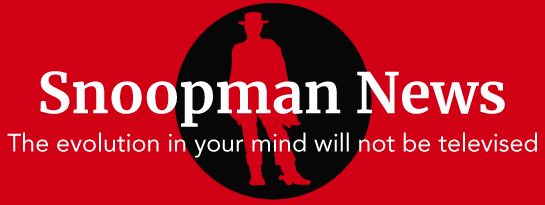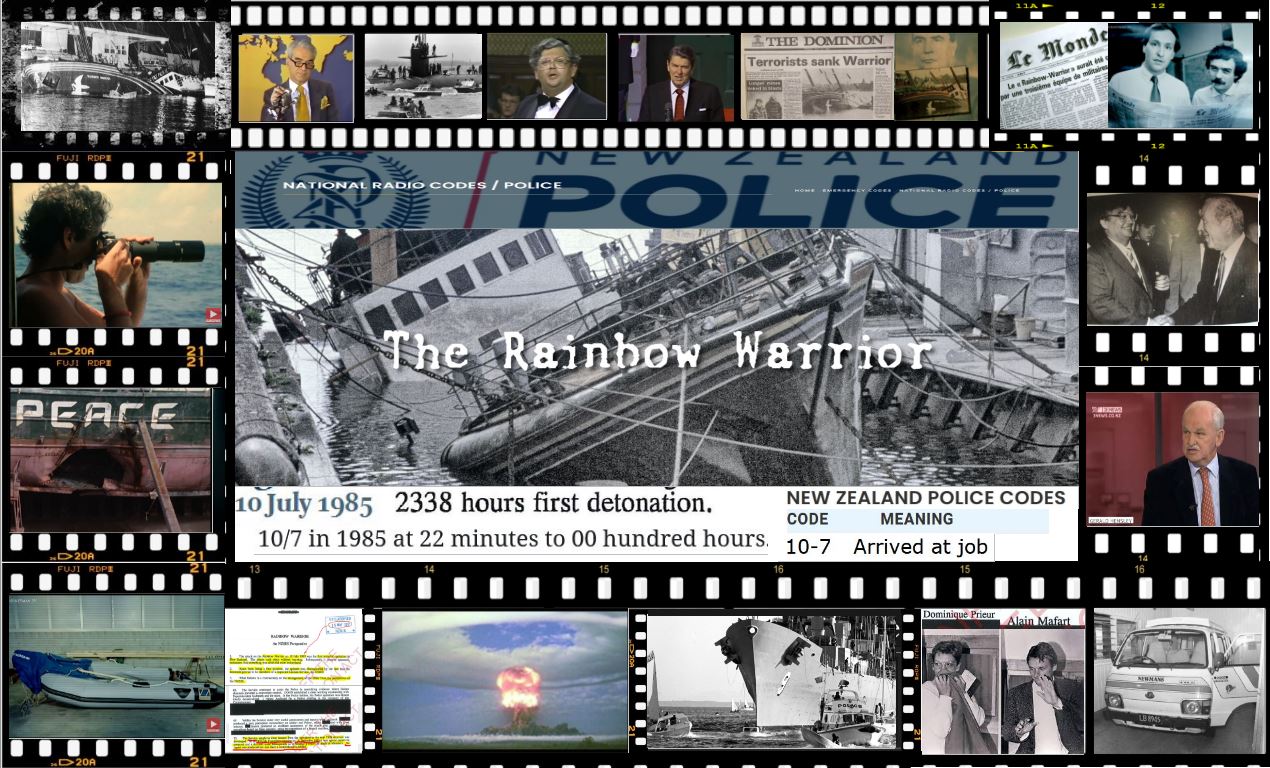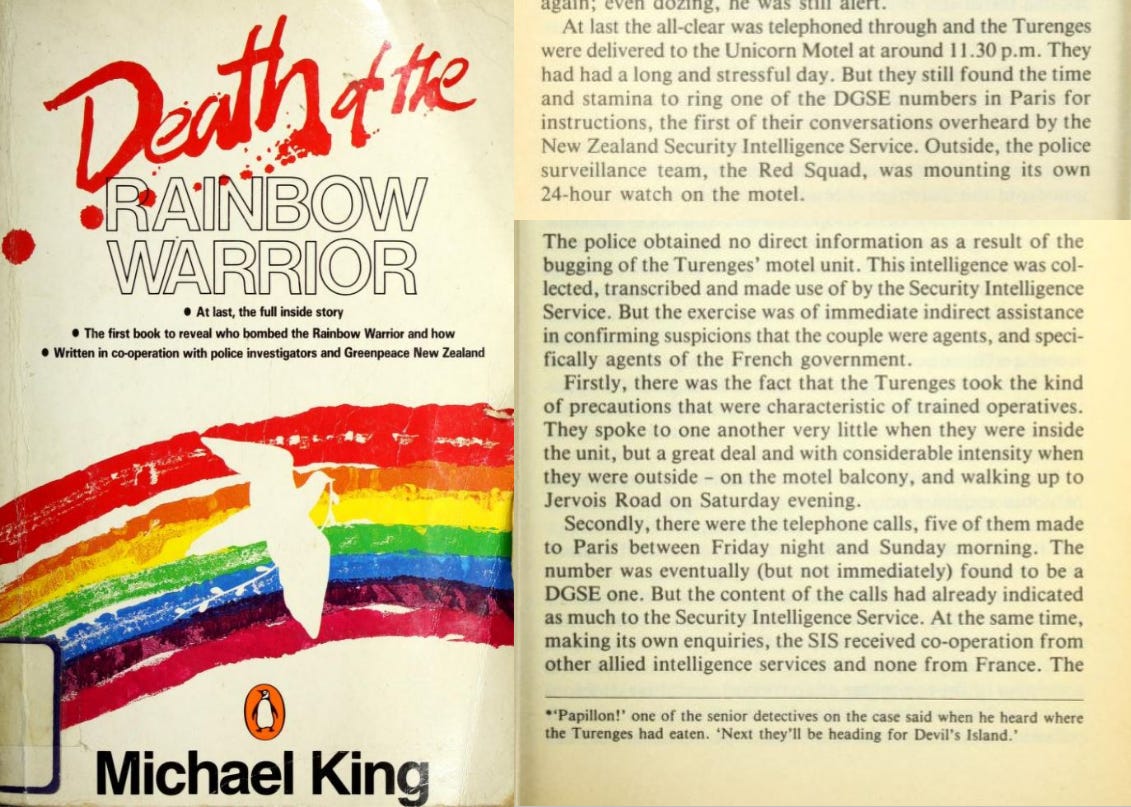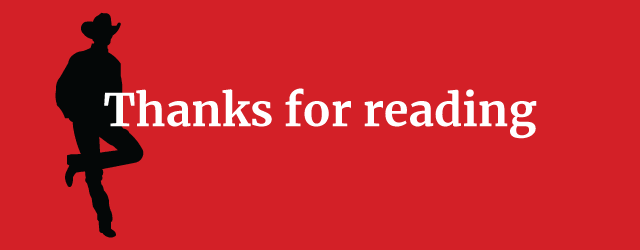Overview: The bombing of Greenpeace’s Pacific Ocean flagship, the Rainbow Warrior, in Auckland, New Zealand on July 10 1985, was inflicted to send a ‘price of power’ warning signal to the Western Empire’s ruling élites. The ‘Morse Code’ embedded in the Rainbow Warrior Bombing communicated to Western élites a sinister directive to get their domestic grassroots movements — including anti-nuclear activists — back under control.
Four Western Alliance countries — France, the Netherlands, Norway and Italy — as well as Japan and Singapore, worried that if there was not a cost inflicted on New Zealand, anti-nuclear activists elsewhere would be emboldened and their defiance might snowball into widespread rebellion.
A theatrical quality underscored three political conflicts: the U.S. nuclear powered and armed warships, the ANZUS military alliance, and the bombing of Greenpeace’s Rainbow Warrior. This theater was encoded with a ‘price of power’ theme, with an ensemble cast of characters performing to sub-plot scripts. Like all big criminal plots, not everything went according to plan. Yet, the planners ultimately got away with the perfect crime, because they still achieved their over-arching objectives by bombing Greenpeace’s seahorse, despite its symbolism-laden scripting.
Former Māori Television news and current affairs editor Steve Snoopman locates the sinking of the Rainbow Warrior within the then-secret warfare waged by all of NATO’s member nations, whose security services, or special units of the army or special police either directly or indirectly engaged in subversion, sabotage and terrorism of communist organizations, groups or characters.
According to French Army’s DGSE agents, they were told Greenpeace had been infiltrated by the KGB and was funded by the Soviet Union. This ridiculous cover story only worked because of a ‘tyranny of distance’ which in effect was the fulcrum upon which bomb plot pivoted. But this ‘tyranny of distance’ which was supposed to be weighted in France’s favour, tipped in favor of New Zealand’s Police as an ‘orgie of evidence’ indicating a ’French Connection’ occurred quicker than anticipated.
Snoopman shows the decision by France’s Minister Defence, Charles Hernu, to opt for bombing the Greenpeace ship is consistent with the findings of authors who have investigated NATO’s low grade war, which is now referred to generally as Operation Gladio. That low-grade war, which involved bombings, mass shootings and assassinations were inflicted across Western Europe and were blamed on left-wing communist groups, with idea to shift the political centre of gravity to the right, by equating peace, democracy and freedom with right wing governments associated with capitalism.
Thus, French President François Mitterrand (1981-1995) support of the mission, code-named Opération Sataniqué, was consistent with this secret war, Operation Gladio, that was waged against civilian populations. Even when Operation Gladio came to light in 1990, Mitterrand’s government denied it’s involvement. His successor Jacques Chirac maintained the code of silence.
The French were inflicting tough love to their New Zealand counterparts, who were expected to eventually work out who the culprits were, but after the DGSE had skipped the country. And Opération Sataniqué would appear to have been Mitterrand’s opportunity to signal France would once again be all-in with NATO. Mitterand led France back into NATO’s integrated military command structure, after President Charles de Gaulle had expelled NATO’s headquarters from Paris in 1966.
The 10/7 Rainbow Warrior Bombing was the catalyzing event that delivered David Lange’s Labour Party back into power two years later. Crucially, the bombing deflected the attention of left-wing activists away from the economic issues that followed the Rockefellerite-driven ‘silent coup’ of 1984, and their energy was re-focused onto the nuclear issue.
Because New Zealand had been stealthily cast as a test-lab for the infliction of Shock Doctrine economic warfare policies in a developed, Anglo-Saxon state of the Western Empire — a brutal intervention was pursued the save losing control over the far-flung South Pacific archipelago.
By Steve ‘Snoopman’ Edwards [Revised 1 August 2024]
➼ l’affaire Greenpeace
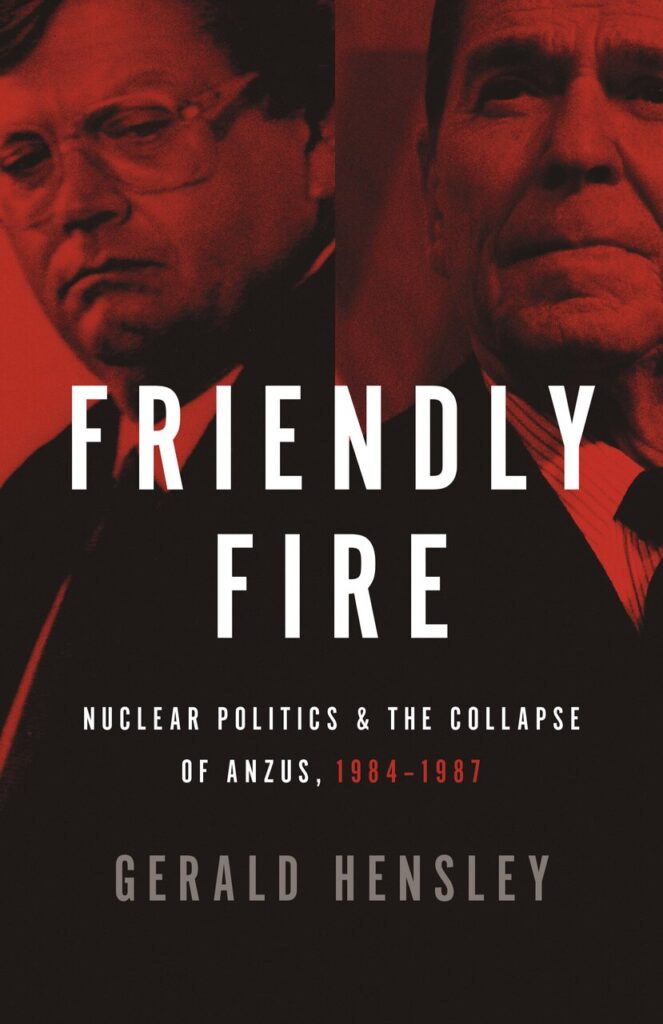
The bombing of the Greenpeace’s Pacific Ocean flagship, the Rainbow Warrior, on July 10 1985 in Auckland’s Waitemata Harbour is usually considered to have been a failed mission in state-sponsored sabotage or terrorism — because French state politicians, officials and agents were proven to be the culprits.
Two of the terrorists — Major Alain Mafart and Captain Dominique Prieur, who posed as Swiss honeymooners ‘Alain and Sophie Turenge’ — were detained near Auckland Airport on July 12 after waiting for a $130 refund on a rented Newman’s camper-van, amid news that a Police hunt was underway to catch the perpetrators.
Rainbow Warrior photographer, Fernando Pereira, drowned while retrieving his cameras when he became trapped below a collapsed stairwell after a second magnetic limpet mine, placed on the propeller turbine assembly, exploded.
However, a theatrical quality underscored three entwined political conflicts – the U.S. nuclear powered and armed warships, the ANZUS military alliance, and the bombing of Greenpeace’s Rainbow Warrior.
This theatre was encoded with a ‘price of power’ theme, with an ensemble cast of characters performing to sub-plot scripts.
Prior to the bombing, on July 9th, Mafart and Prieur transferred the explosives, diving equipment and the Zodiac to the French attack team who were staying at Hinemoa Motel, in Parakai 50km north-west of Auckland CDB. Intriguingly, the Hinemoa Motel was part-owned by New Zealand’s Prime Minister David Lange as an investment property. The subtext of this coincidence signalled that Mr Lange would have to be ‘accommodating’ of the fact that the French DGSE agents had stayed in the unit he owned three times, since he would find no allies would rebuke the French Government for the attack.
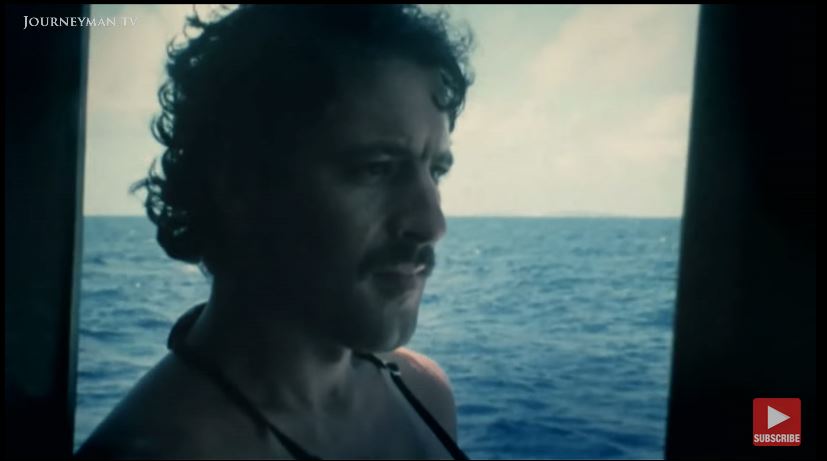
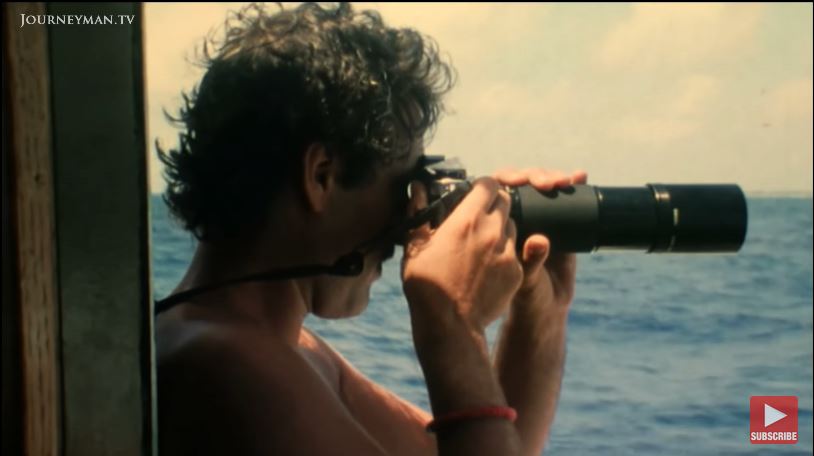
The sabotage of the 130 foot-long Rainbow Warrior, when it was moored at Marsden Wharf, ahead of Greenpeace’s planned armada to protest of an upcoming 150-kiloton French nuclear test at Moruroa Atoll in July 1985, is commonly thought to be the primary motivation for terrorist attack.
As I shall show, the Rainbow Warrior plotters’ primary objective was to send a ‘Morse Code’ signal to Western Elites about the threat posed by grass-roots movements to the Western Alliance.
Disturbingly, a secret 1996 report authored by a New Zealand Security Intelligence Service (SIS) executive, stated that as the intrigue unravelled an attitude to limit the scope of the investigation developed once Mafart and Prieur were in custody. Major Alain Mafart — who was second-in-command of the DGSE’s underwater combat school in Corsica in the early 1980s — had also trained with a British commando unit, the Special Boat Service. This critical background is crucial, because when the two accused appeared in Auckland’s High Court on November 4 1985, New Zealand’s Solicitor-General, Paul Neazor, construed the terrorism case against the two agents could not be proven. Yet, Mafart and Prieur had delivered the explosives, dive gear and zodiac brough into New Zealand by the DGSE’s Ouvéa yacht crew, and the accused made transfer to the bomb team at Hinemoa Motel. Neazor performed damage control.
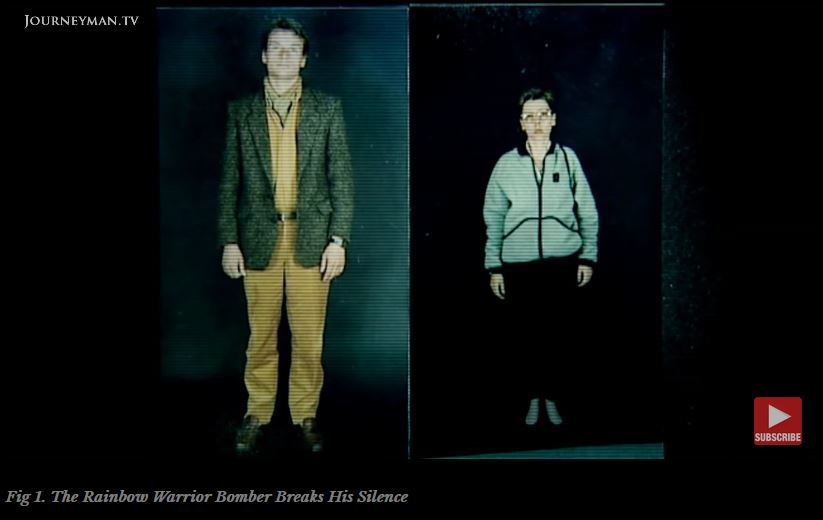
The SIS executive, who represented the NZ Security Intelligence Service at the meetings, said the Officials Terrorism Committee decided to merely to seek their prosecution, rather than coordinate efforts to uncover the dimensions of the attack to catch other DGSE agents in New Zealand, as well as probe the extent of the French state’s involvement.
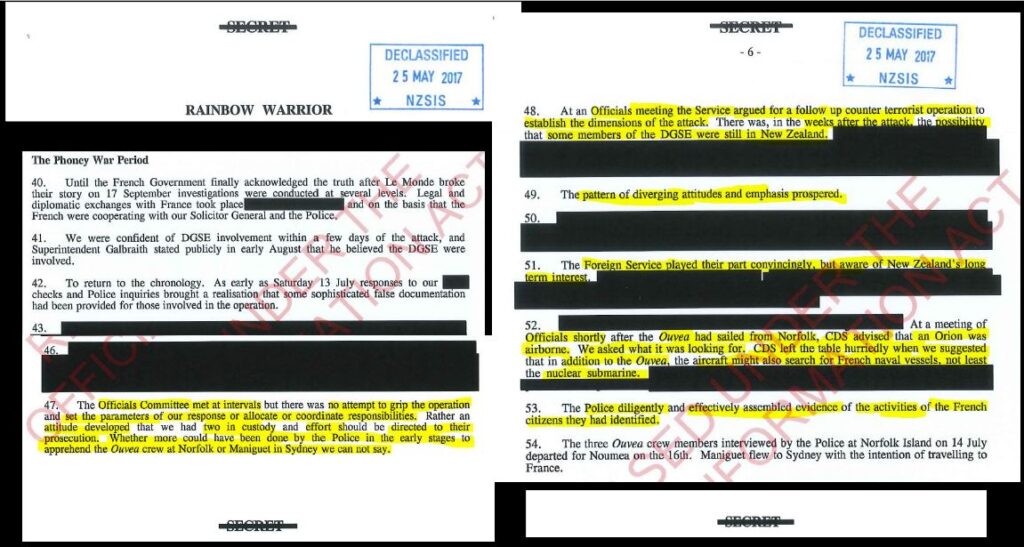
Because — the mission went awry when two French DGSE agents were caught, the chairman of New Zealand’s Intelligence Council, Gerald Hensley, who also just happened to be the Chairman of the Officials Terrorism Committee, was very accommodating to constrain the scope of the investigation. Such constraint meant the DGSE combat dive team were able to ski at Mt Cook/Aoraki, and fly out of Auckland on July 26th 1985, without the SIS, the Police or the Aviation Security Service catching them in spite of the PM’s assurance that no effort would be spared.
The entire Labour Government were captured through compromise, and essentially became political puppets.
The bombing of Greenpeace’s Pacific Ocean flagship, the Rainbow Warrior, on July 10 1985 in Auckland’s Waitemata Harbour was the catalyzing event that delivered David Lange’s Labour Party back into power two years later — as former head of the Prime Minister’s Department, Gerald Hensley stated in his book, Friendly Fire: Nuclear Politics and the Collapse of Anzus, 1984-1987.
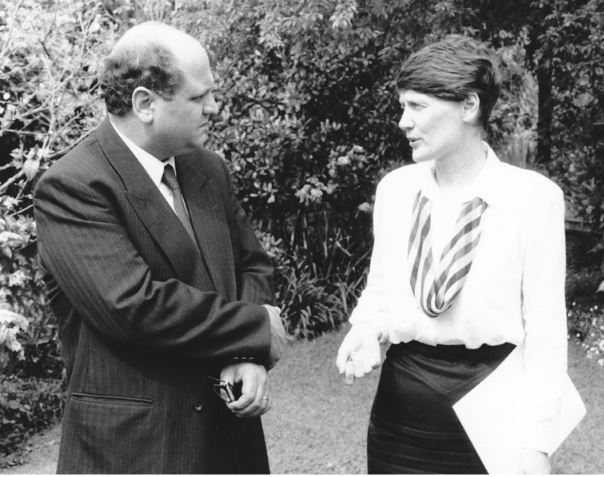
The Rainbow Warrior Bombing gifted New Zealand’s Prime Minister, David Lange, a cause célèbre to win the 1987 election, which he otherwise would have lost because a right-wing faction in his cabinet had inflicted economic warfare to consolidate a pre-planned corporate heist of the economy. The bombing of Greenpeace’s flagship Pacific seahorse saved the Lange Government from losing the 1987 election by distracting his Labour Party’s anti-nuclear faction with this cause célèbre.
This act of terrorism, which was embedded with an ‘orgie of evidence’ designed to signal French Deep State-sponsorship, drew attention away from the economic issues inflicted by Neo-Feudal Capitalists.
A political-financial coup had occurred during New Zealand’s 1984 General Election that embroiled the citizenry in the economic warfare framework. The Lange Government’s Shock Doctrine economic warfare programs lifted restrictions on the finance sector, which caused mass business closures amid high interest rates, while deep cuts to farm subsidies were inflicted, and import tariffs were removed, which wreaked havoc on manufacturing.
This reset of the New Zealand economy included a long-planned component to corporatize the public sector in preparation for privatization, which would involve mass lay-offs from the state’s public services, and commercial trading entities including its utilities. New Zealand’s crucial role was to be a test-lab for the infliction of the Shock Doctrine economic warfare in a developed, English speaking state of the Western Empire — without a shot being fired.
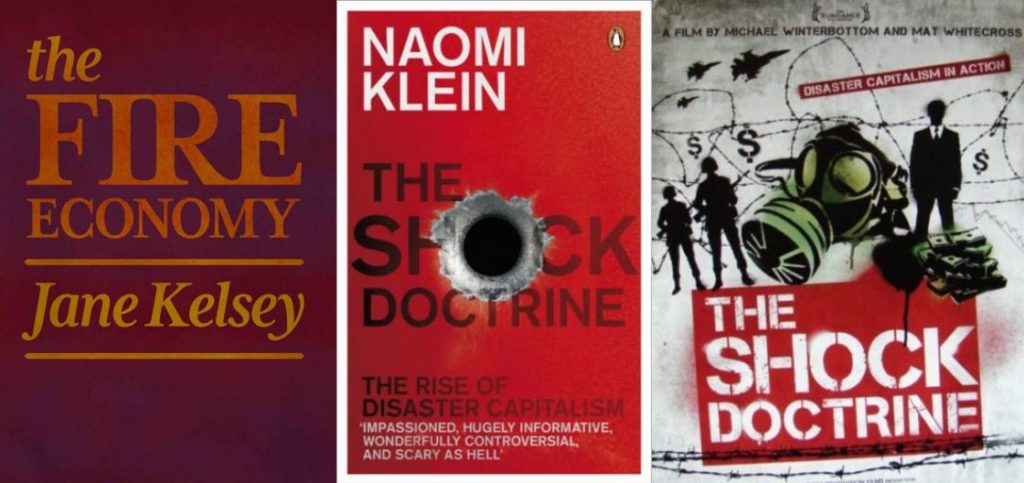
France viewed a planned flotilla to protest the upcoming French nuclear bombs tests at Mururoa Atoll as a threat. The Rainbow Warrior was to be a flotilla ‘mothership’, and with a recent refit — complete with sails, and radio broadcast equipment that could transmit photographs — the 130-ft, 417 tonne converted cod trawler could be at sea for months. The issues that the French state had with the impending flotilla — and the publicity it would draw — were a challenge, but secondary to the needs of the Atlantic Alliance.
The challenges for the French state were factional tensions with the intelligence, defence and politics because the Government of President François Mitterrand (1981-1995) was of a socialist brand.
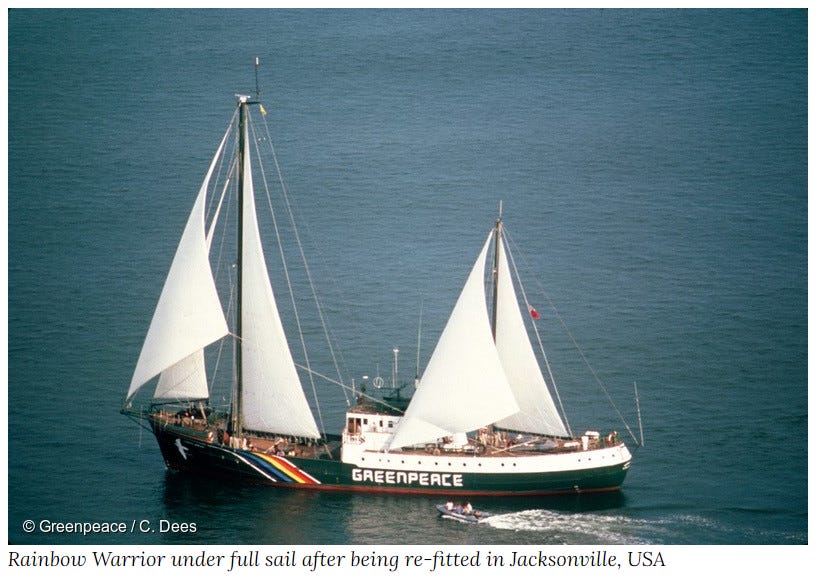
However, this socialism brand did not even penetrate Mitterrand’s skin, while his political personality was fluid and his pre-World War II schooling in a “nursery of political parties that skidded to a halt a hairsbreadth short of full-blown fascism” — according to Richard Cottrell, the author of Gladio: NATO’s Dagger at the Heart of Europe.
Ironically, NATO’s website sanitizes the schism that led Mitterrand’s long-time political rival, Charles de Gaulle, to assert France’s military autonomy in a series of chess moves that culminated the North Atlantic military alliance’s headquarters being expelled from France in 1966. President de Gaulle advanced the development of French-manufactured nuclear weapons. On de Daulle’s watch, France’s first test at Mururoa was conducted on July 2 1966; and when it quit testing in 1996, it had clocked up 193 blasts at Mururoa and Fangataufa atolls.
According to the gospel of NATO, it was Mitterrand who initiated France’s waltz back into NATO’s integrated military command structure during the late 1980s and 1990s. Mitterrand’s successor, President Jacques Chirac, continued this course back into the unholy embrace of the North Atlantic Treaty Organization, and by 2009, France was fully re-integrated back into NATO’s military command structure.

Furthermore, the issue of U.S. nuclear power and armed warships entering New Zealand territorial waters was a hot political topic in New Zealand for many years and came to a head in 1985 when it clashed with what a nuclear-free New Zealand would mean for the ANZUS military alliance between Australia, New Zealand and the United States.
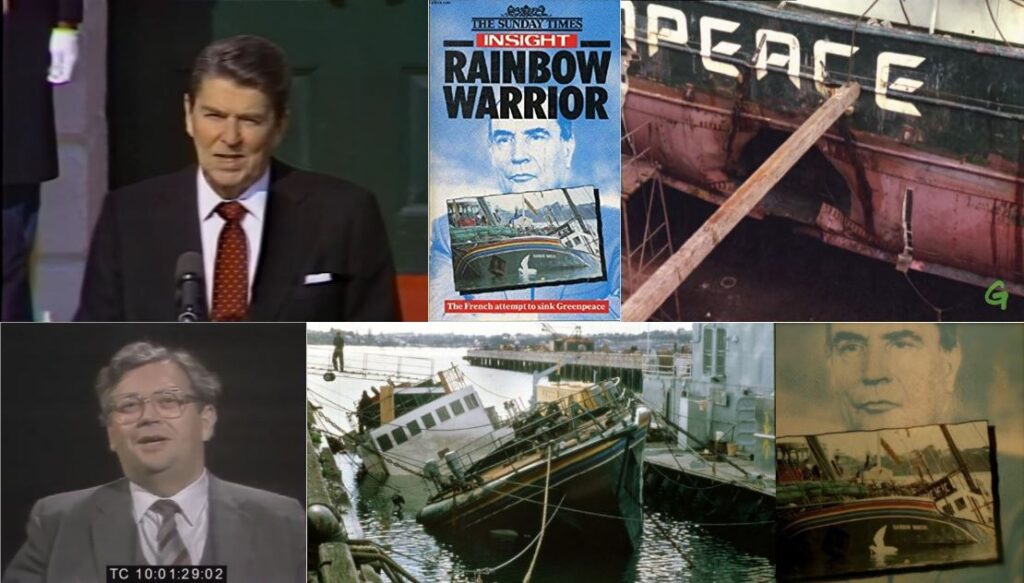
New Zealand’s Government faced a dilemma.
Prime Minister David Lange’s Labour party had been elected with a nuclear-free New Zealand policy platform while remaining in ANZUS, amid a strong anti-nuclear movement that campaigned to ban U.S. nuclear powered and armed vessels. Well-organized protests against visits by U.S. warships — such as Texas (1983), Truxtun (1976) and Long Beach (1976) and the submarines, Haddo (1979) and Pintado (1978) — to New Zealand had drawn much media attention, while Robert Muldoon rode the waves of discontent.
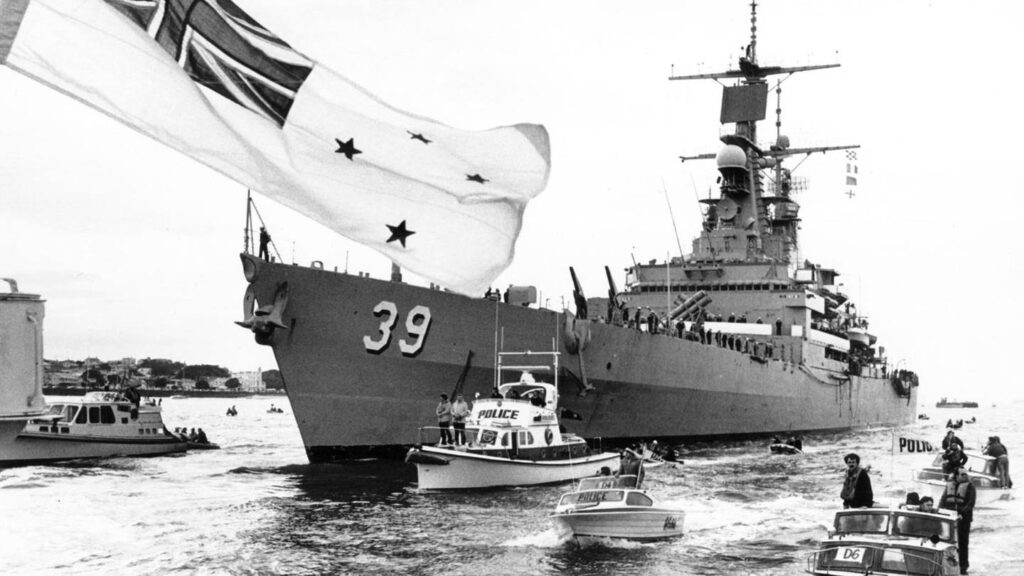
This sustained defiance to the core state of the Western Empire was also an affront to the military-backing of U.S. currency, which is controlled by the privately-owned Federal Reserve banking cartel, whose major stock-holders are the dynastic banking families of North America and Western Europe.
If this defiance were not addressed, the capacity for the US-NATO Military Empire to inflict coups d’état, assassinations, and terrorism, as well as wars, as coercive mechanisms to impose regimes friendly to ‘Western interests’ would be diminished. In turn, the efficacy of the privately-owned Fed Credit-Dollar as an imperial instrument of expansion to buy-up the world’s resources, infrastructure and enterprises would be questioned in financial markets.
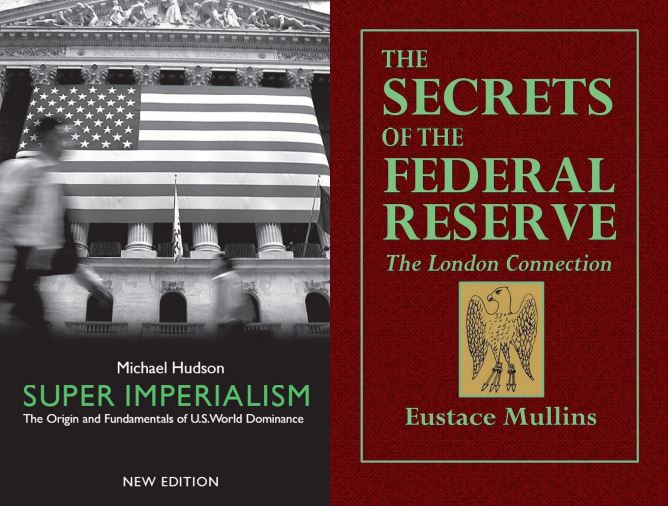
More pointedly, four other Western Alliance countries also faced similar problems with defiant anti-nuclear activists. France, the Netherlands, Norway and Italy — as well as Japan and Singapore — had told the U.S. State Department that they did not want New Zealand thrown out of the Western Alliance because they envisaged they could be forced into a similar dilemma by their own citizenries. They also worried that if there was not some sort of cost inflicted on New Zealand, anti-nuclear activists in other countries would be emboldened — as Hensley stated in Friendly Fire.
At the time of the Rainbow Warrior Bombing, the nuclear warships and submarines issue and the ANZUS Alliance appeared to have reached a stalemate. Ironically, Ramesh Thakur observed in his paper, “Creation of the Nuclear-Free New Zealand Myth: Brinkmanship without a Brink”, the U.S. Government had previously tolerated the nuclear-free policy of the third Labour Government (1972-75) and also of NATO Ally, Denmark, at the time of his writing in 1989.
Furthermore, in his 1995 Pacific Affairs paper, “Healing the American Rift with New Zealand”, James McCormick noted “[t]he United States has long tolerated a dual track policy toward France and NATO”, whereby there was a policy of closer political cooperation between the two countries, even as the security relationship remained fissured. A rupture had occurred between France and the United States, following the expulsion of NATO’s headquarters from Paris in 1966, after French President Charles de Gaulle (1958-1967) finally had enough of the attempted coups, assassination plots and other destabilizing machinations that were inspired by an anti-Gaullist mindset that penetrated the fascist wings of the CIA, the Pentagon and NATO.
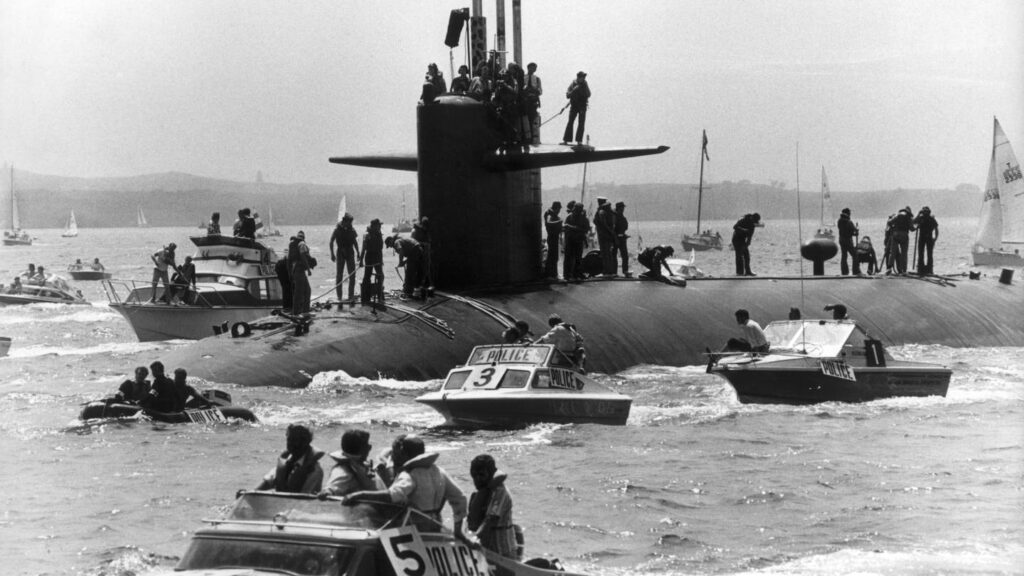
Ironically, the ‘de Gaulle brand’ had been clumsily promoted by the Nazi-friendly Vichy Regime, after Germany’s tank corps rolled into France in May 1940. In exile in London, Brigadier-General de Gaulle made two speeches on the BBC, calling on his countrymen to fight for a Free France, which drew the ire of the Nazi’s puppet government in France. The brigadier-general was officially stripped of his rank, and made the target of a hate campaign, which only added to his status.
The irony deepens, when one reads on the DGSE’s history page that General de Gaulle saw the need to create an intelligence service capable of carrying out clandestine operations — in the month following the Nazi invasion of France — that could coordinate the efforts of the various factions of the French Resistance into cohesive networks. General de Gaulle, who sensed that France’s political leadership lacked a republican backbone, called this fledgling intelligence organization ‘Free France’, which became the Central Bureau for Intelligence and Action (BCRA) in 1942. The “DGSE is heir to the BCRA”, notes Direction Générale de la Sé-curité Extérieure of its origins.

As Cottrell recounts in GLADIO: NATO’s Dagger at the Heart of Europe, General de Gaulle was the architect of the constitution that forged the Fifth Republic, established on October 4 1958. However, de Gaulle endured a handful of coup attempts, over two dozen failed assassination plots and others machinations to de-stabilize his leadership and the Fifth Republic. Ironically, some of the players involved were drawn from a secret paramilitary network, initially called Plan Bleu (Blue Plan), established on General de Gaulle’s orders, Cottrell claims, after France was liberated with the execution of Operation Overlord at Normandy in June 1944.
In his book, NATO’s Secret Armies: Operation Gladio and Terrorism in Western Europe, Swiss historian Daniel Ganser asserts that Plan Bleu was established as an initiative of U.S. and British special forces, to prevent the French Communist Party (PCF) from gaining power, meaning Plan Blue was about preventing France from turning red. Once NATO was established in 1949, Plan Bleu came under the supervision of this North Atlantic military alliance, as well as France’s secret service that were connected to far-right fascist elements who hated de Gaulle. More broadly, Ganser identified that the purpose of stay behind armies had a dual purpose: (1) to act as a counter-force to sabotage any Soviet invasion; and (2) subversion of communist parties, groups or dissidents. NATO’s secret armies resorted to terrorism.
The intelligence agency of the Free French Forces, Charles de Gaulle’s French government-in-exile in London became the Direction Générale des études et Recherches (General Directorate for Studies and Research, DGER) in 1944, which was a division of the Bureau Central de Renseignements et d’Action (BCRA). After de Gaulle resigned as Prime Minister in January 1946, the DGER was replaced in April 1946 with the Service de Documentation Extérieure et de Contre-Espionnage (SDECE), which was staunchly anti-communist. The SDECE was the forerunner to the DGSE.
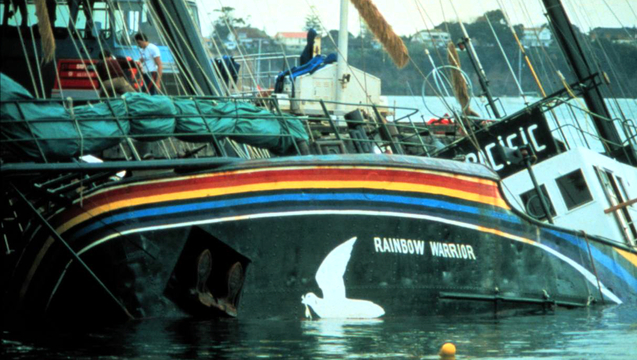
The DGSE’s combat dive team leader, Colonel Jean-Luc Kister, who set the two bombs to the Rainbow Warrior’s hull, revealed on TVNZ Sunday program in 2015 that he was told the justification for the mission was that Greenpeace New Zealand had been infiltrated by the KGB. In the three-part documentary series, Murder in the Pacific, Colonel Jean-Luc Kister, also said they were told Greenpeace was funded by the Soviet Union.
Therefore, Opération Sataniqué was a strange variant of Operation Gladio.
In other words, Colonel Kister evidently fell for what would be a cover-story; that the environmental and peace activist organization had been penetrated by totalitarian ‘far-left’ commie spies from Soviet Russia.

Following the Rainbow Warrior Bombing, the rift over U.S. nuclear power and armed warships and submarines entering New Zealand territorial waters widened into a chasm and in 1986, New Zealand was ejected from the military security pact. Attitudes about a nuclear-free New Zealand hardened, and resulted in the end of military exercises between New Zealand and the United States until 2010.
However, with the Lange Government’s election win in 1987, N.Z.’s National Security State also consolidated power.
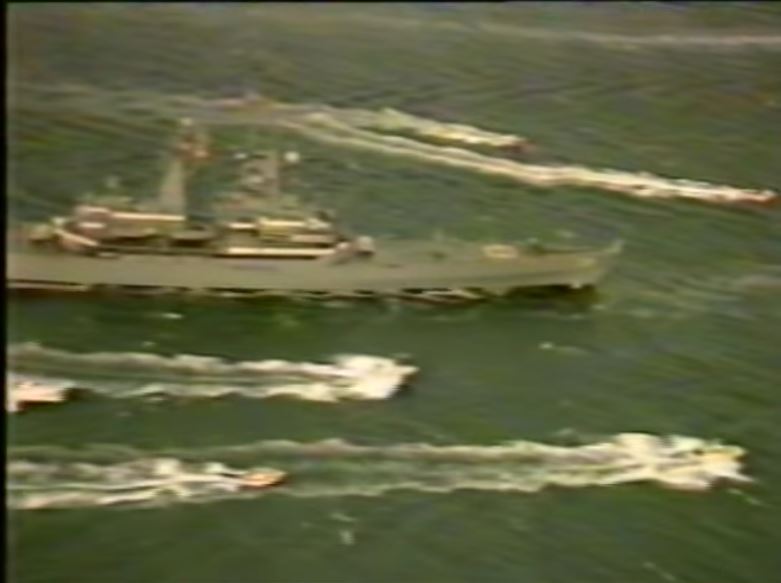
Crucially, the Government Communications Security Bureau (GCSB) gained a new spy base at Waihopai, that would spy on the South Pacific. When Lange announced this development December 2nd 1987, ten days before the Rainbow Warrior was scuttled at Matauri Bay, Northland, the re-elected Prime Minister peddled the fiction that the satellite interception facility was needed for New Zealand’s security independence, amid the nation’s split with the United States in the ANZUS military alliance.
The official story of ‘l’affaire Greenpeace is that in late 1984, a furious Charles Hernu, France’s Defence Minister, learned from the director of the Mururoa’s Nuclear test centre and chief of South Pacific French Fleet, Admiral Henri Fages, that Greenpeace planned an armada to protest an upcoming 150-kiloton French nuclear test at Moruroa Atoll. A comprehensive dossier was presented to the French Defence Minister in January 1985. The timing of the dossier of Greenpeace’s planned expedition to Mururoa Atoll roughly coincided with the United States request to the New Zealand Government to permit the USS Buchanan visit.
Lange had sent Chief of Defence Force, Air Marshal Sir Ewan Jamieson, to Honolulu to choose the actual ship with the U.S. Pacific Command and Air Marshal Jamieson settled on USS Buchanan. This near-obsolete destroyer was subsequently decommissioned in 1991, and while capable of carrying nuclear weapons, almost certainly would not have been, and had recently visited japan, where there was also a strong anti-nuclear movement. A key political player in the Labour Party’s anti-nuclear faction was future Prime Minister, Helen Clark, who pushed for shutting out American ship visits while Lange was in Tokelau in January 1985. When Lange returned, his Cabinet rejected the move to allow USS Buchanan visit.
Consequently, New Zealand had sent a rejection letter regarding a visit of the USS Buchanan on February 4th 1985, which in Washington political circles is a potent date. Every year on February 4, a National Prayer Breakfast convention is run by The Fellowship, also known as The Family, which is a syndicate that uses the cover of Christianity as a global political and economic network to penetrate the power structures to advance the interests of the Western Empire.

Deciphering the ‘morse code’ in this terror event, a clear message was signalled to the political élites of the Western Alliance to get their anti-nuclear activists under control, or there would be stiff prices to pay if such threats to the political stability of the Western Empire Syndicate were not more tightly constrained.
Intriguingly, in an early 1985 press conference, one U.S. State Department Official emphasized there would be costs in the courses pursued by citizen movements deemed a threat to the Western Alliance. The U.S. Official said:
“Some Western countries have anti-nuclear and other movements that seek to diminish defense cooperation among the allied states. We would hope that our response to New Zealand would signal that the course these movements advocate would not be cost free.”
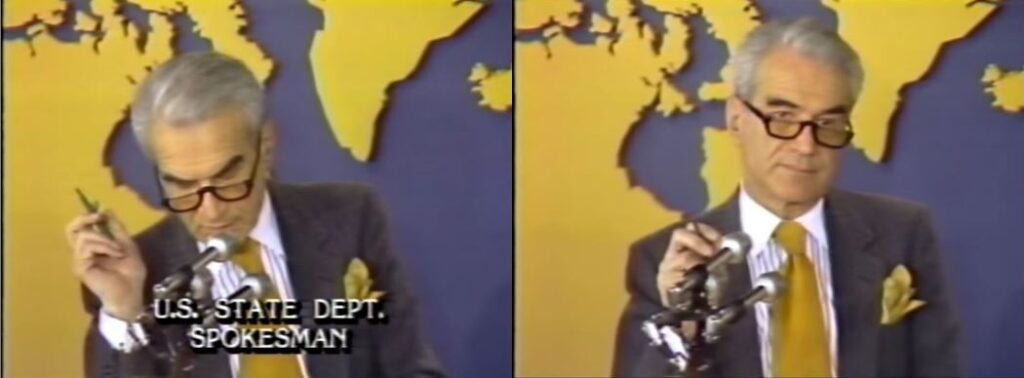
As we shall see, the cost component turns out to be a deeply symbolic element in the Rainbow Warrior ‘affair’ where deep politics operates in a parallel universe and in accordance with game theory.
To this sinister end, the plot to bomb Greenpeace’s flagship Pacific seahorse was designed to achieve geo-political objectives, while appearing to be merely a sabotage mission to prevent the Rainbow Warrior acting as a supply ship in an upcoming flotilla to protest a French nuclear bomb test at Mururoa.
The sinister, yet corny plot came packaged with the French national security state’s metaphor-laden clues, that were intended to be discovered and deciphered when it was too late to capture the French secret service agents. But the mission operatives also improvised mischief designed to draw investigators down blind alleys of French tourists in the far north, to buy time for the DGSE operatives time to go to ground, or skip the country. Some clues were unintended. As the agents themselves have admitted in subsequent interviews, the DGSE didn’t anticipate the vigilant observations of New Zealanders.
Like all big criminal plots, not everything went according to plan in Opération Sataniqué, the strange mission code-name designated by Direction Générale de la Sé-curité Extérieure (DGSE), the French equivalent of a neutered CIA. In such circumstances, where the best laid plans of mice, men and rabbits go awry, such ‘deep state bunnies’ can be expected to shit themselves, and leave a trail of ‘rabbit droppings’ that lead to their ‘rabbit holes’, and down into the Deep States’ ‘rabbit warrens’.

Once France’s surface alibi — that their intelligence agents were merely gathering information on Greenpeace — had collapsed, the French Government’s claimed that the bombing was merely a sabotage mission.
However, the logic underpinning the purpose to leaving so many clues unravels when the meta-data, subsequent interviews and the geo-political context in the political conflicts over U.S. nuclear powered and armed warships, the ANZUS military alliance, and the bombing of Greenpeace’s Rainbow Warrior are re-examined.
With this context laid bare, this investigation shows the Rainbow Warrior Bombing worked as a Deus Ex Machina plot device that resolved a seemingly impossible political check-mate position, whose narrative roots extended back to the 1970s.
Derived from Greek and Roman theater, a Deus Ex Machina (or god from the machine) is a plot device that unexpectedly resolves a deadlocked conflict, by the sudden appearance of an implausible character, object, event, power, or action.

➼ ‘Price of Power’ Themed-Political Theater
The three political conflicts — over U.S. nuclear powered and armed warships, the ANZUS military alliance, and the bombing of Greenpeace’s Rainbow Warrior — all possessed a theatrical quality, including the names in an ensemble cast of characters. This theater was encoded with a ‘price of power’ theme like they had been scripted to cast spells over the näive mass news audiences of New Zealand.
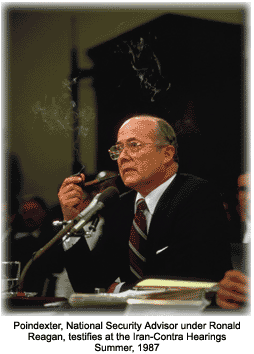
For example, when the U.S. Deputy Secretary of the National Security Council Admiral John Poindextor met with Gerald Hensley in late February 1985, he was riffing off his family name, which denotes a boringly studious and socially inept person, since Poindextor took copious notes at this meeting in the basement of the White House.
Yet, Admiral Poindextor, who had been a commander of battle groups in the Western Pacific Ocean, and had also led the weapons transfers to Iran in the Iran-Contra Affair, and oversaw people such as Lieutenant-Colonel Oliver North.
In Friendly Fire, Hensley neglected to mention that Poindexter was responsible for leading and managing the National Security Council staff as chairman of the Crisis Pre-Planning Group from 1983 to 1985. Tellingly, since he was chairman of the Crisis Pre-Planning Group, Admiral Poindextor emphasized the need for careful risk management and said President Reagan did not want to go down in history for having ‘lost New Zealand’.
A few days prior to Lange’s landing in Los Angeles, en-route to the City of Oxford, England, to debate the nuclear issue at Oxford Union on March 1st 1985, Hensley met with the Under Secretary of State for Political Affairs, Michael Armacost. Hensley said that the U.S. would have to step very carefully. Armacost evidently retorted the U.S. wasn’t the one who was filing for divorce “Hell, we’re being told we can’t even come into the bedroom anymore”.
Evidently, the U.S. was a friend with benefits and when its ‘political affairs’ with other nation state bed-partners was challenged by a muster of anti-nuke protestors, the appearance of those benefits had to be seen to be withdrawn while the eye on the bigger prize remained fixed.
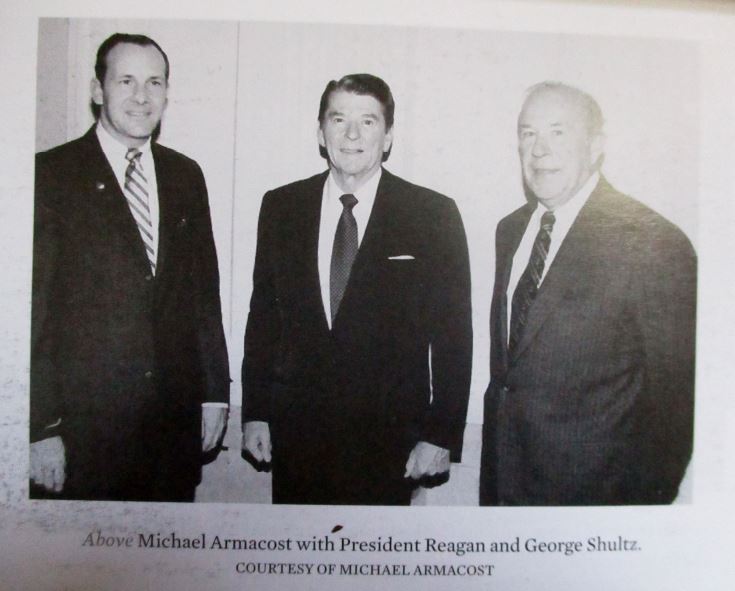
Even before New Zealand had sent its rejection letter on February 4th 1985 regarding a visit of the USS Buchanan, a guided missile destroyer from Pearl Harbor, Senator Cohen of Maine wrote in a January 31 letter to Republican President Ronald Reagan expressing that the response should not be ‘delicate and diplomatic’. Senator Cohen, who later became President Clinton’s Defense Secretary, sponsored a resolution in the Republican-dominated Senate that attracted majority support, while the House appeared to bend to pressure from industry lobbyists, with noises from politicians’ mouths garbling rhetoric about boycotting meat, dairy and wool. Republic Congressman Dick Cheney even introduced a bill to ban New Zealand and Australian products (including uranium), but his motion appeared to be theater too, since he said the Bill was “a statement in itself” and he would not take the matter further.
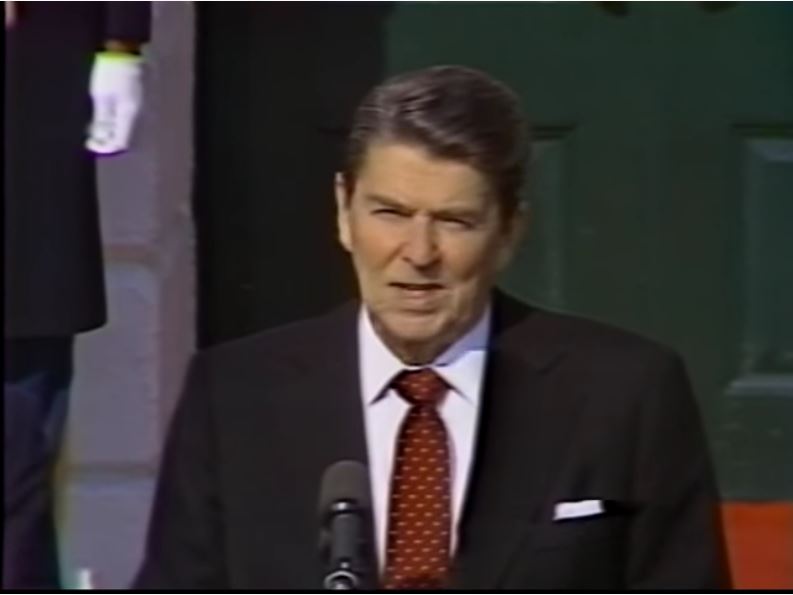
When Lange reached Los Angeles on February 26th, the Under Secretary of State for Political Affairs, Bill Brown, presented a narrative for the ex-communication at the Consul-General’s home in Brentwood, Los Angeles.
Brown, whose manner was evidently ecclesiastical, stated Lange had led the U.S. to believe seven months prior that he would work domestically to shift party and public attitudes regarding vessel visits. The timing and choice of the ship to visit had been chosen by N.Z. officials, and yet the N.Z. Government had rejected this contrived invitation.
And, apparently, the United States had been deeply hurt by this rejection. Consequently, there had to be consequences. Lange had asked for a copy of the list of the new military, intelligence and diplomatic terms, but this was denied. This refusal by a U.S. official to supply New Zealand’s Prime Minister with a copy of an official document between to nation states, reveals the political theatrics. The intended effect during this 50-minute meeting was to transform it into a political science lecture, there humiliating New Zealand’s Prime Minister who rather like a student, took notes.
The ‘price of power’ theatrics continued after the Excommunication Ritual.
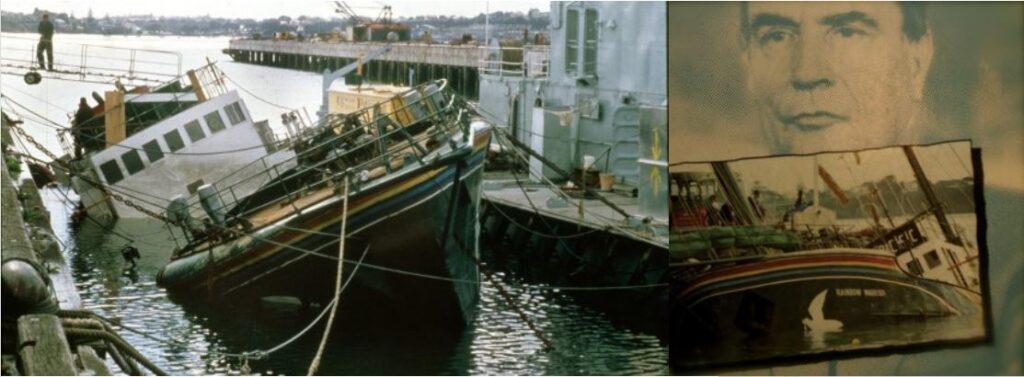
After the delivery of the new military, intelligence and diplomatic terms, the New Zealand delegation found Bill Brown and Jon Glassman from the State Department standing on pavement outside Consul General Peter Heenan’s house waiting for a taxi. As Hensley recalled, “the artificiality of the excommunication” was underscored by the amicable conversation they had with the American officials, whom accepted their invitation to ride in transport back to town. The meta-data of two state department officials from one of the world’s two superpowers standing on a pavement without transport was another codified communication for insiders to decipher: ritual theater with a budget theme.
Lange and his entourage were driven into the underground garage at the Ambassador Hotel. The security detail assigned to Lange insisted the Prime Minister and his team be taken through the hotel kitchen where Robert F. Kennedy was assassinated. Hensley recalled Lange’s nervous jocularity, and that years later Lange confided that the hair on the back of his neck had risen in alarm. By leading the Prime Minister through the hotel kitchen where Robert F. Kennedy was assassinated before he made a speech, the implied threat communicated that serious deviations from the script would be punished with severity.
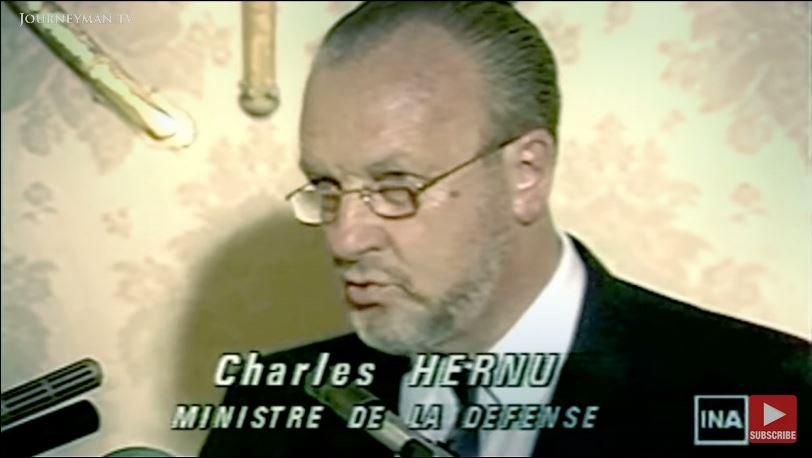
Across the Atlantic, at the end of March 1985, France’s Defence Minister Charles Hernu considered a range of security threat assessments and green-lighted one from the French Secret Service, evidently on the basis of price. Hernu instructed the DGSE Agency to set up the mission, and the DGSE immediately requested three million French Francs and this request was swiftly forwarded to the presidential palace, Élysée.
These synchronized moves were consistent with game theory, which was developed during the Cold War to stabilize the power structures of the Russia Empire and the Western Empire. In their paper, “Resolving social conflicts through hostage posting: theoretical and empirical considerations,” Gideon Keren and Werner Raub noted that “tacit communications of threats and promises are two major message strategies used to influence the behaviours of others”.
The supposition explored here is that in timing the “sabotage mission” to occur on 10/7 in 1985, the bomb plot planners wittingly embedded the Rainbow Warrior Bombing with the numeric call sign 10/7 used by New Zealand Police to communicate “unit arrived at job” over emergency radio frequencies.
By timing the attack to occur on 10/7/1985, it would appear that the French were riffing off New Zealand Police alphanumeric code, 10/7, for ‘unit arrived at job’ to signal that international terrorism had arrived in New Zealand.

➼ The Mystery of the Half-Sunk ‘Trojan Seahorse’
In the curious case of the half-sunk seahorse, the DGSE agents involved in the operation claimed they intended to mitigate deaths, by setting two bombs to go off four minutes apart.
However, the first bomb — which blew a large hole in the hull where the engine room was located and caused the ship’s lower decks to rapidly fill with seawater — occurred with no warning.
It was pure chance that many more did not perish, since there had been a birthday party aboard that evening. Fortunately, most had left for the Piha base-camp of the pop-band, Split Enz, whose members had been invited to visit the Rainbow Warrior that evening, but the musicians did not attend.

Rainbow Warrior photographer, Fernando Pereira, drowned while retrieving his cameras when he became trapped in his room below a collapsed stairwell after a second plastic explosives bomb — that was placed on the keel — exploded four minutes later.
The placement of this second bomb on the propeller turbine assembly was intended to damage the ship beyond economically viable repair. At the end of their 1986 book, Rainbow Warrior: The French Attempt to Sink Greenpeace, London’s Sunday Times journalists noted the irony that Perieria was probably the only Greenpeace crew member who instantly recognized the deep thudding sound. Pereira was found with one his cameras already slung around his neck.
As former academic journalist and Opération Sataniqué survivor of the attack, David Robie, stated in a 2016 article, “The Rainbow Warrior, secrecy and state terrorism”, a myth had persisted in the South Pacific archipelago. This myth held that it was the New Zealand media whom broke the story of French secret service involvement with the green-light from the highest government levels of President Mitterrand’s Administration. However, it was the work of a Le Monde police beat journalist, Edwy Plenel, and his colleague, Bertrand Le Gendre, whose efforts revealed there was a ‘third team‘, a French DGSE dive team.
The Le Monde front page scoop of September 17 1985 caused the Prime Minister to admit the French Government was behind the bomb plot. Le Monde subsequently named “Jean-Luc K” only in August 1986, then “Jean-Luc Kyster” (with an incorrect spelling) only in September 1987.
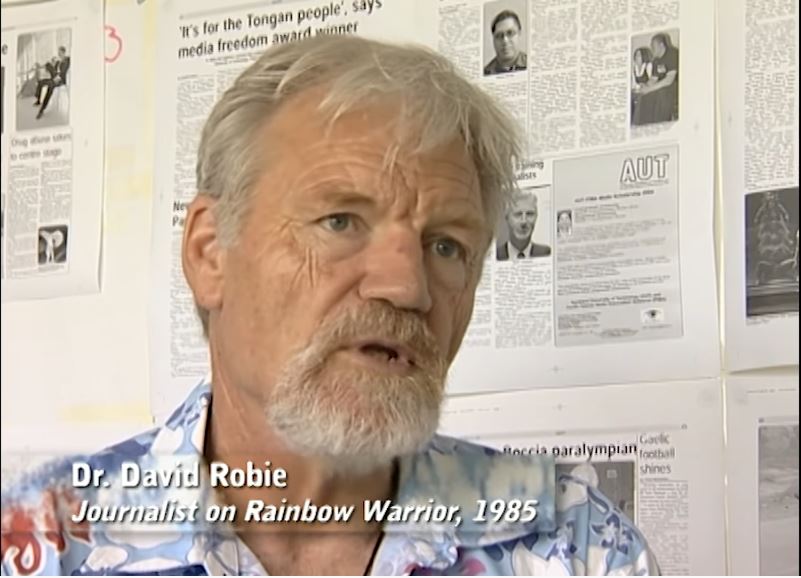
Robie reminded his audience that it was the:
“dogged investigation by a police reporter on Le Monde which revealed the existence of a ‘third team’ in the sabotage scenario, the actual bombers, and laid the evidence to the front door of the Élysée Palace in a front page scoop for his newspaper. The background to journalist Edwy Plenel’s revelations was published in his book La Troisième Équipe—Souvenirs de l’Affaire Greenpeace, published in 2015 to mark the thirtieth anniversary. Plenel also unmasked the real identities of the two agents who had planted the bombs, Colonel Jean-Luc Kister and Jean Camas, during his 2015 investigation.”
However, Edwy Penel stated that he didn’t reveal the identities of two others in the dive team, Jean Camas and Captain Gérard Royal, in his book, Third Team — Memories of the Greenpeace Affair; a fact which surprised TVNZ producer Chris Cooke when he had the former Le Monde police reporter’s book translated into English.
Yet, The New Zealand Herald’s “30 Years On” feature in 2015 reported on who comprised the attack dive team, among the other named ‘saboteurs’.
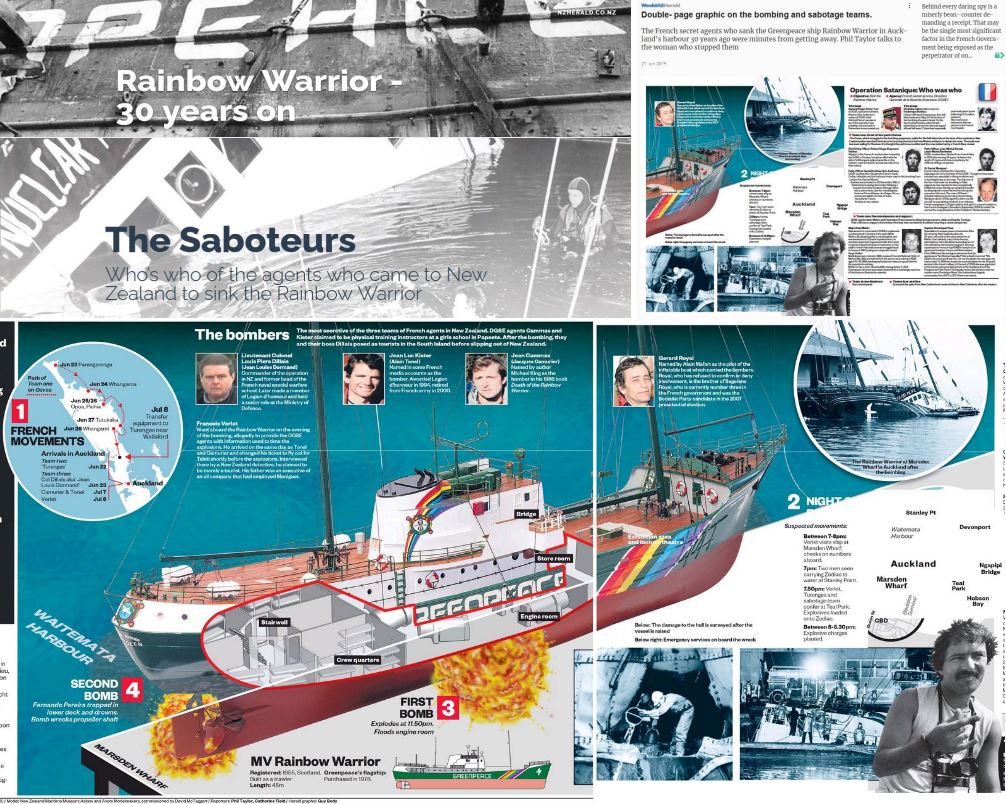
Despite the New Zealand Herald taking until the 30 anniversary to name the 13 French DGSE agents, the French newspaper Libération had named Captain Jean-Luc Kister (alias Alain Tonel) and [Jean] Camas (alias Jacques Camurier), as the bomb installers on the “destruction team” 20 years prior — in 1995.
In his article, “The background of the ‘Satanic’ operation — How the DGSE prepared the sabotage of the Rainbow Warrior”, French journalist Jean Guisnel reported that there were six teams, rather than just three. There were also at least a dozen others, known as “honorable correspondents” who assisted the Action Service with its logistics, mainly in New Caledonia, Tahiti and New Zealand. In other words, there were seven groups, totalling more than two dozen French agents.
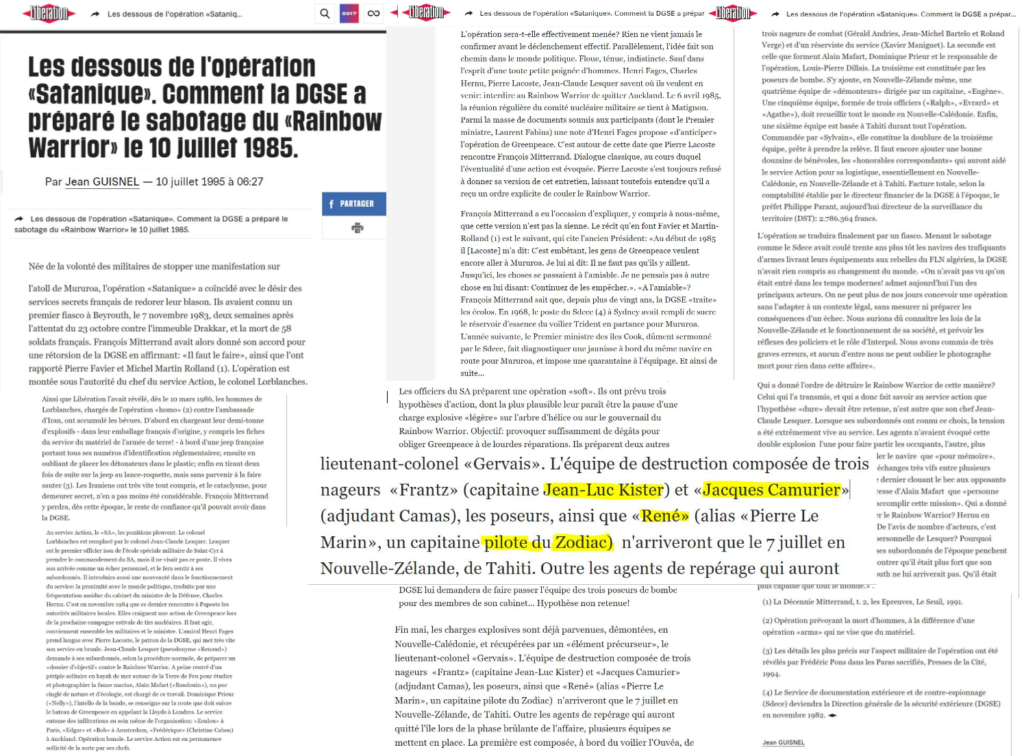
In 2010, TVNZ’s current affairs programme Sunday reported Le Monde newspaper was publishing leaks, from Pierre Joxe, the Minister for the Ministry of the Interior (who was informed of the reality of the facts from July 15). Joxe subsequently fed the press information on the ‘third team‘ to Le Monde.

In Episode 3 of the documentary, Murder in the Pacific, Edwy Plenel who was the Le Monde police beat reporter at the time, said that he and Georges Marion went to dinner with Pierre Verrugghe, France’s Director General of National Police. Verruggh confirmed that the DGSE ‘third team‘ set the bombs, and that the Rainbow Warrior plot was a total operation of French state and its marine commandoes.
Ironically, where sources inside Mitterrand’s government led the French press to expose the DGSE’s role in bombing, Lange’s government played a two-faced game to limit the political fallout with France.

Crucially, back in mid-July of 1985, in the highest levels of New Zealand Government there was a deep state network actively sabotaging the investigations, to stymie knowledge of the extent of French operation.
Indeed, a heavily redacted 1996 report declassified by New Zealand’s Security Intelligence Service (SIS) in May 2017, stated an attitude developed within the Government’s Terrorism Officials Committee that effort was narrowly directed to the prosecution of two of the French secret service agents that were in custody.
Evidently, SIS officials argued for a counter terrorism operation to establish the dimensions of the bomb plot, especially since there was the possibility that French DGSE agents were laying low in New Zealand as the drama unfolded.
Amid the redactions, the sanitized account in the SIS report, entitled Rainbow Warrior – An SIS Perspective, the SIS official noted that, “The pattern of diverging attitudes and emphasis prospered”.
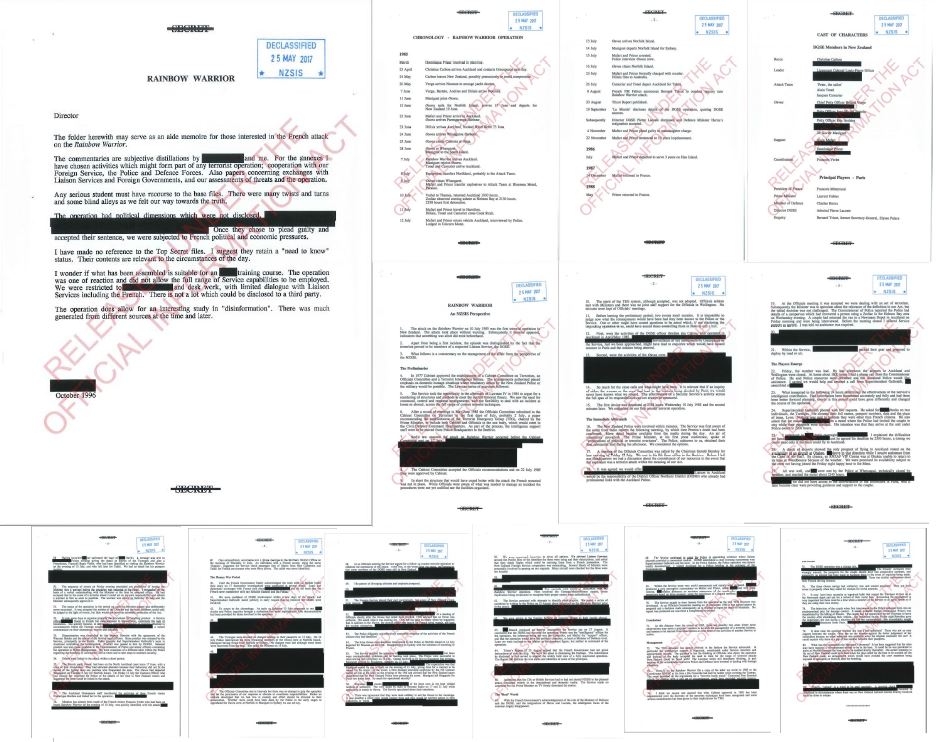
Intriguingly, the SIS stated “The Foreign Service played their part convincingly, but aware of New Zealand’s long term interest, — ”
The rest of the paragraph was redacted.
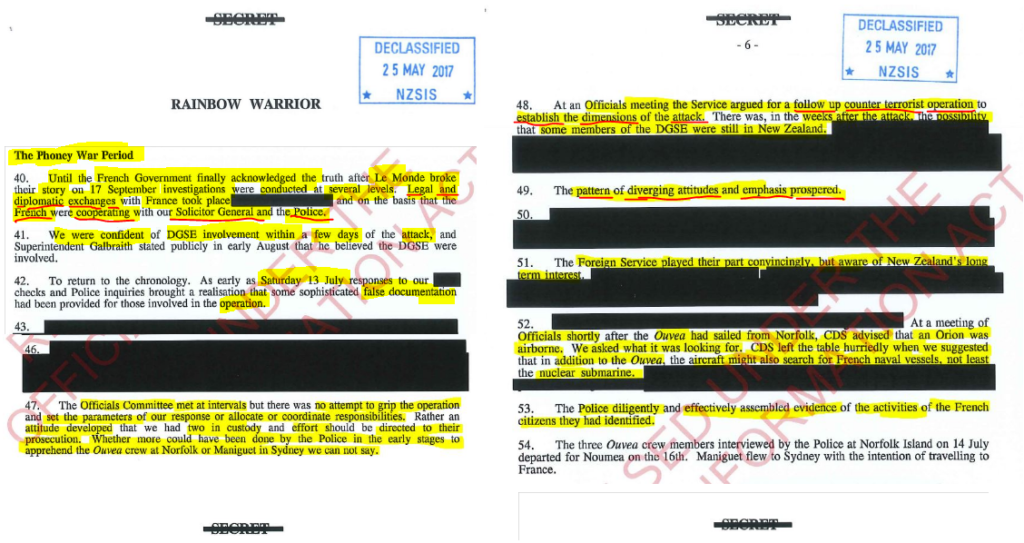
But, what every investigator appears to have missed is the significance of the “orgie of evidence” that were deliberately left as ‘Easter Eggs’ in the meta-data by the 13 reported French agents from the DGSE (General Directorate for External Security) in New Zealand. These Easter Eggs involved scripting events, roles and objects with encoded symbolism that could be readily de-coded by spooks at any intelligence agency for transmission to the Brotherhoods’ political puppets, key Western élites and police brass on a ‘need to know basis’.
The ‘Morse Code’ embedded in the Rainbow Warrior Bombing communicated that this act of state-sponsored terrorism was inflicted to send a ‘price of power’ warning signal to the Western Empire’s ruling élites.
Specifically, the sinking of Greenpeace’s flagship at Marsden Wharf in Auckland’s Waitemata Harbour communicated to Western élites a sinister directive to get their domestic grass-roots movements — including anti-nuclear activists — under control.
The mission objective was not only encoded with occult symbolism. But, also with much richly dark French and American élite humour. The codified weaponized irony flew over the heads of the New Zealand public, whom largely believed that the French were merely being arrogant, inept and brazenly vindictive.
Indeed, the ‘orgie of evidence’ also included the potent symbolism of the French DSGE agents staying at the Hinemoa Motel, in the precise unit owned by New Zealand’s Prime Minister, David Lange. The DSGE agents stayed at Hinemoa Motel three times, including the July 9th transfer of the explosives, diving equipment and the Zodiac inflatable dinghy to the French dive team comprising Gerard Royal, the Zodiac pilot and military divers, Jean Cammas and Jean Luc Kister.
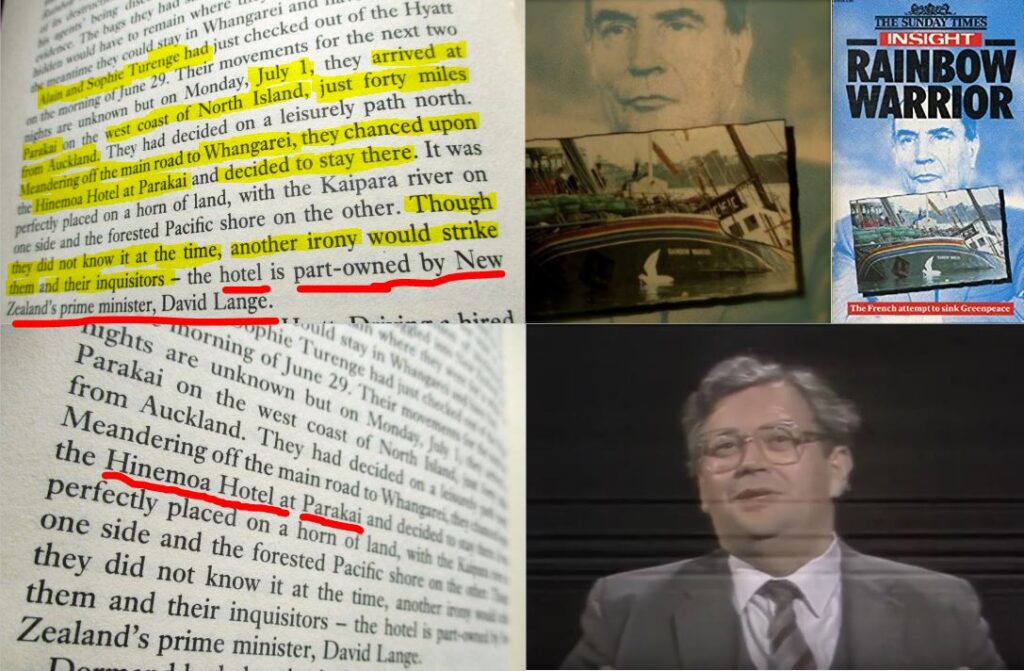
The curious fact of secret service agents from the République Française staying at a motel 50 kilometres north-west of Auckland’s CBD, that was owned by the prime minister, may seem merely ‘coincidental’.
Such coincidences only stand because the farmed humans of New Zealand, as with elsewhere, are conditioned with ideology theories designed to deflect critically examination of the anatomy of conspiracies plotted to maintain social control. Consequently, this fact of the DGSE agents transferring the Zodiac, dive equipment and bombs in the very-same motel unit owned by Lange became solidified — along with so much of the known meta-data — as merely an ‘orgie of evidence’ linking ‘the arrogant French’ to a bungled operation. This New Zealand myth masked over the scope of the conspiracy.
Conspicuously, the sanitized and heavily redacted SIS report from 1996 did not mention that Lange part-owned the Hinemoa Motel. This omission meant the SIS let itself off-the-hook to investigate the obvious encoded threat to the Prime Minister, the Lange Government and the National Security State, since the DGSE agents demonstrated symbolically that the French Secret Service expected New Zealand’s Prime Minister would be accommodating about ‘the French Connection’ — once the link was proven.
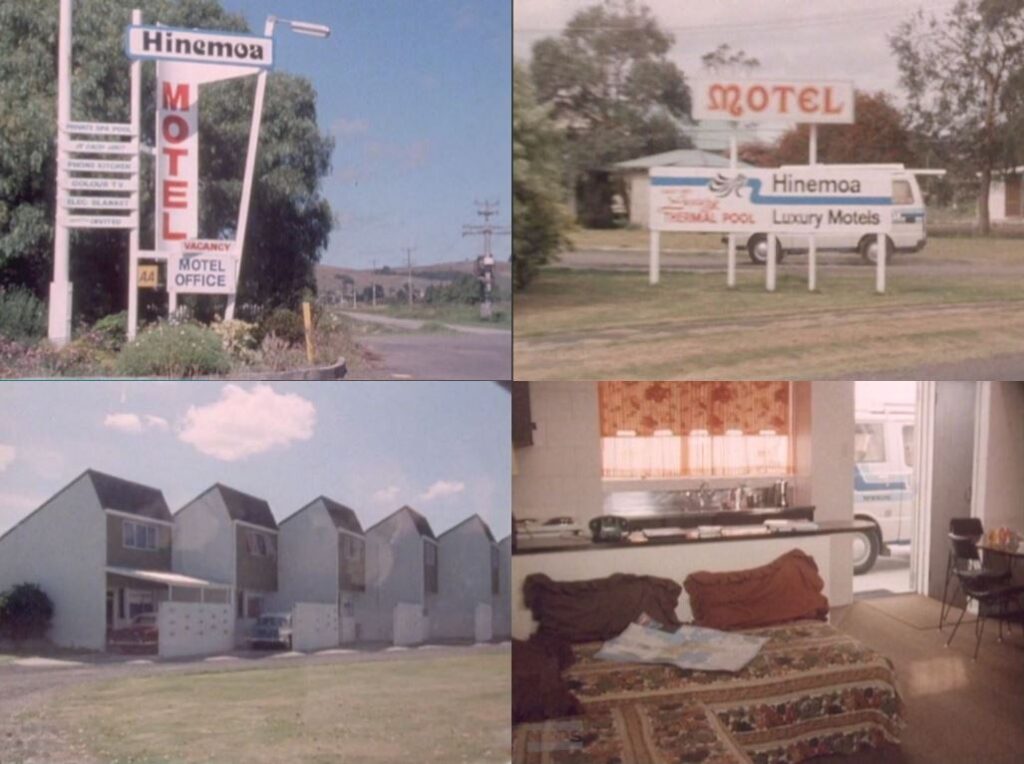
It is around the fulcrum of the lack of a warning to the Greenpeace crew, the short timer-delay on the two bombs and the choice to inflict the bomb plot at port on 10 July in 1985 — that the cover-story’s packaging of the half-sunk seahorse is unwrapped.

➼ Call Signs from the Zodiac Constellation of Pegasus
The head of DGSE’s Action Service, which specializes in clandestine ops, Colonel Jean-Claude Lesquer and the Defense Minister’s Cabinet drew up the blueprint and orchestrated the planning for mission’s code-name ‘Opération Sataniqué’ — according to French newspaper Libération journalist, Jean Guisnel.
It would appear that Colonel Lesquer and Defense Minister Charles Hernu designed this mission with occult weaponized metaphors to symbolize the hidden objectives, as ‘Morse Code’ that I believe would have been readily decipherable to cryptologists.
Amid all the excuses, it is crucial to recall that Hernu was a Catholic Templar Freemason who was close friend of President Mitterrand, a conservative Jesuit-educated Catholic, whose brother, Jaques, was the Grand Master of the Grand Orient de France, or French Templar Freemasonry.
It also crucial to remember that Colonel Lesquer resented his post at the DGSE, which he lost amid the scandal. And yet, Colonel Lesquer was subsequently promoted to major-general and awarded a place in France’s prestigious order as a Légion of Honour, as Grand Officer on July 2nd 1995, by President Mitterrand’s successor, Jacques Chirac. Naturally, Chirac maintained the code of silence when the Gladio scandal broke in 1990.
According to Daniele Ganser, Chirac was president of a militia called Service d’Action Civique, or Civic Action Service (SAC), in 1975, which was supposed to have been loyal to de Gaulle. But, according to Richard Cottrell, it became the intelligence machine of its Director, Jacques Foccart, who evidently claimed he had maintained supervision over the SDECE, meaning his power in France was on a par with the President of France.
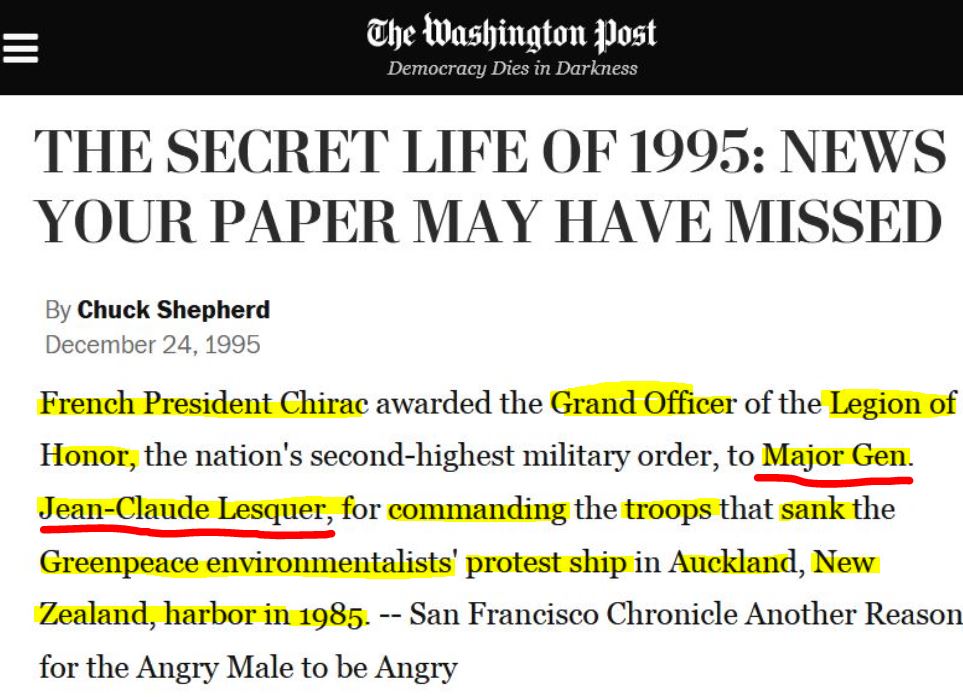
The supposition explored here is that in timing the “sabotage mission” to occur on 10/7 in 1985, the bomb plot planners wittingly embedded the Rainbow Warrior Bombing with the numeric call sign 10/7 used by New Zealand Police to communicate “unit arrived at job” over emergency radio frequencies.
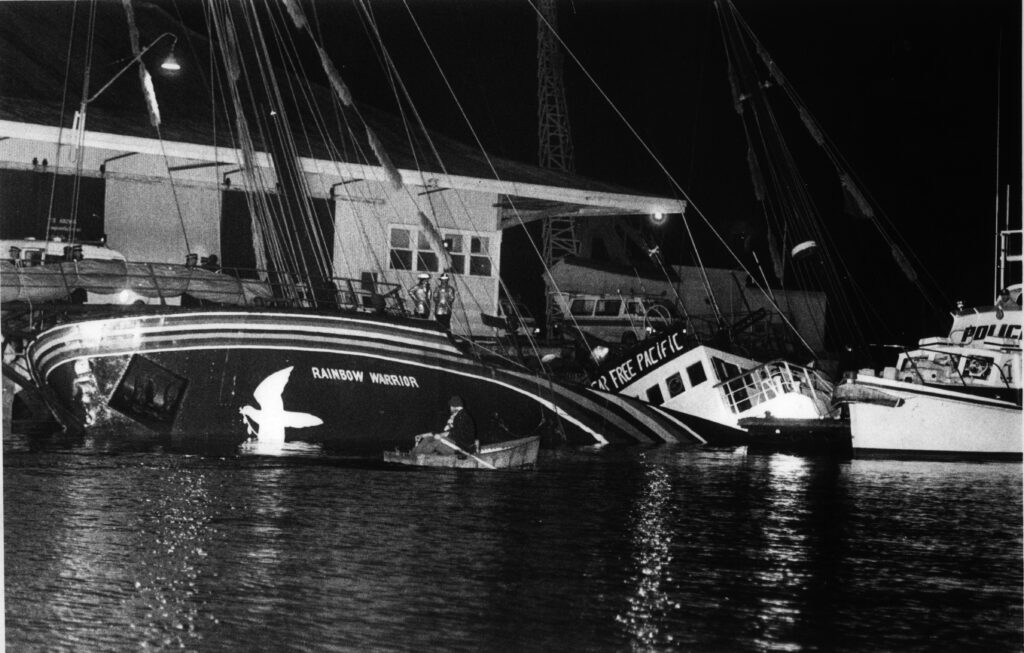
Whether the mission’s code-name ‘Opération Sataniqué’ spoken with its French ‘accent’ and or stripped of it and spoken in its English form as Operation Satanic, it would appear that Colonel Jean-Claude Lesquer was having fun when he wrote the blueprint for the Government of the République Française.
Recall that in early 1985, a U.S. State Department official had stated that by reducing military ties with New Zealand, the United States was sending a signal to the Western Alliance states that the course of diminished cooperation advocated by domestic grass-roots movements — including anti-nuclear movements — “would not be cost-free”?
The time that the first magnetic limpet mine was set to detonate, at 11:38PM or 22 minutes to midnight, or zero hundred hours in military time clocks. The first bomb blew an eight foot by six foot hole in the hull adjoining the engine room, directly below the noun “peace” in the pronoun, Greenpeace, on the star-board side. Therefore, the attack appears to have been designed as a ‘repeated message’ on 10/7 in 1985 at 22 minutes to 00 hundred hours, or 11:38PM, the time of the first bomb detonation.
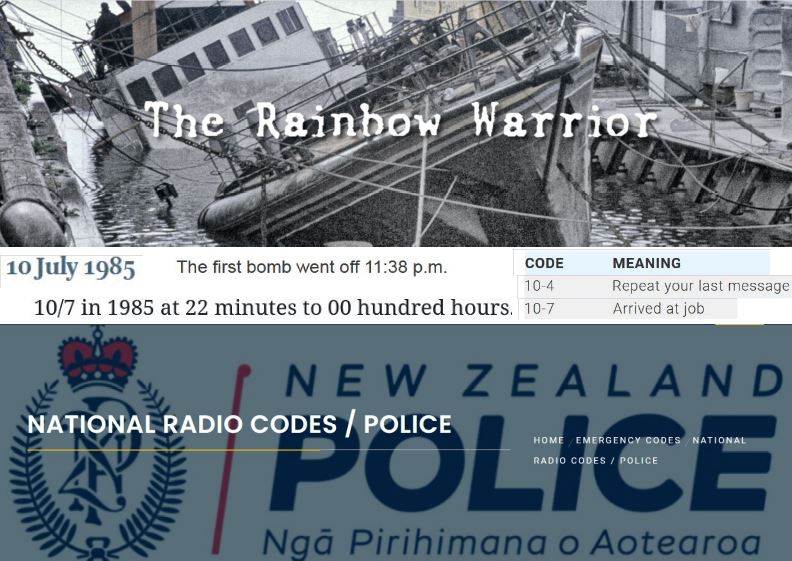
After all, a warning is not credible unless it is believed that those making the threatening remark would actually carry out such a threat. In other words, the threatening remark made by the State Department official of the core nation of the Western Empire, the United States, would look weak to the Soviet Empire if it were not followed up with an action decipherable to the world’s intelligence agencies, military families and oligarchic dynasties. Western élites were being issued a directive that their law enforcement needed to re-assert control over grass-roots movements.

Thirty years after the attack, The New Zealand Herald reported that instead of just one bomb planted on the ship’s keel, a larger bomb was decided upon in April 1985. The reasoning, evidently was two-fold: sink the ship in a spectacular way while sending a non-lethal message to the anti-nuclear movement.
In 2015, combat dive team leader Colonel Jean Luc Kister told TVNZ that the first bomb was set for around midnight, because it was unlikely anybody would be the engine room. Colonel Kister claimed the first bomb was originally going to be the smaller of the two bombs, and was intended to force the crew to evacuate, while the second larger bomb was supposed to sink the ship.
However, Kister told TVNZ’s Sunday current affairs program that the Operation Commander — Lieutenant Colonel Louis Pierre Dillais (alias Jean Louis Dormond), decided the bigger bomb would be attached to the hull outside the engine room, rather than at the keel on the propeller turbine assembly. This choice would produce the desired photographic effect of big hole, and also ensured the ship filled with seawater quicker, with the intention, I believe, to increase the probability of multiple fatalities. Lieutenant Colonel Dillais is head of the DGSE’s Corsica dive school.

As such, the first bomb, which was the bigger of the two, and was — according to Kister — ‘meant’ to be a warning to abandon ship before the second bomb exploded. Evidently, the mission protocol involved mitigating the loss of life, yet Kister failed to explain the contradictory position that the bigger of the two bombs was deliberately set to explode first, outside the engine and directly below the mess room.
If the event of a big bomb exploding was supposed to be taken as a ‘warning’ that a second would soon explode, this ‘message in a bomb’ logic implied all the crew would swiftly work out the ship had been attacked. This ‘message in a bomb’ logic inferred the crew would rule out an accident or malfunction of equipment, and that a second bomb at the keel would soon cause the ship to list.
It would seem that combat diver Jean Luc Kister — whose explanations were an expression of Orwellan Doublethink — missed the weaponized irony in the bomb switch, as I shall show.
In Rainbow Warrior: The French Attempt to Sink Greenpeace there is a primary source ‘eye witness’ account of The New Zealand Herald’s news editor Bert Nealon climbing the stairs back to newsroom as the first edition for the following morning had just gone to print. He felt the shock-wave of the first explosion hit the building at 11.38 p.m., which was a few blocks away from the wharves. As a secondary source, the moderately redacted SIS report, Rainbow Warrior – An SIS Perspective, also noted that the first limpet mine detonated at 2338 hours, or 11:38 p.m, or 38 minutes past 11 o’clock on 10/7 1985.
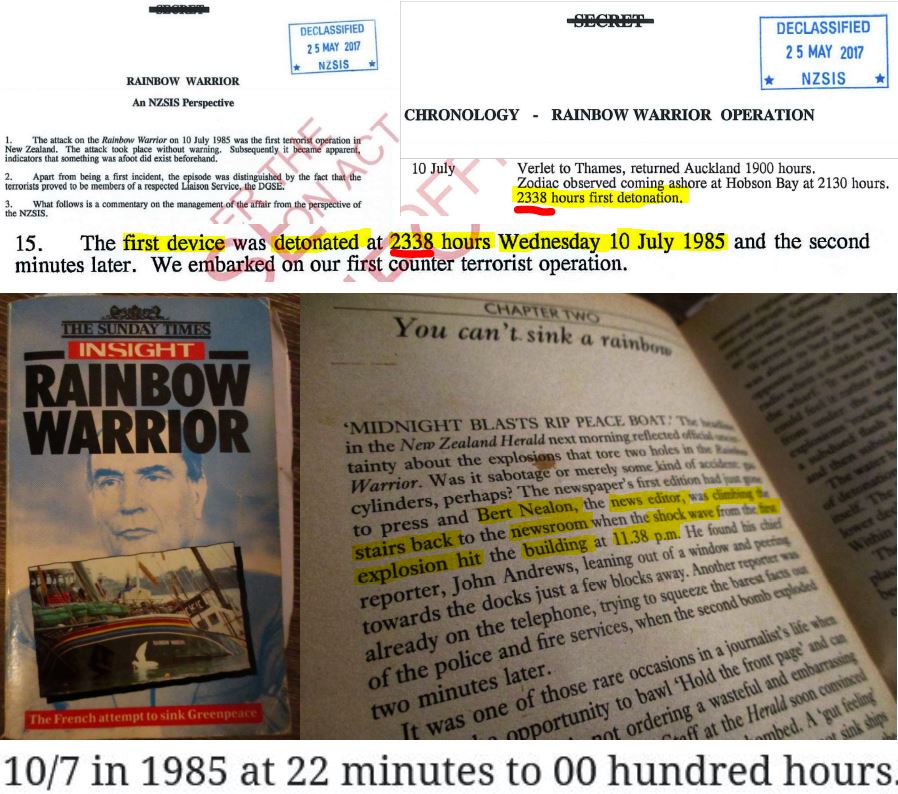
Since most Greenpeace members were not trained in clandestine military black operations, and therefore were unfamiliar with the practice of a second bomb to finish off a ship, were they supposed to have check the time, and then consult their copies of the CIA Manual on Assassination?
The two plastic explosive bombs were set with a three hour delay, instead of the usual 24-hour or 48-hour delay afforded to agents to give them time to skip the country, as The New Zealand Herald reported in June 2000. Evidently, French Defense Minister Charles Hernu had ordered the timers to be set for three hours.
This means the first bomb was set at 7.38 p.m, or some time before.

In a 2015 Mediapart interview, the combat diver who planted the explosives, Colonel Jean Luc Kister, told Edwy Plenel, the former Le Monde newspaper police beat reporter, that the three hour bomb timer delay meant that the dive team had to play their cover roles as skiing French tourists for 10 days.
Unfortunately, in the interview Edwy Plenel did not tease much details from Colonel Kister about whom were the technicians that designed the operation and why exactly the bomb timers’ delay were so short.
Colonel Kister claimed that perhaps the reason was to mitigate lose of life, since it was known the ship was staying in port, rather than say, unexpectedly leaving or undergoing maintenance. These reasons seemed weak since its sailing date for July 23 was known, and maintenance late at night was unlikely.
Moreover, neither seemed to notice the weaponized irony of French terrorists posing as French tourists whom were skiing on a ‘holiday’ in the South Island. Meanwhile, the Police were following a trail of abundant clues in the upper North Island. Police also pursued a chartered yacht, Ouvéa, to Norfolk Island, reported to have been chartered by four French diving tourists, despite the poor conditions for diving in winter.
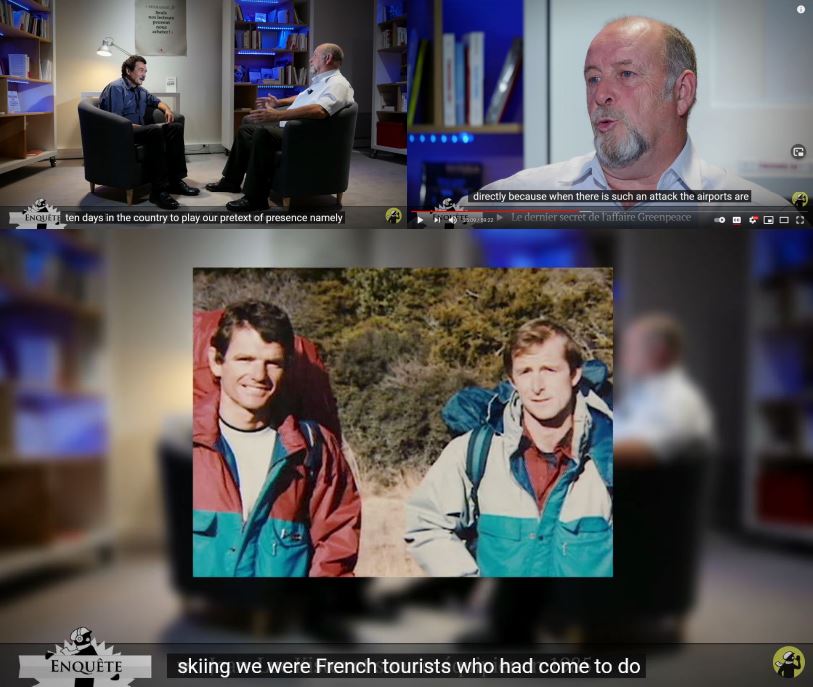
But, Norfolk Island is an Australian territory, and Australian officials would only confer a holding period of 24 hours, unless New Zealand authorities could prove the Ouvéa crew had breached a New Zealand law. The small team of Police gathered maps, brochures and took samples from the yacht. But they had no means to analyze the material in 24 hours. Meanwhile, the DGSE agents played dumb, gave evasive answers and whittled away the time in their interviews. Later, the samples taken from the Ouvéa revealed traces of explosives, as well as a fingerprint match to Major Mafart that was found on a Newman’s map.
The fingerprint proved Mafart’s claim that he and fake wife had never met the Ouvea crew, was a lie.
Among other documents found on the Ouvéa was a Greenpeace brochure with a Grey Lynn address scribbled on it. The address was the home of Greenpeace New Zealand’s director Carol Stewart and in turn, to the Christine Cabon, whose part in the bomb plot was a reconnaissance mission.
The NZ Police had not only been distracted to chase suspects with flimsy covers to a small tropical island where they had no direct jurisdiction. But, the French joke was also that Australia did have jurisdiction in Norfolk Island, and also both Anglo-Saxon countries with members of the British Commonwealth, therefore sharing the same monarch as sovereign head of state.
Meanwhile, the DGSE combat divers who actually laid the bombs were having fun skiing in the Southern Alps, which is in the jurisdiction of the New Zealand Crown.
Moreover, the 1996 SIS report noted that Dr Xavier Maniguet — who travelled to New Zealand aboard the chartered yacht, Ouvéa, from Noumea — travelled to the South Island on June 28 and returned to the
Ouvéa on 7 July.
Thus, while his ‘crewmates’ pretended to be French tourist divers who could sail for Dr Maniguet, he was allegedly in the South Island for a week. Was Dr Maniguet — who travelled with no false passport — paying off locals, including Police, with bribes ahead of the French attack team taking cover in the South Island?
In the chessily headlined June 2000 story, “Saboteur spills the French beans”, Major Mafart claimed the code-name had no satanic or cult significance.

The mission code-name ‘Operation Satanic’ appeared to be ‘Morse Code’ for a terrorist mission to signal to Western élites that it was imperative that grass-roots movements and their organizations such as Greenpeace were undermined with re-doubled efforts to protect the Anglo-American Empire’s Doomsday Device capacity to inflict nuclear terror.
The N.Z. Herald reported that Major Alain Mafart claimed in his book, The Secret Diaries of a Combat Diver, that all operations at that time were code-named to start with the letters S and A after the agency’s Service Action, which carried out under-cover operations abroad. Despite this ‘revelation, the former DGSE agent claimed in 2000 he still did not know why the timers were set for only three hours. [Editor’s note: Major Mafart believed the delay was four hours, but Colonel Kister, who set the bombs, says the delay was three hours. Mafart’s book was co-written by former Libération journalist Jean Guisnel].
This unanswered question, I contend, is a bigger issue than almost anyone realizes and leads, I believe, to the deeper significance that is embedded in the historical date of July 10 for New Zealand, and its relationship to the core territory of the Empire: the United States of America.
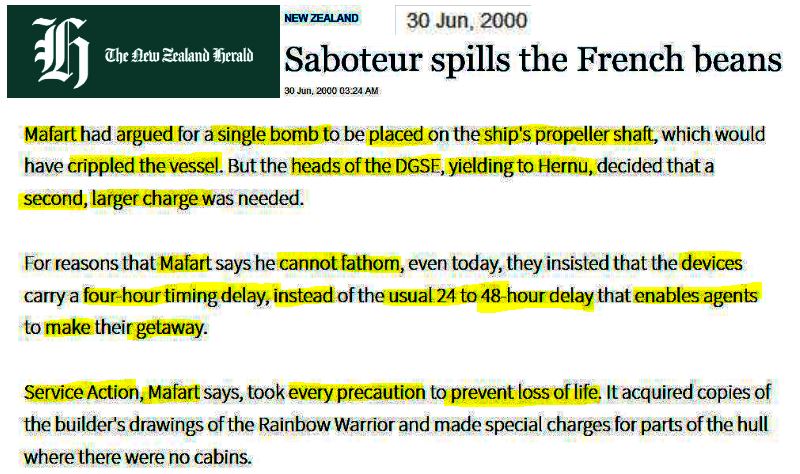
The three hour timing delay implied it was crucially significant that the bombing occurred before midnight, and therefore that the explosions happened on the date of July 10.
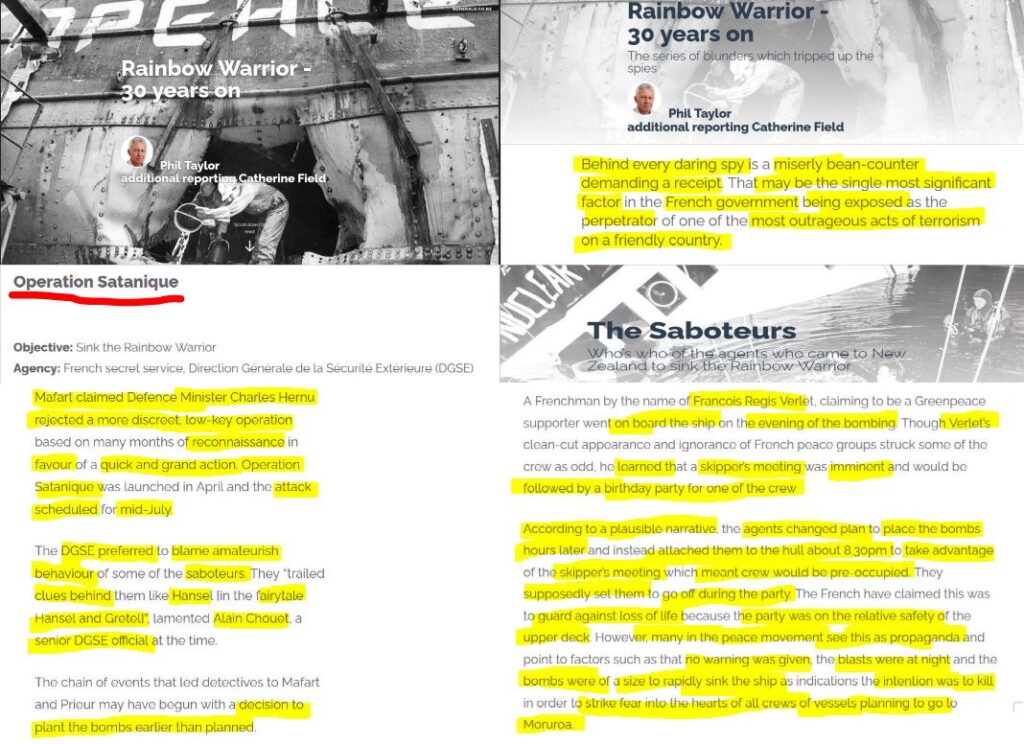
The reason may have been to ensure the blasts occurred before everyone was settled in bed to mitigate the loss of life. But, then again, far more could have died if the birthday party aboard the vessel had carried on at full strength, instead of migrating to the West Auckland coastal community of Piha, where pop band Split Enz was partying.
Indeed, if the invited members of Split Enz had come aboard the Rainbow Warrior, all hell might have broken loose had they perished and caused serious problems for the French Government. Because – at that time, aside from Split Enz, there was only one other group of people that most New Zealanders would have lost their shit over, if they were murdered: the All Blacks.
More importantly, skipper Peter Willcox says if the first bomb had have exploded a half hour sooner, Greenpeace would have lost 20 people because the birthday party would have still been aboard.
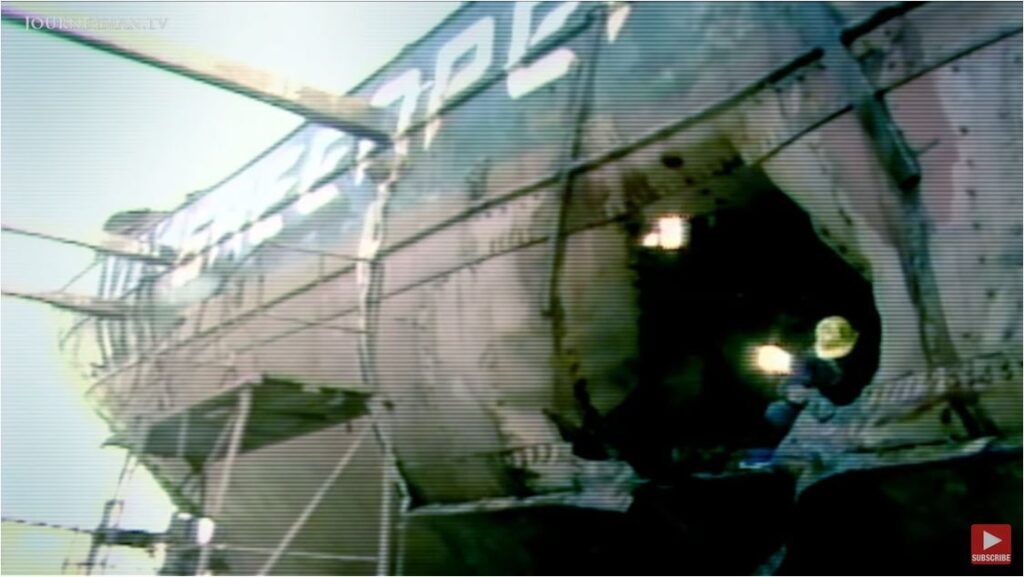
The first explosion, which sent shrapnel flying through floors and walls, caused the ship to fill rapidly with sea water. Kister and Cammas used a roped tied with knots at regular intervals that they counted off to measure precisely where the set the first, larger bomb against the hull outside the engine room. The bomb was attached from the bilge keel — which on the Rainbow Warrior was an eight inch wide strake like a long thin wing running the length of the hull below the waterline and is designed to stabilize the ship in rough seas.
Once the first bomb’s timer was set, Kister could set the second bomb’s timer to detonate four minutes after the first. The second bomb was designed to coerce Greenpeace’s Executive Council to scuttle the ship, since damaging the keel, the propeller shaft and the ship’s stern would make the vessel irrepairable.
In this way, the weaponized irony was embedded into the event since the ‘Opération Sataniqué’ anticipated that the environmental and peace activists group would be compelled to sink the ship themselves, after it was taken to dry dock at the Devonport Naval Base.
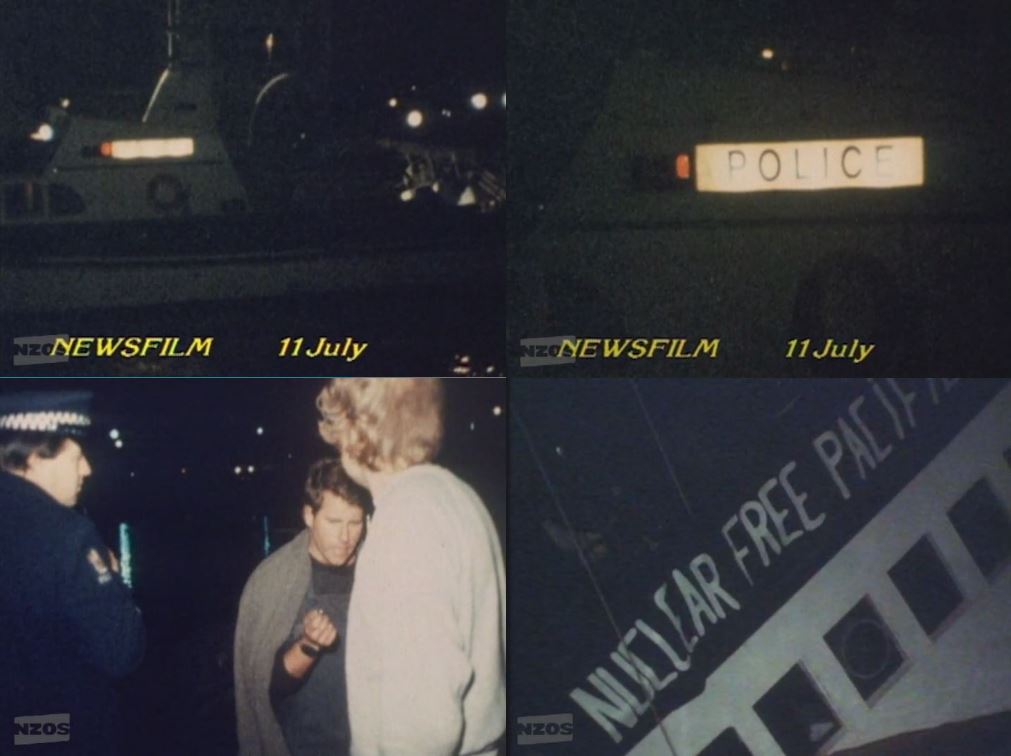
French agent Francois Verlet, who was coordinator for ‘Opération Sataniqué’, had boarded the Rainbow Warrior, at approximately 7:10pm on the winter evening of July 10. As the man on the ground, he may have acted as a ‘signals man’ to communicate ‘the coast was clear’ on the Rainbow Warrior deck for the Zodiac crew to advance to Marsden Wharf.
Lieutenant Colonel Dillais, who had arrived on June 23, had a clear view of Marsden Wharf from his 7th floor room at Hyatt Hotel on Quay Street and, therefore, of Verlet on the wharf. Verlet walked aboard the re-fitted 130ft cod trawler and infiltrated the birthday party for Steve Sawyer, Greenpeace Anti-Nuclear Campaigner.
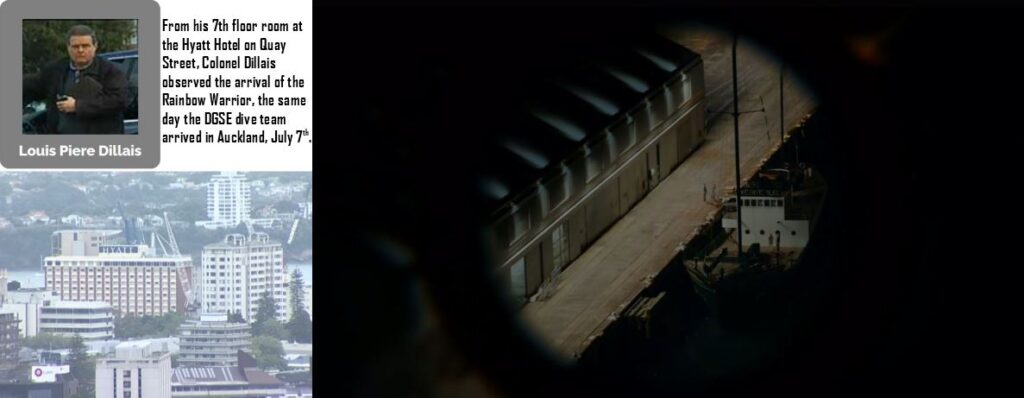
From inside the mess-room of Greenpeace’s South Pacific seahorse, Verlet could keep an eye on crew members, who might stray on the deck for a sly smoke or joint.
While Verlet was aboard, the combat dive team did the vicious work of what they believed were France’s imperial interests within the Western Alliance. However, the geopolitical agendas appear to have had deeper significance than journalists, academics and political analysts have reckoned.
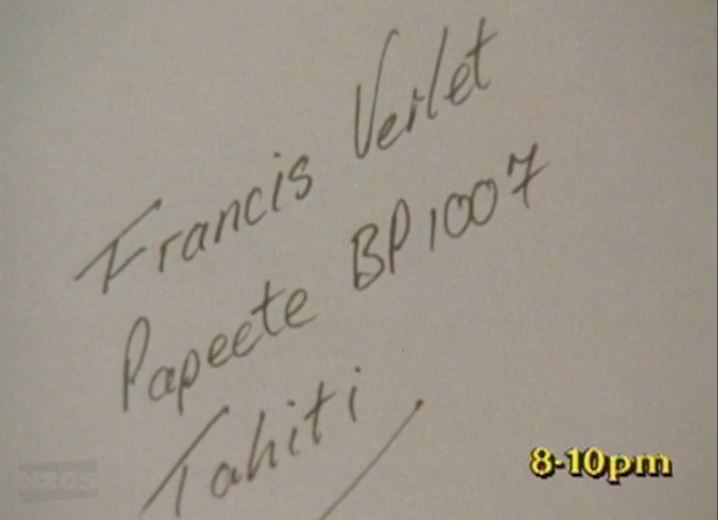
The symbolism in the synchronicity of the dates may not have been limited to the Police 10/7 call sign. This timing for July 10 meant the mission designer had to plan for the agents of the seven teams to disperse with their covers intact.

After setting the bombs ticking, the DGSE attack team, comprising Combat dive team leader, Colonel Jean-Luc Kister, support diver Jean Cammas (alias Jaques Camurier), and Zodiac pilot, Gerard Royal travelled to Wellington in a second camper-van parked near the harbour bridge. Kister and Cammas swam from Marsden Wharf to their rendevous point, while Royal’s return trip with the Zodiac for pick-up by Mafart with the Newman’s camper-van was complicated by low tide.
The combat dive team crossed the Cook Strait to the South Island on 11 July 1985. There, they kept a low profile skiing at high altitudes in the Southern Alps, near Queenstown, in a land being reforged as a ‘Switzerland of the South Pacific’, rather than a Banana Republic.
On July 26th 1985, Colonel Jean-Luc Kister and Jean Cammas flew to Auckland, and skipped the country to the French territory of Tahiti with false passports.
Clever blind alleys helped keep police attention focussed in the imaginatively-named North Island of New Zealand.
The skipper of the yacht, Ouvéa – that was chartered from Noumea and which was used to transport the attack dive team, their equipment and the limpet mines to New Zealand – had a dalliance with the wife of a Whangarei policeman. With this fling, Chief Petty Officer Roland Verge (alias Raymond Velche) – the French army combat diver-turned DGSE agent conveniently helped draw police attention to the yacht and its movements, and away from the attack team and support crew still in New Zealand.
The French agents knew full-well that once Greenpeace staff in Auckland voiced their suspicions about infiltration by a French national in the lead-up to the bombing, locals in the far north would put two-and-two together and realize the Rainbow Warrior Affair came packaged with French agents who took their covers as diving tourists serious enough to bed some local females. In this way, the French secret agents went the ‘extra mile’ to demonstrate they could penetrate New Zealand culture.
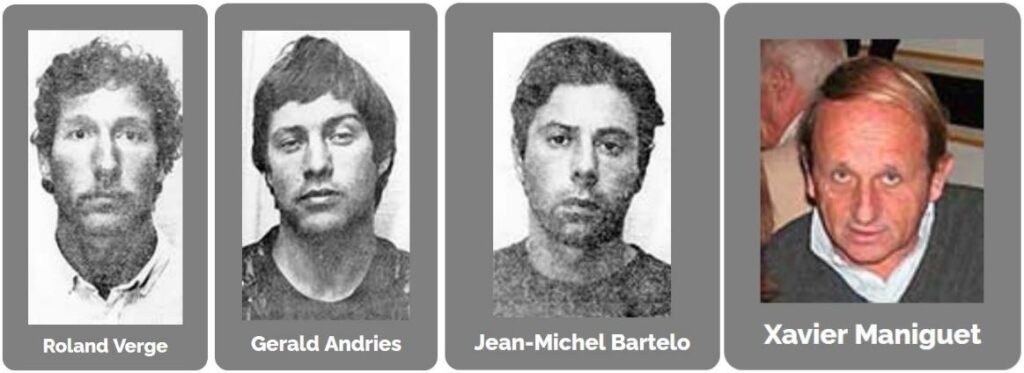
To this end, the Ouvéa crew made themselves very visible prior to their departure at 9:15 a.m. on July 9th 1985, by throwing a farewell party at a restaurant in Whangarei. They also made a fuss of customs officer, Lew Sabin, who cleared the sailors to leave. The night of the bombing the Ouvéa lingered in the Hauraki Gulf, likely standing by in case the dive team team encountered trouble while setting the bombs. After-all, Dr Maniguet’s speciality was treating marine accidents, and the Ouvéa crew had also trained at Corsica.
Late on July 13th, the Ouvéa crew arrived in Norfolk Island, exactly one month after their arrival on June 13th, having sailed with forty horse-power engines in swift time to construct an alibi.
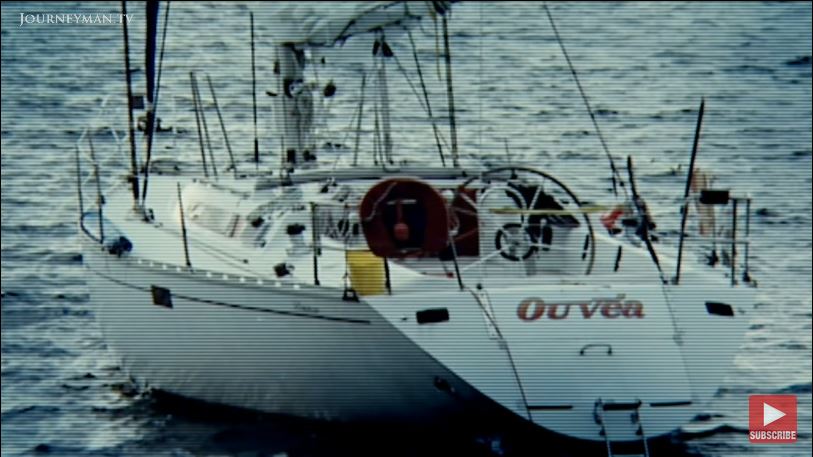
Brazenly, such ‘cost’ referents were embedded in the machinations of a DGSE mission scout who was sent to New Zealand in late April 1985, ostensibly to gain intel on the ‘ley of the land’ inside Greenpeace’s Auckland office.

DGSE agent Christine Cabon, who posed as geomorphologist ‘Frederique Bonlieu’, persuaded Greenpeace National Coordinator Carole Stewart to make calls for her to find out the costs of purchasing or hiring small boats and dinghies and prices of diving equipment. Cabon explained that four tourist friends were planning to visit and they were divers. She also claimed these details were hard to understand because of the accents and the English language, despite her being fluent enough to hold conversations with Greenpeace staff.
The French secret service agent’s élite humour appeared to be playing on the similarities in the pronounced sounds of the English noun, ‘tourist’ and the Anglosized French noun, ‘terrorist’, since the thick New Zealand accent mangles vowels and butchers consonants.
Cabon actually feigned her difficulty in understanding English to establish who was fluent in French around the Greenpeace office. She subsequently was free to call the DGSE from Greenpeace and receive calls from France at Greenpeace’s Office, without fear of the peace-environmentalists comprehending a word she was saying.
Cabon was not really attempting to purchase or hire the dive equipment and an inflatable dinghy. While the French intended that the trail of evidence would reveal ‘the French Connection’, and relied on the näivety of New Zealanders to fall for an ‘arrogant French’ proposition – France’s Government did not count on any of their agents being caught.
For one thing, the specialist breathing equipment used by the two DGSE divers was designed to not produce tell-tale bubbles at the surface.
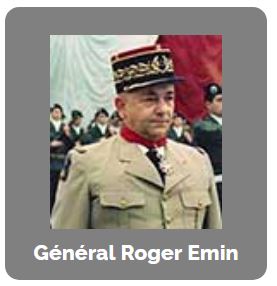
Therefore, Cabon was deliberately leaving clues to construct an infiltration and intelligence gathering alibi, since the obvious ‘French Connection’ would led to a broader trail of clues, including ‘blind alleys’, that were intended to buy time, while the remaining DGSE agents skipped the country.
Christine Cabon’s assignment had followed a reconnaissance visit by Général Roger Emin, the Head of DGSE operations division, on orders issued by DGSE chief Admiral Pierre Lacoste. Général Emin was back in Paris when it was carried out.
That said, the French Secret Service did signal the direction they were taking to their British counterparts.
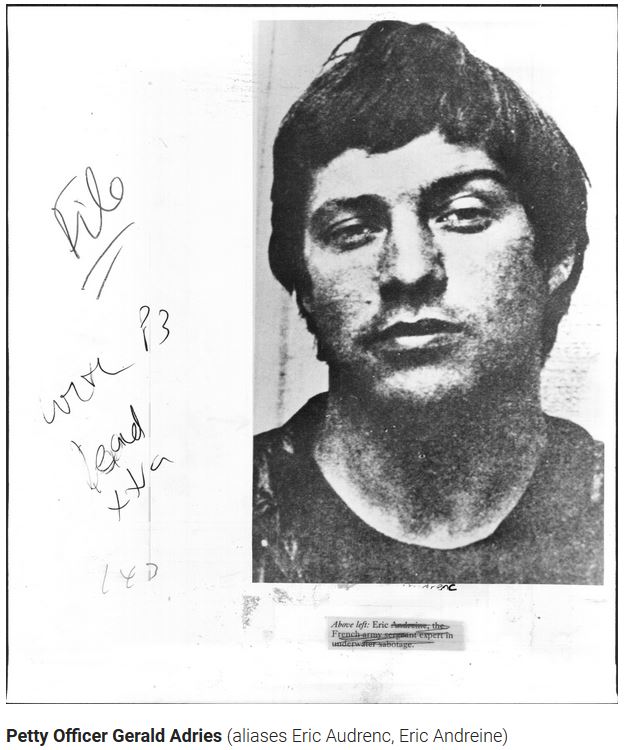
The French-manufactured Zodiac inflatable dinghy was purchased on May 29th 1985 at Barnet Marine Centre in Greenhill Parade in North London by DGSE agent Petty Officer Gerald Andries (alias Eric Audrenc), who couldn’t speak English. This was not merely a clumsy attempt to avoid the French link to the terrorist plot by making it seem like Andries was a tourist buying an inflatable while on holiday in England – as Le Monde and The New York Times reported on September 18th 1985.
The DGSE agent was leaving a call-sign to their intelligence counterparts at MI5 that some ‘friendly fire’ between allied nations was being foreshadowed by French ‘celestial astrologers’ for British ‘horoscope readers’ at MI5 to consult their ‘celestial cartographers unit’ to decode the mission objective.
MI5, which is Britain’s equivalent to the FBI, were evidently told the French DGSE were planning a sting because New Zealand was allegedly being used as a trans-shipment point for a gun-running ring to Melanesians in French New Caledonia seeking independence.
This was a cover-story so flimsy, a newspaper horoscope columnist could have deciphered its meaning. While there was an independence movement, and guns were being supplied, and New Zealand’s had been used as a trans-shipment point – the idea of a Western Alliance power pulling off a sting within a Five Eyes country indicated one thing: cryptic subtext.
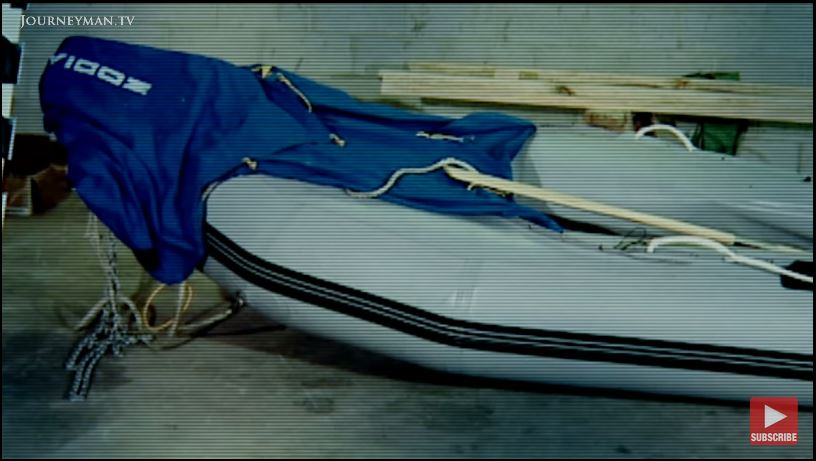
In the Northern spring of 1985, word was leaked to a Western agent in Paris that a French plot would play out in New Zealand. This information was brought to the attention of intelligence officials at a weekly meeting at Whitehall in London in May. This gathering of the Joint Intelligence Committee, which usually occurred on a Wednesday, between Australia, Canada, New Zealand, the United States, and the United Kingdom – including Britain’s MI5 and MI6 – was the result of an alliance formed in 1947, when the five Anglo-Saxon nations signed a treaty known as the UKUSA Agreement.
Under this secret decree, each nations’ security service pledged to share intelligence information among themselves. In The Rainbow Warrior Affair, Shears and Gidley wrote that the information received by New Zealand intelligence officials was not specific, and may have been understood as an intelligence operation.
Crucially, the Government Communications Security Bureau (GCSB) did not provide any intelligence warning of an impending French attack or suspicious operation occurring in New Zealand – as Nicky Hager observed in Secret Power: New Zealand’s Role in the International Spy Network. The lack of ‘warning’ is intriguing. For one thing, the GCSB received from Whitehall weekly minutes of the Joint Intelligence Committee.
MI5 observed the arrival of the fake Swiss honey-mooners in London en route to New Zealand. Major Mafart was well known to British intelligence, since he had trained with a British commando unit, the Special Boat Service, which comprised 300 men trained in land, sea, and air operations. This information was withheld from investigating New Zealand Police in the crucial days after ‘Alain and Sophie Turenge’ were arrested on July 15th.

It would appear then that a two-track asymmetric flow of intelligence occurred. The perception was created that New Zealand’s National Security State apparatus ‘detected’ no bomb plot operation, which is not the same thing as saying no foreknowledge of an operation was disseminated.
France’s role as a second-tier nuclear power, and ally to the Five Eyes nations alliance between Australia, Canada, New Zealand, the United States, and the United Kingdom, appeared to be symbolically codified into the time of attack – down to the minute.
Many accounts record that the bombing occurred at 11 or 10 minutes to midnight, because that is the time the mess-room clock stopped. However, the SIS records the first blast occurred at 11:38pm, which is the same time that The New Zealand Herald’s news staff felt the shock-wave hit the building a few blocks away. For the convenience of a headline, The New Zealand Herald‘s lead story, “Midnight Blasts Rip Peace Boat” hid the crucial details that the first explosion occurred at 22 minutes to midnight, which meant the significance of date of 10/7 was lost on news audiences.
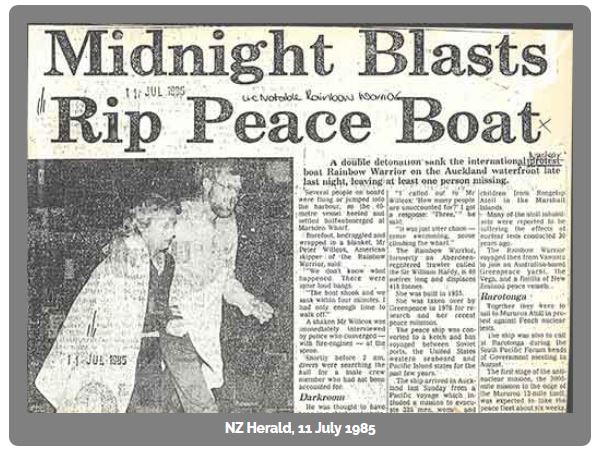
Because the operation planning time had been rushed, the agents lacked familiarity with rendezvous locations. Additionally, poor reconnaissance, flaky cover-stories and observant locals compounded the compressed mission planning time-frames.
These pressures led to early leads for the Police.
Detective Superintendant Galbraith had early breakthroughs that led to the discovery of the broad origins of 10/7 bomb plot. A French made Mark II light grey and black Zodiac had been found chained to a shoreline fence. Greenpeace members recalled a Frenchman, calling himself Francois Verlot, had visited the Rainbow Warrior on the evening of explosions.
Because the ‘Swiss honeymooners’ were caught within 48 hours of the bombing, and the French Connection was proven quicker than anticipated, and led to an unanticipated high court case – Cabon’s deliberately scattered trail of surface clues worked against the French state.
The theatre continued after the attack.
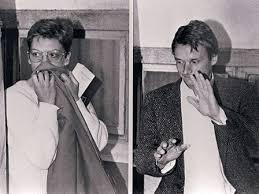
The significance of Major Maffart waiting for a $130 refund for returning the Newman’s rental van early – suggests the DGSE agents lacked a back-up plan, meaning the French DGSE never anticipated their agents would get caught. Or, that Kiwis were docile creatures. Ironically, by waiting for the refund at the insistence of Newman’s staff who were stalling for the Police to arrive, the intended sign language embedded in the meta-data for New Zealand’s National Security State was transformed into evidence for prosecution. The camper-van’s corporate logo featured a Greek mythical flying horse logo.
The choice of a Newman’s rental van used by the fake-Swiss honey-mooners indicates the French DGSE agents were signalling a white horse with magical powers had paid a friendly visit to make the Greenpeace ocean-going floating seahorse become a nearly submerged seahorse tied up at Marsden Wharf.
The Newman’s Travel Company logo featured the Pegasus symbol, a mythical winged divine horse from Greek mythology that is usually depicted in pure white, while celestial cartographers portray Pegasus as half of a horse, rising out of the ocean. The Greek God, Zeus, is said to have transformed Pegasus into the constellation visible in the northern sky, with the brightest star being an orange super-giant, Epsilon Pegasi, also known as Enif, which marks the horse’s muzzle.
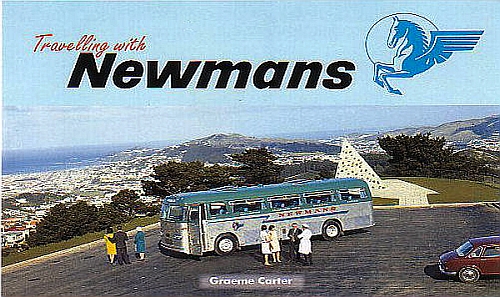
With this ‘Morse Code’ – I believe – N.Z.’s top officials were being prompted to constrain the investigation, drip-feed the revelations and bungle attempts to catch the remaining French agents whose accents would be a dead give-away, especially with the Aviation Security Service supposedly on high alert.
To this end, the publicity photo of the Newman’s van, taken with the door open to display the Pegasus logo, suggests the Police top brass and perhaps the management of The New Zealand Herald, had prized open the occult treasure chest.
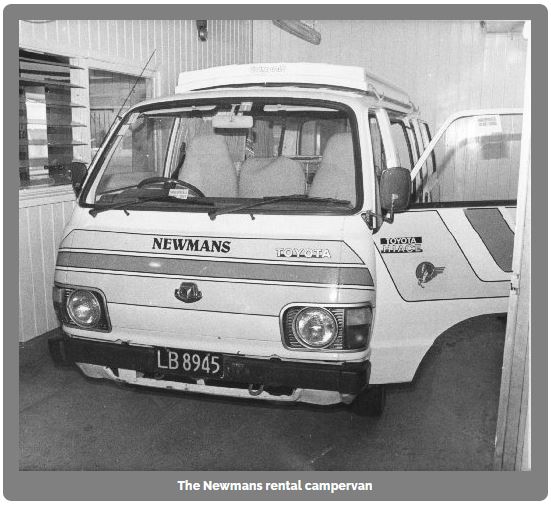
It would appear the Brotherhood of N.Z’s deep state had decoded the ‘repeated message’ of the “sabotage mission” timed to occur on ‘10/7’ in 1985, that discernment was required to muzzle the ‘political giant’ of the Southern Hemisphere, the rotund David Lange.
Because – if the super-giant charismatic political star became a ‘loose cannon’ divulging to New Zealanders the sub-terrain meaning embedded in the event of Greenpeace’s seahorse being submerged while tied up at dock at 22 minutes to midnight on the evening of 10/7 in 1985 in a French roulette ritual, code-named Operation Satanique, all hell might have broken loose.
After-all, the bomb plot involved the transfer of the explosives, diving equipment and the Zodiac to the French attack team, who were staying at the Hinemoa Motel, in the exact unit owned by the Prime Minister as an investment property.
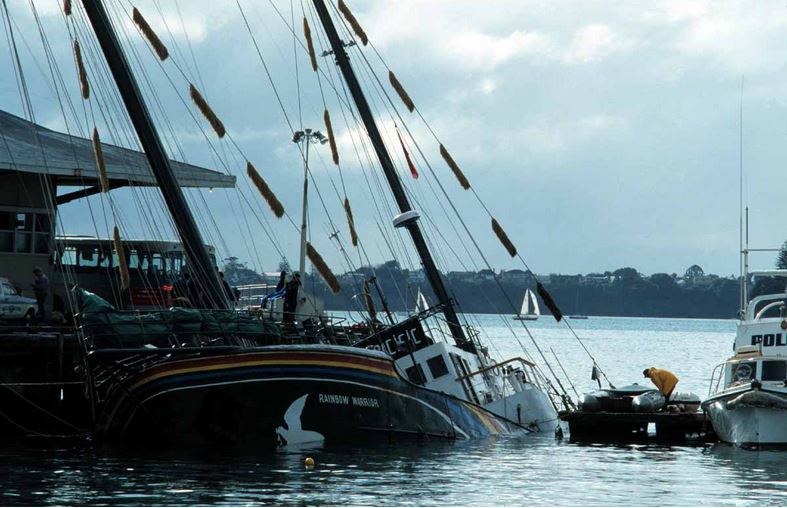
Major Mafart and Captain Prieur were supposed to leave New Zealand from Wellington. Amid a man-hunt with an operation that had gone awry, it would seem they opted to leave from Auckland rather than risk drawing Police attention to Wellington, which might expose the fact that the combat dive team had crossed the Cook Strait from the capital city. Since the capital city of Wellington was home to the national headquarters of the Government, the Police, the Aviation Security Service, the SIS, the GCSB and Ministry of Defence – the DGSE dive team had, in effect, slipped away to the imaginatively-named South Island. In short, the French secret service’s mission planning involved an audacious get-away right under the noses of the country’s National Security State apparatus. And, as it happened, this get-away occurred the afternoon before the Officials Terrorism Committee met for the first time.
Indeed, the trigger event for Gerald Hensley convening the Officials Terrorism Committee was not the bombing itself, as any reasonably-headed nine year-old with an interest in Scooby-Doo mysteries might expect. Evidently, the sleepy SIS did not learn of the bomb plot until Radio New Zealand reported the attack on the Rainbow Warrior in its morning news bulletins. In other words, there was radio silence between the Police and the SIS.
It turns out, the event that triggered the Chairman of the New Zealand’s Intelligence Council to convene the Officials Terrorism Committee was the apprehension of DGSE agents Major Mafart and Captain Prieur at the Newman’s Depot in Mt Wellington, Auckland on the morning of Friday 12 July.

There is nothing suspicious in this fact of the National Security State’s Officials Terrorism Committee begrudgingly convening 36 hours after the bomb blasts.
Nothing whatsoever.
Evidently, New Zealand’s Officials Terrorism Committee was supposed to wait for the luck of travel agent staff who became suspicious when two honey-mooning tourists attempted to return a rented campervan three days early. (They didn’t appear to be having a fun honeymoon). And, the protocols for triggering New Zealand’s Officials Terrorism Committee to convene also seemed to be wait for the luck of two ‘vigilante’ boaties, who wrote down the Newman’s camper-van number plate after spotting three Frenchmen abandoning their Zodiac under the cover of darkness at Mechanics Bay.
In other words, there’s something very fishy about the Hensley-chaired Officials Terrorism Committee. What were they doing for 36 hours – practising their best ‘play dumb’ whistling tunes?
After all, the bombing of the Wellington Trades Hall that occurred precisely 1 year, three months and 13 days prior to the Rainbow Warrior Bombing was not designated an act of terrorism.
Yet, if that bombing of March 27 1984 had occurred in the lobby of Parliament, the Beehive, or at the headquarters of the Police, the SIS, the GCSB or the Ministry of Defence – New Zealand’s white supremacist ruling class would have been hysterically screaming ‘terrorism’.
And if New Zealanders knew the nation actually had an Officials Terrorism Committee, any sharp nine year-old Scooby Doo Mysteries fan would have seen the double-standard.
Combat diver Jean Luc Kister seems to have missed the weaponized irony in Opération Sataniqué that any sharp nine year-old Scooby Doo Mysteries fan would have picked up, if all the clues had been presented. For instance, the bomb switch decision that had Jean Luc Kister place the big bomb on the starboard hull outside the engine room, instead of on the propeller shaft at the keel, after being delivered to the vicinity riding on a Zodiac.
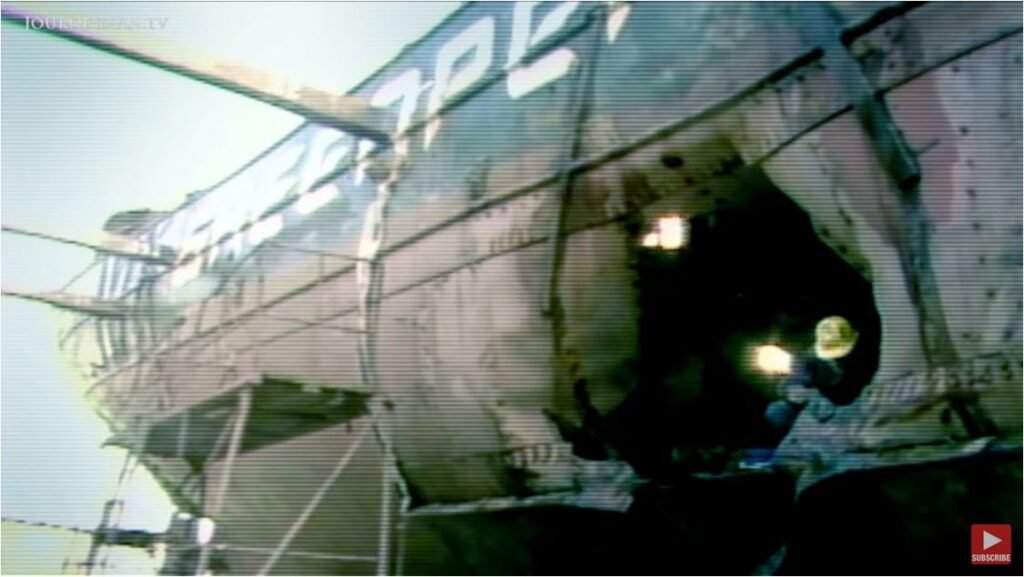
Operation Satanique was all about reigning in grass-roots activists by signalling through codified communications to the primary theatrical audience of this terrorism plot: ruling class Western Elites.
What better Morse Code metaphor than a spectacular gaping hole in the half-sunk ship’s star-board hull directly below the peace part of the organization name, Greenpeace, on its South Pacific seahorse, inflicted from a big bomb set by agents of one of the world’s great powers allied to New Zealand?
Especially, since the DGSE divers rode in a Zodiac twith their payload, and were picked up by a Newman’s rental van, recognizable with its distinctive Pegasus flying horse logo. What better weaponized irony than a large scale operation involving dozens of French agents half a world away that would predictably result in organizational executive council scuttling their principles to save the South Pacific seahorse loved by grassroots anti-nuclear activists and send the Rainbow Warrior to a sea-grassy grave?
Because – that alleged bomb switch had also directly led to the ship’s photographer drowning. Regardless of the accuracy of Jean Luc Kister’s version of events, the mission to sabotage Greenpeace’s capacity to capture explosive imagery of France’s nuclear tests at Muroroa Atoll was achieved with a Shakespearean poetic tragedy that matched the metaphorical Morse Code embedded into Opération Sataniqué.
One French-speaking man had been observed making an ill-timed rendevous with the camper-van at the shore of Mechanics Bay next to the boat-sheds, not far from the Ports of Auckland wharves. The camper-van had missed picking him up. When two ‘vigilante’ boaties from the Auckland Outboard Boating Club shined a torchlight, the frogmen panicked and abandoned the Zodiac.

These rabbit droppings, along with the Alain Mafart’s poor judgment to maintain his honeymoon cover by returning the camper-van and waiting on the $130 refund added poetic irony to the budget tourist cover-story underpinning the perfect crime: get-away with receipts of the costs to a second-rate nuclear power.
Many have missed the French élite humour embedded throughout the Rainbow Warrior Bombing event and its aftermath. This weaponized ironic humour signals France’s Ruling Class were never seriously threatened by the scandal – which the SIS termed, ‘The Phony War Period’.
The alphanumeric code that appears to have been embedded into event, suggests the mission code-name was chosen for its efficacy as a mechanism to communicate ironic weaponized metaphors.
The Newman’s Pegasus logo seems to have provided inspiration for some of the mission planning.
➼ An ‘Orgie of Evidence’ to Finger France
The ‘cost’ referents were also embedded in the machinations of a DGSE mission scout who was sent to New Zealand in late April 1985 ostensibly to gain intel on the ‘ley of the land’ inside Greenpeace’s Auckland office. DGSE agent Christine Cabon, who posed as geomorphologist ‘Frederique Bonlieu’, persuaded Greenpeace National Coordinator Carole Stewart’s to make calls for her to find out the costs of purchasing or hiring small boats and dinghies and prices of diving equipment. Cabon explained that four tourist friends were planning to visit and they were divers. She also claimed these details were hard to understand because of the accents and the English language.

Yet – Cabon actually feigned her difficulty in understanding English to establish who was fluent in French around the Greenpeace office. She subsequently was free to call the DGSE from Greenpeace and receive calls from France at Greenpeace’s Office, without fear of the environmentalists comprehending a word she was saying.
The French secret service agent’s élite humour appeared to be playing on the similarities in the word tourist and terrorist, and poking fun at näive New Zealanders, who mangle vowels and butcher consonants. Cabon was deliberately leaving a clues to construct the infiltration and intelligence gathering alibi, since the obvious French Connection would led to a broader trail of clues intended to buy time while the remaining DGSE agents skipped the country.
But, because the ‘Swiss honeymooners’ were caught within 48 hours of the bombing, the French Connection was proven quicker than anticipated. Since the plotters never anticipated a court case — because they did not expect to get caught — Cabon’s deliberately scattered trail of surface clues worked against the French state.
Because — Cabon was not really attempting to purchase the dive equipment and Zodiac.

MI6 were evidently told the French DGSE were planning a sting because New Zealand was allegedly being used as a trans-shipment point for a gun-running ring to Melaynesians in French New Caledonia seeking independence.
On 13th June 1985, when DGSE agents Petty Officer Gerald Andries, Petty Officer Jean Michel Bartelo and Doctor Xavier Maniguet arrived in Noumea to join Chief Petty Officer Roland Verge, they came equipped with all the dive equipment that the attack team needed, as well as an inflatable Zodiac dinghy that Andries had bought in London. In late May, six weeks before the Rainbow Warrior was sunk, Andries had attracted the attention of the British secret service (MI5) in London, while buying the Zodiac.

This was not merely a clumsy attempt to avoid the French link to the terrorist plot by making it seem like Andries was a tourist buying inflatable while on holiday in England — as Le Monde and The New York Times reported on September 18th 1985.
This was a cover-story so flimsy a horoscope columnist could have deciphered its meaning. The French DGSE were using this scene to communicate to the world’s political élite that the ‘price of power’ included being cut out of the intelligence loop. If it took a long time to hear of this scene, such an audience was, in effect, an ensemble cast of bit part players or extras in the politically ‘deaf community’.
It would appear that MI6 did not tell New Zealand’s SIS, who said they could have investigated further and encouraged the French to abort their mission, or conducted counter-surveillance and caught the team before they reached their target.
The ‘orgie of evidence’ included the symbolism of the French DSGE agents staying at the Hinemoa Motel owned by New Zealand’s Prime Minister, David Lange, appeared to signal accommodation of New Zealand’s domestic political situation, that necessitated political theatrics in the form of terrorism to swing the electorate back into the Neo-Feudal Labour camp.


The French secret agents went the ‘extra mile’ to demonstrate they could penetrate New Zealand culture. The skipper of the yacht chartered from Noumea, Ouvéa, was Chief Petty Officer Roland Verge (alias Raymond Velche) — who was an army combat diver, and seconded to the DGSE. Verge had an affair with the wife of a Whangarei policeman, which conveniently helped draw police attention to the yacht and its movements, and away from the attack team and support crew still in New Zealand. The Ouvéa crew had made themselves very visible prior to their departure at 9:15 a.m. on July 9th 1985, by throwing a farewell party at a restaurant in Whangarei and made a fuss of customs officer, Lew Sabin, who cleared the sailors to leave. Late on July 13th, the Ouvéa crew arrived in Nolfolk Island, having sailed with forty horse-power engines in swift time to construct an alibi.

But, like all complex criminal plots, not everything went according to plan.
In such circumstances, the Deep State’s Easter s shit themselves, leaving a trail of bunny droppings that lead to their rabbit holes, and down into the Deep States’ rabbit warrens.
Ironically, it was the ‘price of power’ theme that ironically produced chinks in the Grand Orient-Jesuit armour of the perfect crime. Indeed, the key meta-data in the drama of Opération Sataniqué (Satanic) and the resolution for blowing up Greenpeace’s Pacific Ocean 130 foot-long flagship were also encoded with ‘cost’ referents.

The fabric of Opération Sataniqué as a perfect crime began to unravel because one of the French Secret Service’s 13 secret agents, Major Alain Mafart, ironically waited on a $130 refund for a Hiace camper-van at a Newman’s Travel Depot. Major Mafart — who along with Captain Dominique Prieur had posed as Swiss honeymooners, ‘Alain and Sophie Turenge’ — were detained and then charged on July 15 1985 with murder, conspiracy and arson.
Because the plot came packaged with French Deep State Easter Bunnies who planted ‘Easter Eggs’ that were intended to be discovered by New Zealand’s Police when it was too late to capture the French Easter Bunnies, the ‘Easter Eggs’ of Opération Sataniqué became quickly visible. These Easter Eggs involved scripting events, roles and objects with encoded symbolism for spooks, political puppets and Western élites to decode.
The theater continued after the attack.
The DGSE attack team, comprising Combat dive team leader, Colonel Jean-Luc Kister who set the two bombs to the hull, support diver Jean Cammas (alias Jaques Camurier), and Zodiac pilot, Gerard Royal, crossed the Cook Strait to the South Island on the Arahura Ferry crossing at 4pm on July 11. There, they kept a low profile skiing near at Mt Cook before skipping the country with false passports on the 26th of July 1985. Embedded in this action, the DGSE had effectively codified New Zealand’s casting as a Switzerland of South Pacific, ripe for takeover by billionaires who could build bolt-holes near ski-fields.
Particularly, since intelligence agencies of Switzerland and Belgium were also involved in the 1985 Rainbow Warrior Bombing. When it is remembered that the international criminal court at The Hague is located in Geneva, Switzerland and that NATO is headquartered in Brussels, Belgium, the game of political terror theater becomes obvious, I believe.
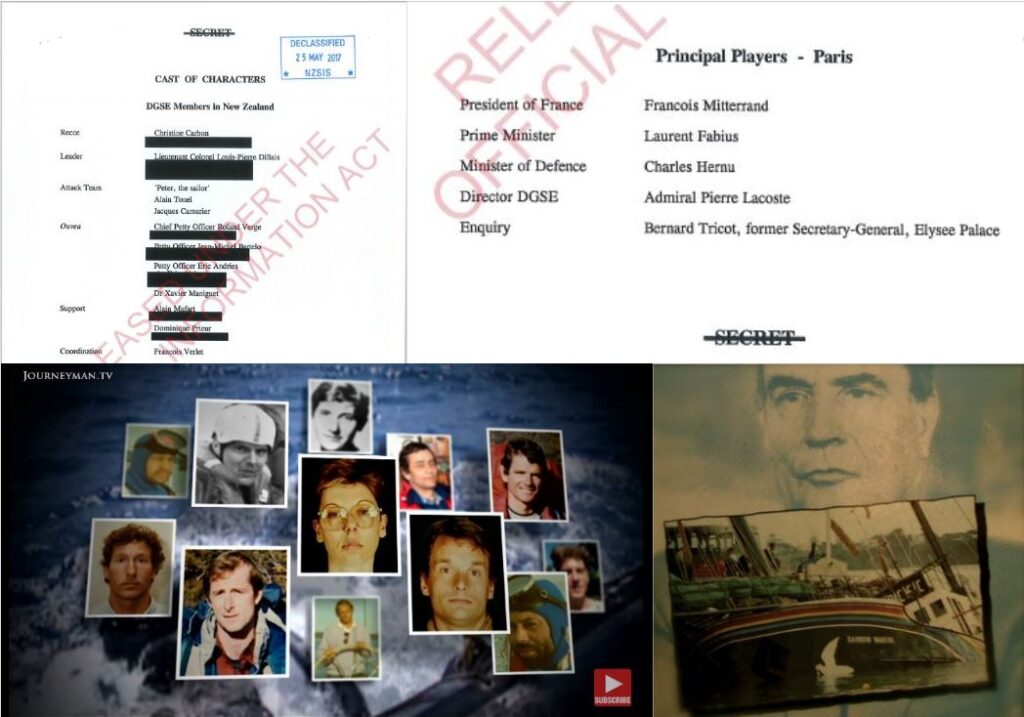

➼ The Phoney War Period
Among the most crucial early leads was the number plate of a Newman’s camper-van provided by two ‘vigilantes’ from the Auckland Outboard Boating Club at Mechanics Bay Marina.
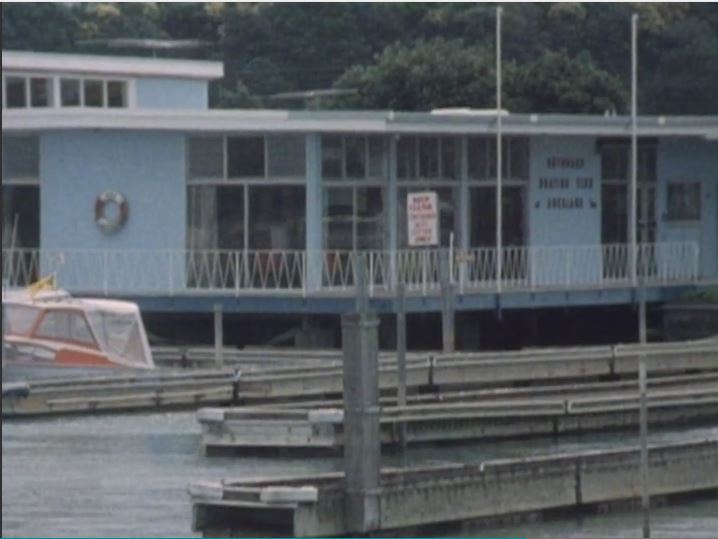
Two of the terrorists – Major Alain Mafart and Captain Dominique Prieur — who posed as Swiss honeymooners ‘Alain and Sophie Turenge’ — were the support team. Their role was to transport equipment between the Ouvéa yacht crew and the combat dive team, and pick up the divers after the bombs were set and drop them at a second camper-van parked near Auckland’s Harbour Bridge.
Three French-speaking men had been observed making an ill-timed rendevous with the Newman’s campervan at the shore of Mechanics Bay next to the boat-sheds, a few miles from the Ports of Auckland wharves. The Newman’s camper-van, driven by Major Mafart, had missed picking up the dive team, who had difficulty finding their way back in the dark.
When two ‘vigilante’ boaties from Auckland Outboard Boating Club shined a torchlight, the frogmen panicked and abandoned the Zodiac, and scrambled into the Newman’s campervan.
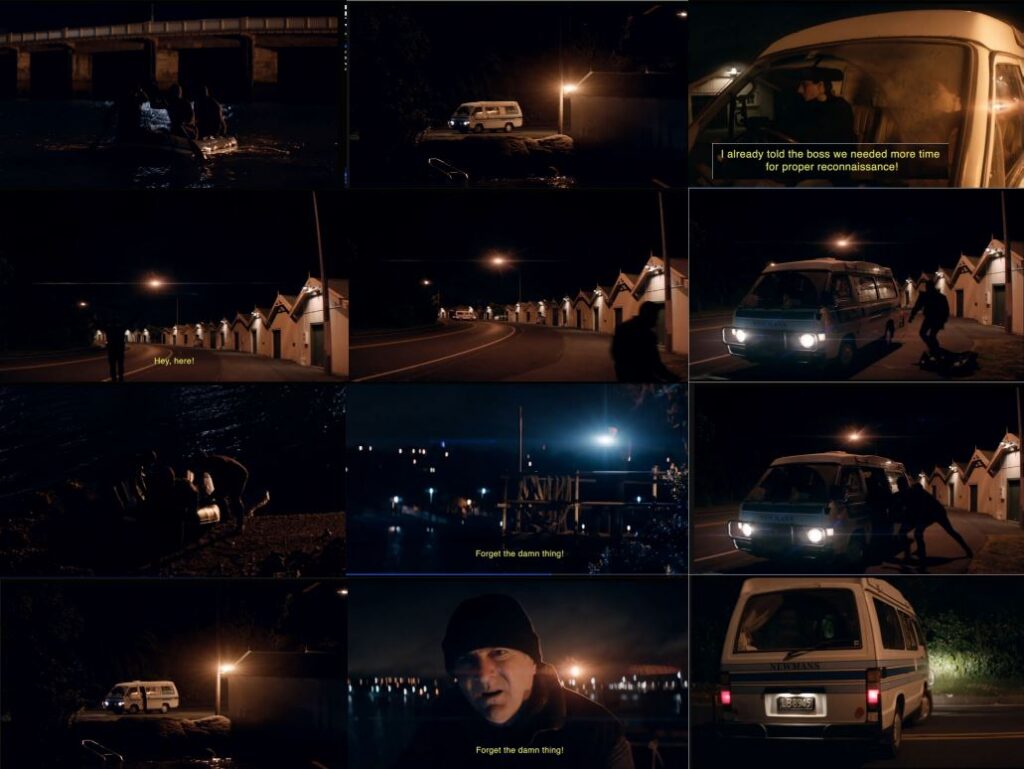
Amid news that a Police hunt was underway to catch the perpetrators of the bombing — that had escalated into homicide with the death of Pereira — Major Mafart and Captain Prieur changed their travel plan. Instead of laying low for another three days and leaving New Zealand via Wellington in their guise as Swiss honeymooners, ‘Alain and Sophie Turenge’, they attempted to return their rented camper-van at a Newman’s Travel Depot in Mt Wellington, Auckland, on July 12th.
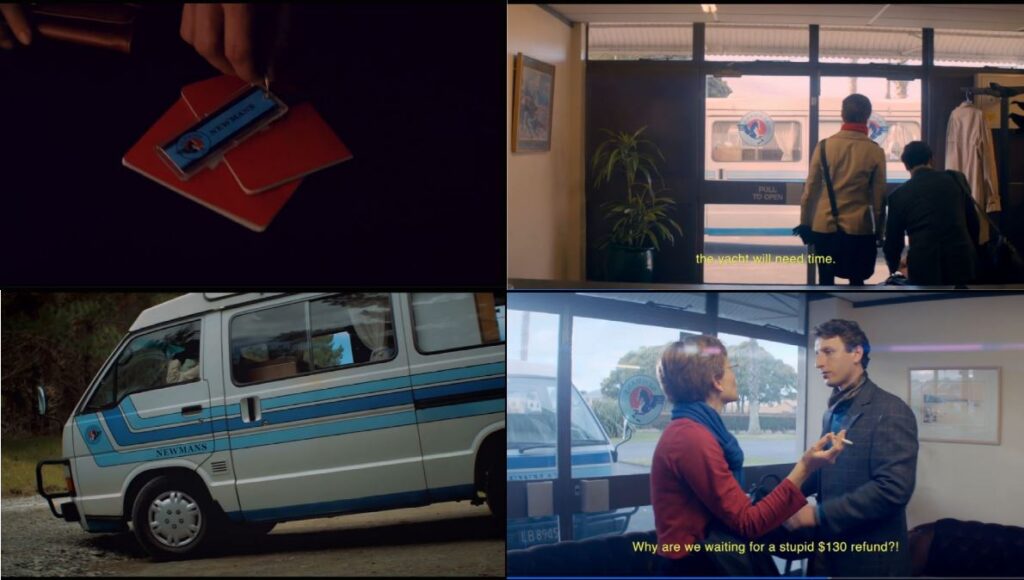
I believe the DGSE agents, Major Mafart and Captain Prieur, made an error in judgement to maintain their cover as budget-conscious ‘tourists’ rather than improvising their supporting roles as brazen ‘terrorists’.
Major Mafart, in particular, would have been well aware that a fatality was going to escalate the pressure for more resources assigned to such an investigation. The two agents could have presented themselves to the French consulate in Wellington and sought state immunity.
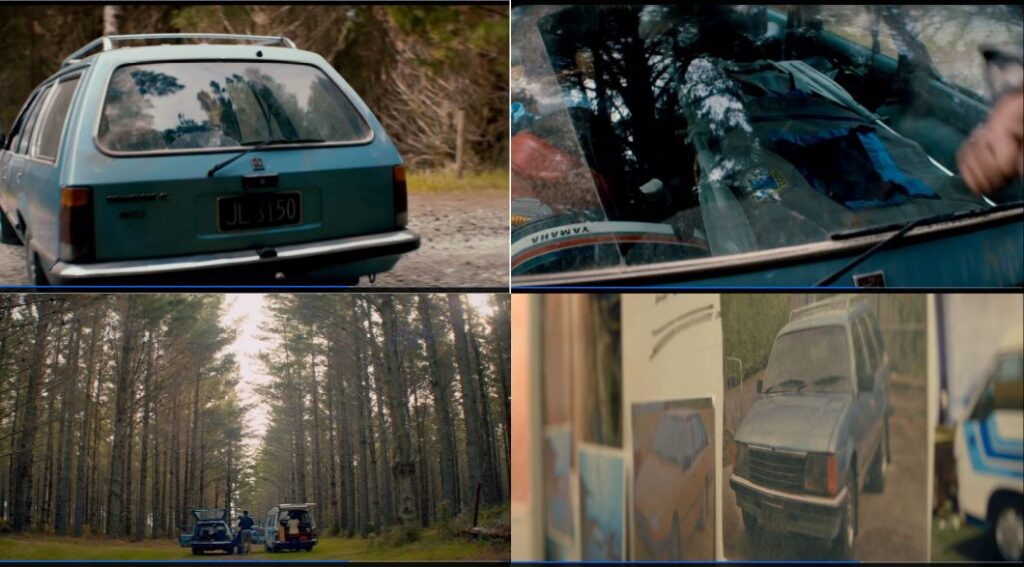
The two French DGSE agents made phone calls, with cover of telephoning a sick Uncle Emile, while they were detained by New Zealand Police at the Unicorn Motel in Auckland in mid-July to their headquarters in Paris. This error revealed the hubris of rushing the Sataniqué mission. New Zealand’s Security Intelligence Service bugged the room where the two agents — who posed as Swiss honeymooners ‘Alain and Sophie Turenge’ — while the Police played for time to determine if the passports they used were fake, and therefore could be formally arrested while more evidence could be gained to pin them to the sinking of Greenpeace’s Pacific flagship. Years later, Captain Prieur said on French TV that she was dumbfounded when Police told her the calls were traced to the DGSE because she thought the number was secure.
The Police investigation was led by former Scots Guards Detective Super-Intendant Allan Galbraith, whose background included a training stint in London with Scotland Yard’s Bomb Squad. Initially, Galbraith had 40 detectives assigned once navy divers had determined overnight that the blasts had been caused by explosives set on the exterior of the ship’s hull; in two places.
Detective Superintendant Galbraith had early breakthroughs that led to the discovery of the broad origins of 10/7 bomb plot. A French made Mark II light grey and black Zodiac had been left in haste at the shoreline in Mechanics Bay. Greenpeace members recalled a Frenchman, calling himself Francois Verlot, had visited the Rainbow Warrior on the evening of explosions.
Despite the laudable efforts of Galbraith and his team, which expanded to 66 and then approximately 100, they were thwarted by a deep state network across the New Zealand Crown apparatus that sought to consolidate power, as well as by the French Government, MI5 and the British, Australian and American Governments.
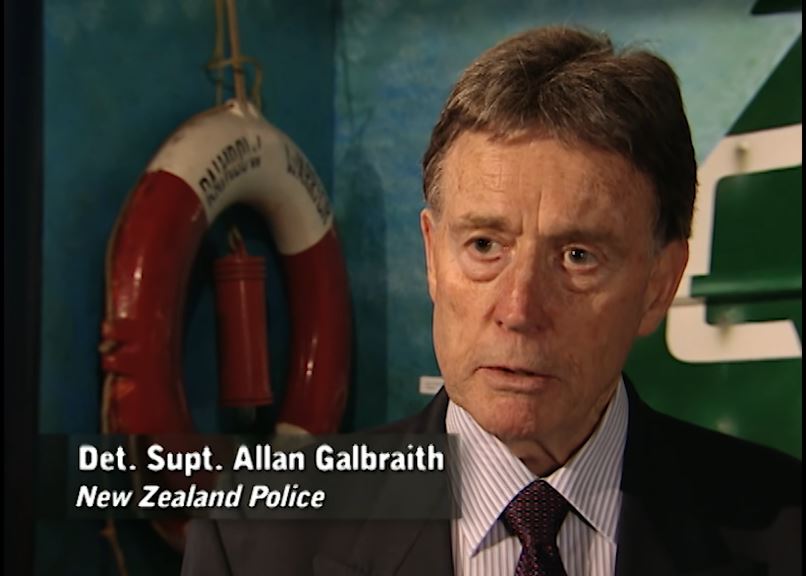
Indeed, within the New Zealand National Security State, the machinations of deep state bunnies is detectable.
The accounts of the head of the Prime Minister’s Department at the time, Gerald Hensley and the SIS, mention the number of times the Official Terrorism Committee met was 17.
Hensley claimed in a speech performed at the Stout Research Centre at Victoria University in 2004, that an Officials Terrorism Committee was established in 1983 that brought the departmental ministers and senior officials into a single body that would deal with any such crisis.
In May and June of 1985, the Officials Terrorism Committee met, and around July 2 of 1985 this committtee submitted a paper to the Cabinet Committee on Terrorism that recommended the establishment of a Terrorism Emergency Group (TEG). This Terrorism Emergency Group would be chaired by the Prime Minister, and would include Cabinet and Officials, and meet in the Civil Defence Command Headquarters. Evidently, the cabinet was due to meet on July 17th to make a decision before intelligence support staff were moved from the Police Headquarters to the Government’s Headquarters at the Beehive in Wellington.
According to Hensley, David Lange avoided chairing the new TEG machinery, and was merely briefed because evidently his preference was to “drop in”. (Years later, Lange’s speech writer, Margaret Pope said that the Prime Minister never trusted Hensley). Instead of the new Terrorism Emergency Group structure being activated, the prior Officials Terrorism Committee was used, which meant Hensley chaired the meetings.
Therefore, it would appear that when Hensley stated the Officials Terrorism Committee met 17 times over the course of the Rainbow Warrior affair, he was bragging about his role in the post-bombing cover-up. Indeed, the SIS stated there was no final report produced by this Officials Terrorism Committee.
Later, N.Z. Police claimed the SIS knew that French agents were active in the North Island of New Zealand, but that this information was not passed on to Police. SIS officials claim they argued to the Officials Terrorism Committee for a counter terrorism operation to establish the dimensions of the bomb plot. Especially, since there was the possibly that French DGSE agents were laying low in New Zealand – as the drama unfolded.
Due to this constriction over the investigation, the DGSE dive team, comprising Colonel Kister, Jean Cammas, and Gerard Royal were able to ski at Mount Cook/Aoraki amid the country’s biggest ever ‘manhunt’.
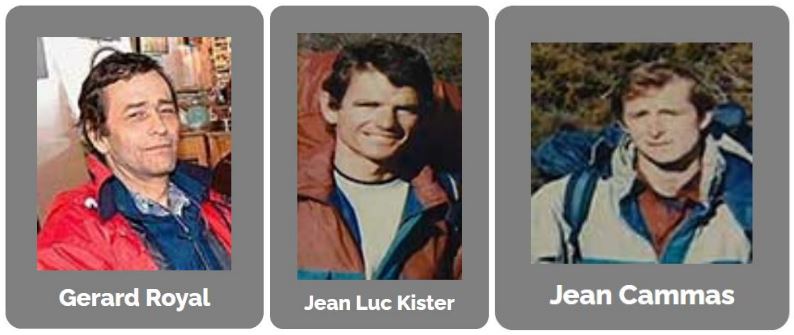
Suspiciously, it took months to ‘discover’ that the DGSE dive team had crossed the Cook Strait on 11 July 1985, to lay low in the South Island, despite their aliases appearing on the Cook Strait Arahura Ferry passenger manifest. Then, on July 26th Colonel Kister and Cammas flew out of Auckland after travelling via Wellington and Rotorua.
In the ‘secret’ SIS report written ten years after attack on Greenpeace’s flagship, ‘the Service’ seemed to fail to grasp the encoded symbolism was signalling to élites that the culture of Western Civilization was being re-coded with new language, images, and metaphor.
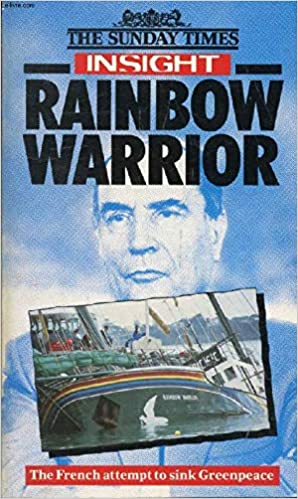
Yet, many have missed the French élite humour embedded throughout the Rainbow Warrior Bombing event and its aftermath, which signals France’s Ruling Class were never threatened by the scandal.
On the French side, President Mitterand ordered an inquiry at the witching hour of 1 a.m. on August 8 1985, ahead of two magazines set to publish exposés of French culpability later that morning.
A high ranking civil servant Bernard Tricot, who had been one of President Charles de Gaulle’s closest aides, seemed to signal that Tricot could spin a good yarn that would reinforce France’s independence as a major nuclear power.
Because President de Gaulle (1959-1969) had expelled NATO’s headquarters from Paris after he learned that the CIA had conspired with NATO’s secret units to assassinate him, President Mitterand’s choice of Tricot made it seem Tricot’s probe would penetrate the politics and reveal the truth.
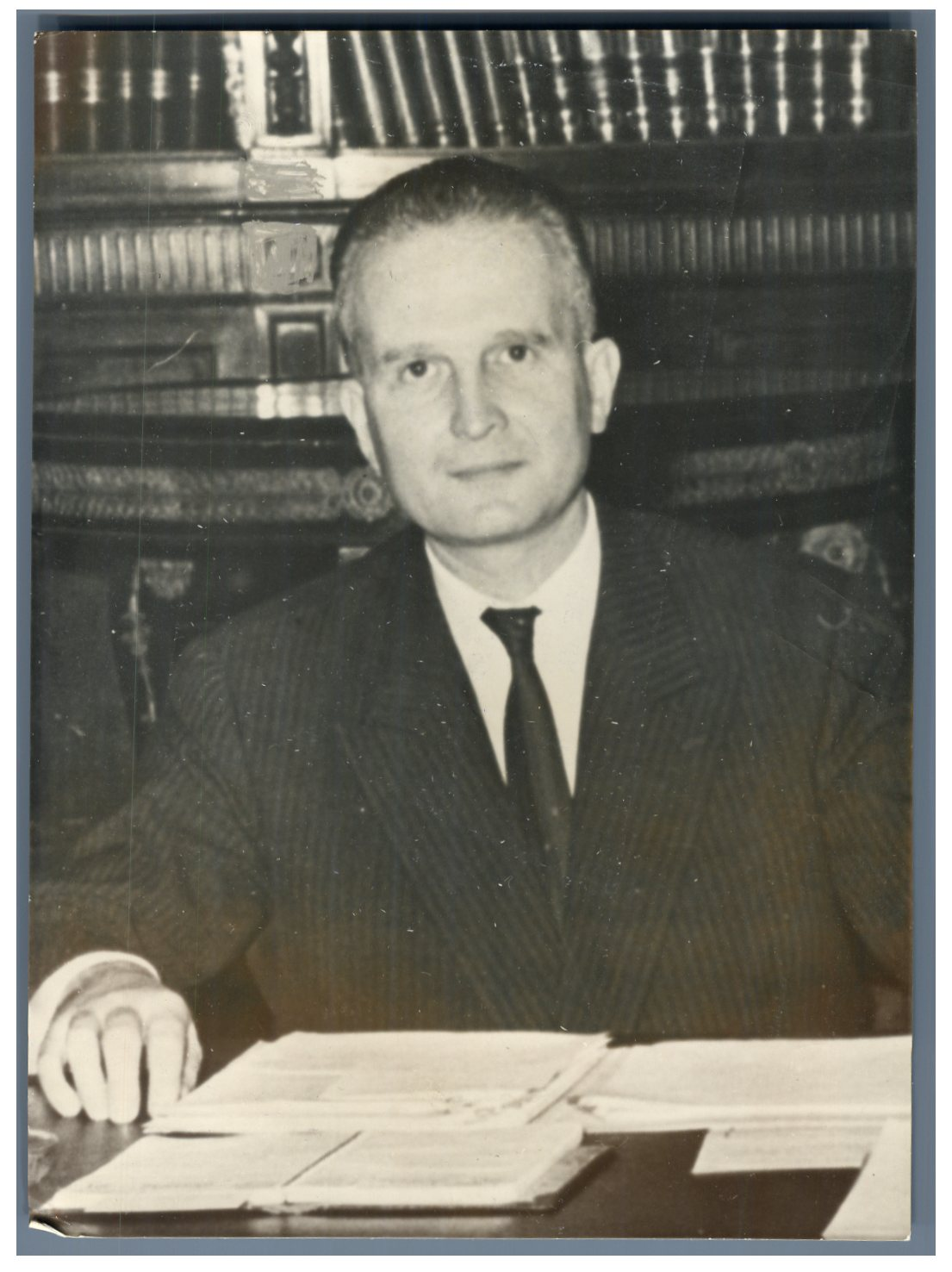
Tricot produced a whitewash report, spun from yarn designed to unravel and at staged moments, explode like ticking time bombs, with ritually offered scapegoats to defuse the scandal from escalating into a full-blown crisis.
The Tricot Report, published on August 26th 1985, not only maintained the cover-story that the French agents were in New Zealand merely to gather intelligence on Greenpeace by infiltration and reconnaissance. This was the first ticking time-bomb, because the report did not explain why an intelligence gathering mission targeting Greenpeace required French agents to use false passports. Tricot’s report also conveyed the view of DGSE Admiral Piere Lacoste, Defence Minister Charles Hernu and Admiral Henri Fages that the operatives had conducted their infiltration and reconnaissance mission in accordance with their instructions, which ultimately came from above the pay-grades of Lacoste, Hernu and Fages.
This was the second ticking time bomb.
If it later came to be proven that there was a third team — the combat divers – the ‘intelligence mission’ yarn would unravel, and the French Government would have to shift its narrative to a ‘sabotage mission’.
The heads of DGSE Admiral Piere Lacoste and Defence Minister Charles Hernu Hernu ‘rolled’ – as anticipated, three days after Le Monde newspaper exposed the existence of this DGSE’s combat diver team on Tuesday 17th September 1985.
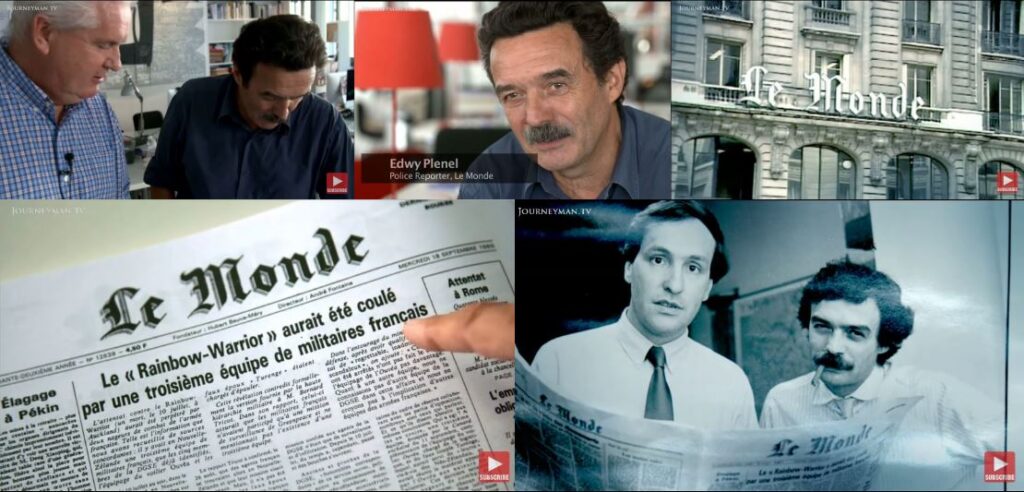
When the French Government activated this classic scape-goating mechanism, another layer of yarn would be used to pull the wool over the eyes of New Zealanders.
The élite French intelligence humour becomes evident when it is learned that Tricot in French means ‘knitting’. The insiders’ joke was that despite the complication of two terrorists facing trial for the murder of Fernando Pereira, the conspirators got away with the perfect crime because they achieved the over-arching objective to save the Western Empire from losing control of New Zealand.
Indeed, years later in a televised studio discussion, Captain Dominique Prieur likened an operation to a piece of knitting, and when one thread unravels the whole knitted garment falls to pieces.

The unexpected hitch of the Swiss honeymooners, ‘Alain and Sophie Turenge’ — being caught resulted in damage control to reduce the convictions, French threats to block New Zealand’s lamb, milk and goat meat exports and in a $13 million deal brokered by the United Nations, awarded to Greenpeace and the Government of New Zealand.
Brazenly, the French Ministry of Defence had encoded this ‘deep event’ with the signature prime number of French Templar Masonry: Thirteen. The primary number Thirteen symbolizes ‘unity and fraternal love’, and has long been used for ‘procuring marriage agreements’, as occultist Aleister Crowley stated in his book, Liber 777, and W. Wynn Westcott asserted in his work, Numbers: Their Occult Power and Mystic Virtues. Poignantly, President François Mitterrand’s brother, Jaques Mitterand, was the Grand Master of the Grand Orient de France, or French Templar Freemasonry, while the French President was a conservative Catholic educated by Jesuit teachers who applied a Jesuit education model.
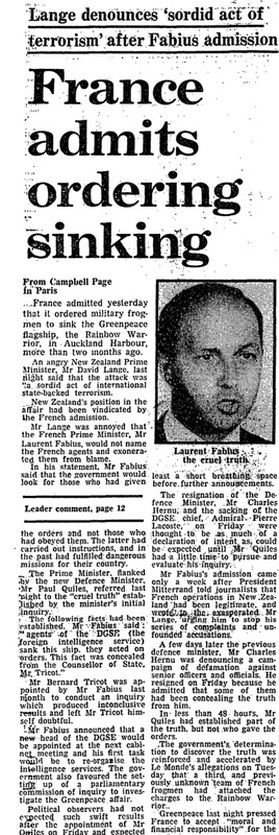
Because, as Gerald Hensley stated in Friendly Fire, without a major provocative shock to distract the anti-nuclear faction in Lange’s Labour Party from the free market economic guided by the Neo-Feudal faction, the Lange Government would have become too divided and lost the 1987 election. And, consequently the corporate takeover experiment would have un-ravelled; although Hensley didn’t state describe the economic reforms underway in such frank terms. Moreover, the Rainbow Warrior Bombing served the critical meta-objective to send a ‘price of power’ signal to the political puppets of the Western Empire to reign in the anti-nuclear activists.
Intriguingly, it was Gerald Hensley, who was head of the Lange’s Prime Minister’s Department, and who also chaired the Official Terrorism Committee, since Lange avoided activating the new Terrorist Emergency Group, that the Prime Minister would have been required to chair. Hensley stated in 2005, that just seven days after the attack that Lange approved a plan to confront the French Government. A file was forwarded to the New Zealand Embassy in Paris 10 days after the bombing and delivered to the ornate headquarters of France’s foreign ministry on the Quaid’Orsay.
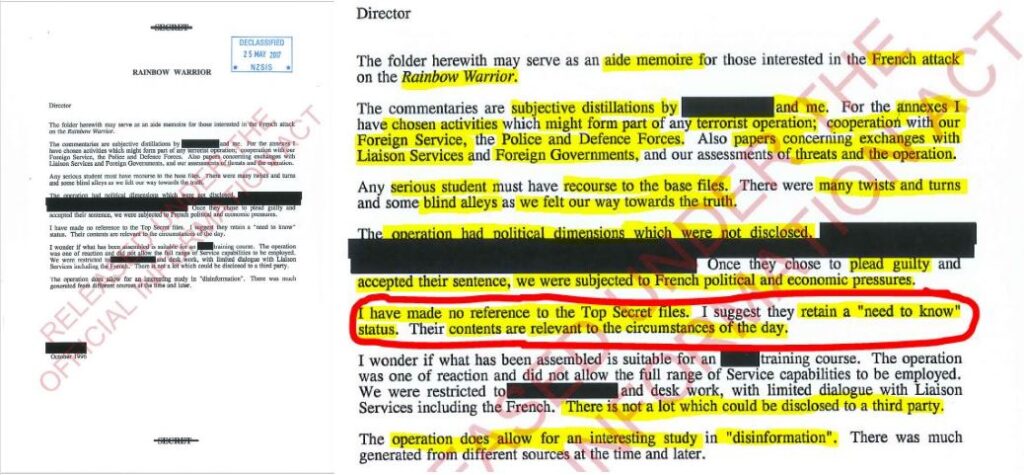
No report of the 17 emergency meetings were recorded and there was no debrief at the end. Lange had been running secret negotiations with the French to de-escalate the friction, since France had not anticipated any of its agents getting caught. In other words, Hensley managed a cover-up by ensuring there was no detailed minutes of Official Terrorism Committee emergency meetings, steering the probes away from thorough investigations and avoiding a debrief.
Traces of Hensley’s rabbit droppings are detectable in the sanitized, heavily redacted 1996 SIS summary report, which was finally declassified almost 32 years after the bombing.
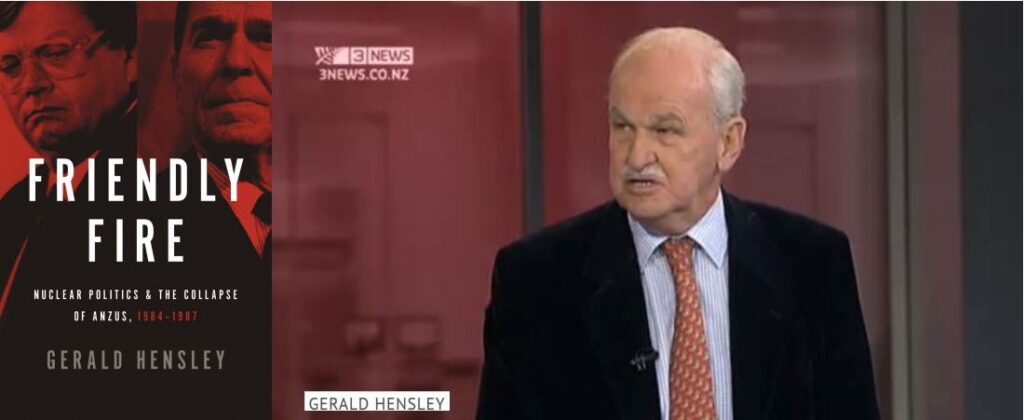
On November 4th 1985, a short depositions hearing took place in the Auckland High Court, over the charges laid against two French DGSE agents caught for their roles in the Rainbow Warrior Bombing.
While wearing his ‘institutional hat’ as New Zealand’s Solicitor-General, Paul Neazor, appeared in the High Court, where he construed the terrorism case against the two agents could not be proven.
With this rort, New Zealand’s Solicitor-General, Paul Neazor, reduced the charge of murder to manslaughter, and dropped the charge of conspiracy, while maintaining the crime of arson, in exchange for guilty pleas.
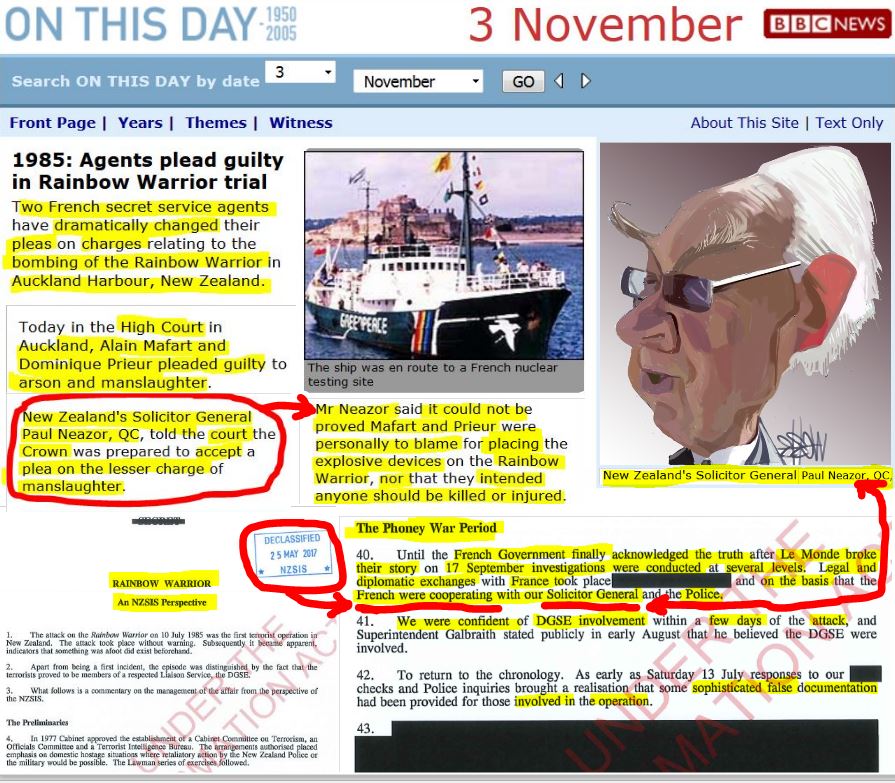
Police Det. Insp. Galbraith said the prosecution side was presented with this proposal a short time before the hearing. Thus, the defence weaponized time, in a situation where they didn’t have full control over the political space, in order to bend the jurisdiction in their favour.
Yet, the leading investigator, Allan Galbraith said they had enough evidence to gain the convictions. Galbraith said if they had the chance to present the full evidence, it would have shown exactly what the French had done. The prosecution had over a 100 witnesses.
Police Det. Insp. Maurice Whitlam, the second-in-charge of Operation Rainbow, recounted in the documentary Murder in the Pacific, that before the court hearing began, the defense argued that Mafart and Prieur did not plant the bombs and only helped by being couriers.
Yet, Major Alain Mafart had been was second-in-command of the DGSE’s underwater combat school in Corsica in the early 1980s, and he had also trained with a British commando unit, the Special Boat Service. I contend that a jury would view such professional capability as a sufficient to conclude beyond reasonable doubt that Major Mafart knew that secretly acting as the courier between the DGSE’s Action Team 1, the Ouvea Crew, and DGSE Action Team 3, the Dive Crew was for the purposes of sabotage, and terrorism. After all, it is implausible that Mafart, and Prieur, could not do see the calculus that underpinned delivering diving equipment, explosives and a zodiac to the Corsica trained Dive Team.
In other words, the French side had exploited the key weakness of New Zealand’s judicial system. Guilty pleas short-cuit a trial. This avoids a fuller comprehension and more evidence surfacing during a trial.
The French also exploited a key pervasiveness cultural weakness of New Zealanders. Kiwis give up when they are on the cusp of success, but face their biggest set-back. It was this key cultural weakness that filmmakers Peter Jackson and Costa Botes were exploring, more generally, in the 1995 mockumentary, Forgotten Silver.
In their book, The Rainbow Warrior Affair, Shears and Gidley recorded that at a press briefing on court procedure prior to the Auckland High Court hearing, a few of the 150 journalists present were uneasy. Not only did the briefing take place at the Hyatt Hotel where Lieutenant-Colonel Louis-Pierre Dillais had stayed while he directed the operation from his vantage point overlooking Marsden Wharf. The New Zealand Tourism and Publicity Department had a lady handing out brochures — “How to See New Zealand”, “Sightseeing Maps and Accommodation”, “Complete Visitors Guide” and “Auckland Great Time Guide” — while a Justice Department officials, two members of the Auckland District Law Society and a Police Chief Inspector attended.
It would seem that the 80 reporters from around the world and the 70 representing the local media missed the weaponized ironic humor that was encoded into the event, since titles of these brochure titles appeared to foreshadow the truncated court proceedings to follow. This, I believe, was the real reason why “something niggled” for a few journalists.
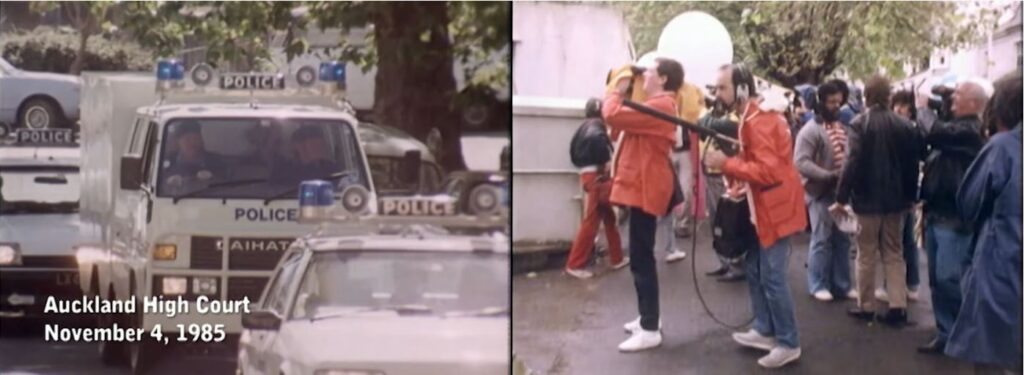
The signal being sent by the Deep State Snakes — who writhed and slithered in the institutions of New Zealand’s Crown — to the assembled journalists, was that they were to enjoy their stay and not bother to investigate the cover-up underway. The international and local journalists were being cajouled into bonding as tourists, instead of digging deeper into the story of two French terrorists, who were caught while pretending to be honey-mooning tourists 36 hours after the terrorist operation went awry due to a directive for a shortened four-hour time delay on the two bombs.
The language play on the tourist covers of terrorists and the joke of the Kiwi accent mangling vowels and butchering consonants, seemed to fly over the heads of the international and local media — as well as Greenpeace.
The ironic unexpected hitch of the two ‘Swiss honey-mooners’ being charged with murder, arson and conspiracy resulted in damage control to reduce the convictions. New Zealand’s Solicitor General, Paul Neazor QC, informed the Judge Ronald J. Gilbert that the two accused were prepared to plead guilty to the reduced charges of manslaughter.
Aptly, an Australian journalist shouted, “The fix is in!”

In the lead-up to the court hearing, Neazor had conducted what I call a ‘Thin End of the Wedge Ritual’ meeting with Police Commissioner Ken Thompson, Detective Superintendent Allan Galbraith, other senior police officers and Auckland Crown Solicitor David Morris. Prior to the Auckland High Court deposition hearing of November 4 1985, the New Zealand’s Government capitulated to French Government coercion.
For one thing, the Officials Terrorism Committee had constrained the scope of investigation from the outset to focus on prosecution of the two apprehended ‘tourists’, rather than cast a wider net to catch the other French Agents still in the country. In other words, from the outset the echelon of the New Zealand Crown had acted as puppets on the strings of French State-sponsored terrorism.
The New Zealand Crown assisted the French, American and British governments in a cover-up that produced a ‘copy of reality’, that would have New Zealanders believe that because the primary target of the attack was Greenpeace, that is all there was to the plot.
This bunk belief is a fundamental failure to comprehend the function of “terrorism is theater”.
However, preventing the Rainbow Warrior from serving as the mothership in the Mururoa Campaign — with its capacity to transmit photographs and radio commentary — was the immediate objective.

The bigger objective was intended to signal to other Western countries that there was price to pay for allowing activists to run amok, with effective interventionist direct actions that created news-grabbing attention.
After-all, it was the French Defence Minister, Charles Hernu, who opted for a bombing over contaminating the fuel, because he wanted dramatic images. Thus, not only was the Rainbow Warrior selected for attack to prevent it creating bad optics. But, Lange’s Government was also a target in this episode of terror theater.
A former U.S. Special Operations Officer, Brian Michael Jenkins, coined this phrase — ‘terrorism is theater” — meaning the real targets of terrorism are not the victims, but the audience. Jenkins made this observation in 1973-74, while working as a Research Analyst in Terrorism at the Rand Corporation — a key American think-tank, where game theory strategies were developed during the ‘Cold War’ to stabilize the power structures of the Soviet Empire and the Western Empire.
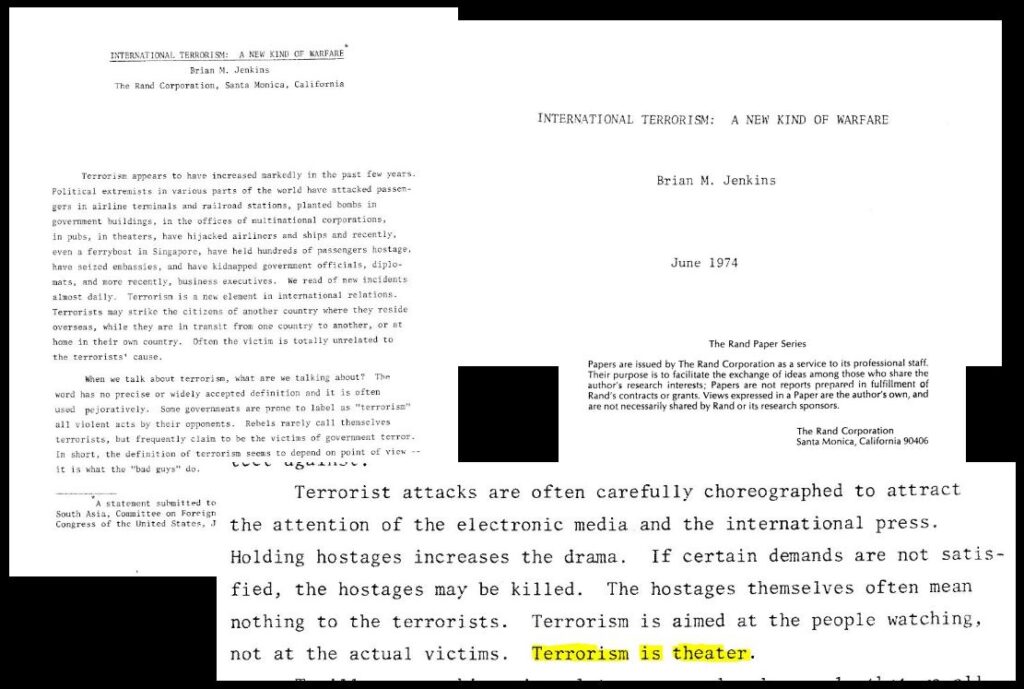
Once this copy of reality was embarked upon, conspiring players performed a theatre of contrived ignorance.
In his 2007 book, Legal Ethics and Human Dignity, and in his paper “Contrived Ignorance”, published in The Georgetown Law Journal in 1999, David Luban modelled the “Structure of Contrived Ignorance”. He saw screening actions and so-called unwitting misdeeds as a unitary whole rather than separated by time-frames. He proposed viewing the version of the self that wittingly performed screening actions to preserve her own oblivion as the principle actor, while the agent is the later self at the time of the unwitting misdeed, who effectively ratifies the earlier self’s choice to compartmentalize, or screen off, potential knowledge of wrongdoing.
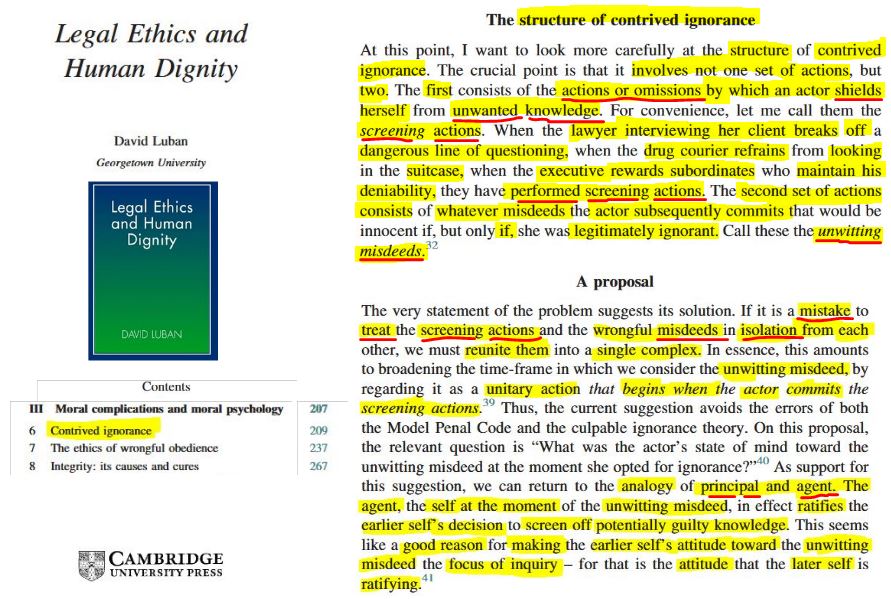
In making his point that, “in criminal law, wilful ignorance is ground for conviction, rather than acquittal,” Luban was in essence, laying out the gaps in catching and convicting group enterprises that contrive ignorance. A quote he drew from a U.S. trial seems apt for this case study of French Templar-Jesuit Masonic Neo-Feudal state terrorism:
“Ostriches … are not merely careless birds.”
N.Z. Solicitor General Paul Neazor and Police Commissioner Ken Thompson were, in fact, performing unwitting misdeeds that they, and others, were complicit in authoring. As principals among N.Z.’s National Security State apparatus, I contend they had authored screening actions that would result in predictable unwitting misdeeds.
In this case, the early constriction over the scope of the investigation followed the 36-hour delay to convene the Officials Terrorism Committee. The French combat dive team would not be caught because there was no political will to do so among the top echelon of the National Security State apparatus. This meant Neazor could construe it was not credible to gain murder convictions because the Crown could not prove Major Mafart and Captain Prieur knew details of where the bombs would be placed and other details about the limpet mines, and therefore, the likeliness that there would be loss of life. Similarly, the Solicitor General could construe that the two accused French DGSE agents could not be charged with conspiracy because he claimed the Crown could not prove exactly what they knew about the bomb plot.

Having announced the reduced charge of manslaughter, Paul Neazor framed the case as one that was to be focussed on the criminal responsibility in New Zealand law of the two accused. In this deviously skillful way, Neazor dismissed “larger questions [that] arise from the sinking of the Rainbow Warrior”, by performing an Innoculation Ritual. Innoculation tactics are exploited by public relations and crisis management industries, wherein the weakness of a position is briefly acknowledging and then the propagandist quickly moves on. The intention is that news audiences will think nothing more of the matter.
“Ostriches … are not merely careless birds.”
To this contrived ignorance end, the presiding judge, Ronald Gilbert accepted the summary of evidence to stand, rather than demanding a presentation of top secret base files, top secret reports and a calling of witnesses from across the National Security State apparatus.
The Crown’s executive structure of contrived ignorance in the Rainbow Warrior Affair worked to construct this Thin End of the Wedge court proceeding, because its well-placed slytherine agents remained loyal to the hidden objectives of Opération Sataniqué.
And, because the accused French secret service agents admitted guilt to these reduced charges, there was no trial that might have revealed the damage control by the Lange Government.
In any other country — except New Zealand — the act of being two French Secret Service agents traveling to the territory of an Allied Nation, delivering explosives, diving equipment and a Zodiac and picking up the divers after the target has been bombed is clear evidence of conspiracy to commit terrorism, murder and arson. Because bombs are indiscriminate, murder was a risk of the operation, no matter the factors to mitigate the loss of life.
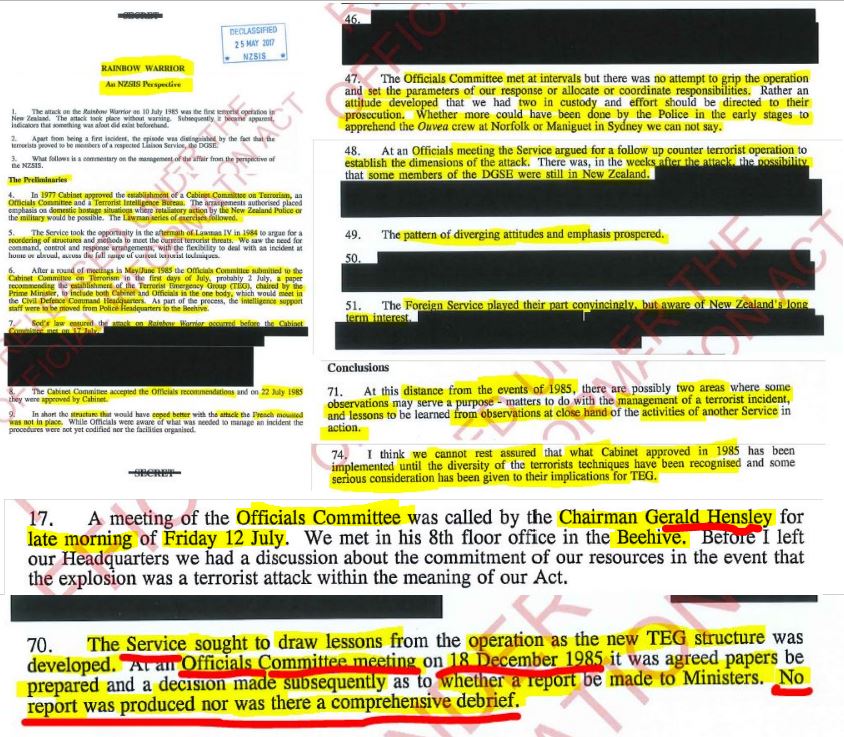
Because matters inevitably go awry in complex criminal plots, the crises that erupt see key players escalate prior behaviours and become pretty transparent on the surface as messy Deep State rabbit droppings.
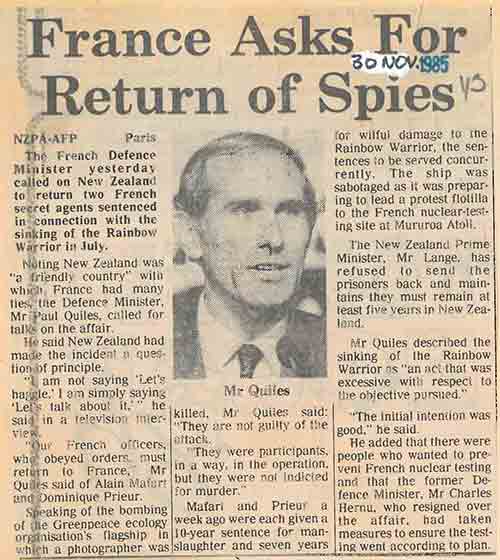
The French Government threatened the New Zealand Government to block lamb and butter trade in the lead up to the trial. Lange had initially point blank refused to deport Captain Prieur and Major Mafart when they were sentenced for 10 years imprisonment on November 22 1985, by Ronald Keith Davison.
In retaliation, in January 1986, French External Trade Minister inflicted economic warfare, blocking New Zealand’s exports, notably lambs’ brains, and threatened again to to block N.Z.’s vital access to the British lamb and butter market with its veto powers at an upcoming European Economic Community (EEC) round in the Belgium city of Brussels. Outwardly, Lange played the part of a principled politician, while he kept negotiations between his private secretary, Christopher Beeby, and the French Government secret, and most of his cabinet did not learn of them until they were well-advanced.
However, Lange’s deportation refusal was theatre, too, since he had been running secret negotiations with the French to limit the fall-out.
In June 1986, Lange formally announced the dispute would be mediated by United Nations Secretary-General Javier Perez de Cuellar, who prepared a report, “Case concerning the differences between New Zealand and France arising from the Rainbow Warrior Affair”, published on July 6th 1986.
On June 27 1986, David Lange met with U.S. Secretary of State George Schultz, while in Manila for the ASEAN Summit. After meeting Lange, Schultz pronounced New Zealand’s suspension from Anzus, saying “We part company as friends, but we part company as far as the alliance is concerned.”
Thus, the Rainbow Warrior bomb plot was in effect book-ended by Lange’s encounters with U.S. Secretary of State George Schultz. The ANZUS rift became a chasm. The ‘compensation’ sum of $13 million was settled upon for the French state’s terrorist attack, in exchange for Mafart and Prieur being subjected to ‘house arrest’ for three years at a French base on Hao Atoll, dubbed a military ‘Club Med’ resort.
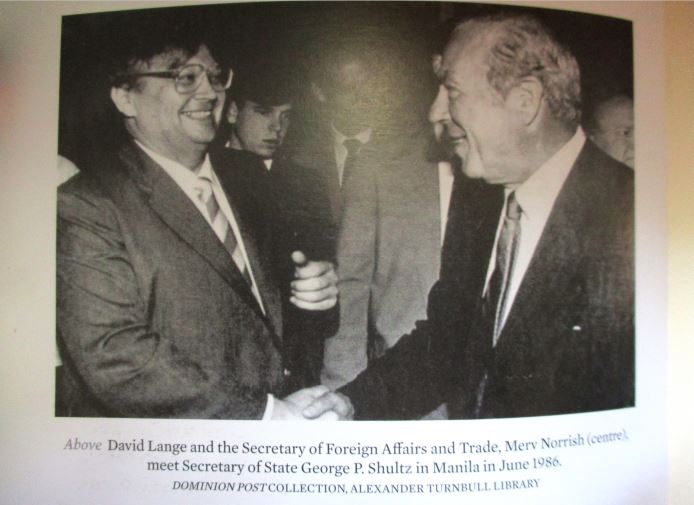
Essentially, the United Nations had recast itself as traffic cop, by issuing a $13 million ticket to a NATO-member nuclear power for getting caught inflicting state-sponsored terrorism within a U.N. member nation jurisdiction without a resolution from the U.N.’s security council. The United Nations had, therefore, mirrored the Western Alliance’s accommodating attitude to this episode of French state terrorism as had the Lange Government after New Zealand’s prime minister had accommodated the French DGSE agents’ clandestine activities — before and after the 10/7 bombing of the Rainbow Warrior.
Precisely two years after the Auckland High Court became a theater for condoning the terrorism of a Western Alliance nation, on November 4th 1987, New Zealand’s little known Government Communications Security Bureau (GCSB) gained Prime Minister David Lange’s approval to purchase a site for a satellite interceptions station at Waihopai, near Blenheim. In the press conference, Lange claimed the then little-known intelligence-gathering agency called the Government Communications Security Bureau (GCSB), needed to fill the gap in lost intelligence that supposedly occurred following the political fall-out with the United States over the ANZUS Alliance.
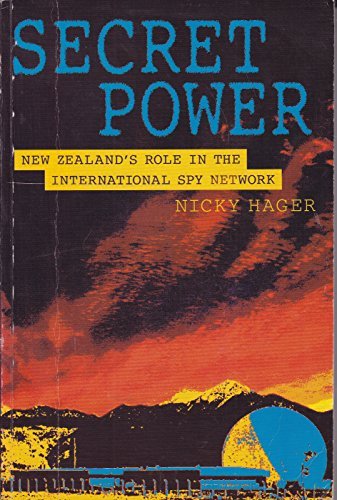
Yet, the planning for a new satellite interception station had been proceeding “in tandem” with the Geraldton Station in Western Australia for “some years … in secret” by the time Lange approved the purchase of the Waihopai site on November 4th 1987, as Nicky Hager observed in his seminal 1996 book on the GCSB, Secret Power: New Zealand’s Role in the International Spy Network.
A little more history of the GCSB reveals a global imperial system of manufacturing consent with engineered controversy.
Hager noted that a May 1988 NZ Listener article, quoted an Australian intelligence source who said that by building the Waihopai Station, New Zealand was “paying its membership to the intelligence club”.
In the second half of 1984 (or possibly) in early 1985, the GCSB hosted the directors of the ECHELON agencies, according to Nicky Hager. And also that in late 1984, a US National Security officer, Glen Singleton, was appointed as the GCSB’s Deputy Director of Policy and Plans in Wellington.
The secondment of a US National Security officer to the GCSB’s Freyberg Building in New Zealand’s capital city prior to the official and contrived ‘fall-out’ between the Lange and Reagan Governments over U.S. nuclear ship and submarine visits in February 1985, is intriguing. Hager noted that at the same time Glen Singleton was appointed as the GCSB’s Deputy Director of Policy and Plans in Wellington, Warren Tucker was seconded to Washington amid rising tensions over the ANZUS Alliance and Lange Government’s election mandate to legislate New Zealand as a nuclear-free territory.
Hager said bureaucrats really believed once the Lange Government were in power, they change their stance over the nuclear issue. Because Hager had failed to read up on the game theory — as developed by the Rand Corporation during the ‘Cold War’ — while researching Secret Power, the former anti-nuclear activist missed the reciprocal Singleton-Tucker appointments as hostage exchanges to stabilize relations while the respective power structures underwent change.
Especially, since the theatrical quality that underscored three political conflicts in the mid-1980s — the U.S. nuclear powered and armed warships, the ANZUS military alliance, and the bombing of Greenpeace’s Rainbow Warrior — came packaged with ironic weaponized metaphors, as I have proven.
The strategy of tension in-built into Opération Sataniqué can be seen as a deus ex machina plot device since the unexpected bombing of 10/7 in 1985 was designed with an innovative Trojan Seahorse twist. And even though the mission went awry when the two DGSE agents were caught, the Operation Satanic still worked to achieve its primary objective. The orgie of evidence left by the French DGSE, produced a detectable ‘Morse Code’, that signalled Operation Satanic was designed to save the Fifth République Françoise from losing the legitimacy to possess a doomsday device.
Significantly, Trojan Horse has come to mean a mythological metaphor element derived from the Trojan War that symbolizes subterfuge, or trickery.
In the story of the final capture of Troy, the Trojan Horse plot called for one Greek soldier, Sinon, to voluntarily stay behind and pretend as though he had been abandoned, and sacrificed to the sea powers, in order to explain that the Greeks had given up on their siege of Troy. Helpfully, the Greeks had also left an explanatory note with their parting gift horse, which read, “For their return home, the Greeks dedicate this offering to Athena” [the Greek goddess of war, wisdom and handcrafts].
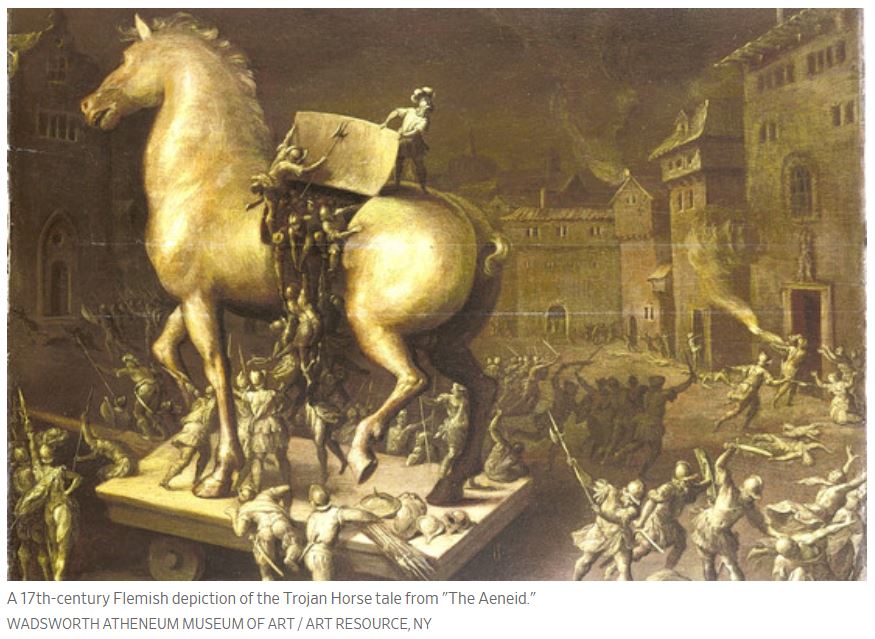
According to the epic poet Virgil, Sinon convinces the Trojans that the Greek Army has left, while Homer has it that Helen of Troy sees through the plot, as does King Piriam’s daughter Cassandra, but like Helen of Troy, she too is ignored by the ruling patriarchy. Sinon spins the lie that the Horse is an atonement offering to the goddess Athena as redress for the desecration of her temple at Troy by the Greeks, and to ensure the Greek fleet were un-harried on their homeward journey.
Crucially, all state-sponsored terrorist operations contain hidden objectives. For example, the ‘strategy of tension’ packaged into Operation Gladio — the umbrella code-name for the low-grade war inflicted in Western Europe by every NATO country during the Cold War — was designed to shift the political centre of gravity away from the ‘socialism’ to ‘capitalism’.
Because the journalists who wrote books in the aftermath — such as Rainbow Warrior: The French Attempt to Sink Greenpeace, The Rainbow Warrior Affair and Sink the Rainbow! An Enquiry into the ‘Greenpeace Affair’ — did not know about NATO’s secret low-grade war inflicted across Western Europe, starting with Italy in 1947, the full dimensions of the Rainbow Warrior Bombing remained obscured.
The connection between the militant orders of the Vatican, British, French and American Masonic and Chivalrous Orders – with the intelligence agencies, security services and military special forces who had been inflicting Operation Gladio with impunity until its discovery in 1990, has remained largely unknown to the farmed humans of Nouvelle-Zélande Royaumez.
If, for instance, it was widely known at the time of Rainbow Warrior Bombing that in 1947, the CIA had cut a deal with Pope Pius VII to supply black funds from heroin to bankroll the Christian Democrats to beat off the Italian Communist Party winning the 1948 election, and in return the Holy See would protect the CIA’s most sensitive documents, New Zealanders might have been more than suspicious. Especially since the Catholic President of the United States, Ronald Reagan, said nothing to admonish his French counterpart, President Mitterand, the conservative Jesuit-educated Catholic, whose brother, Jaques, was the Grand Master of the Grand Orient de France, or French Templar Freemasonry.
Nor was Mitterand’s close friend, Defense Minister Charles Hernu, a Catholic Freemason, admonished by the US Secretary of Defense, Caspar Weinberger. Curiously, Reagan’s Secretary of Defense became a knight in 1988, when Queen Elizabeth II awarded him a Knight Grand Cross of the Order of the British Empire.
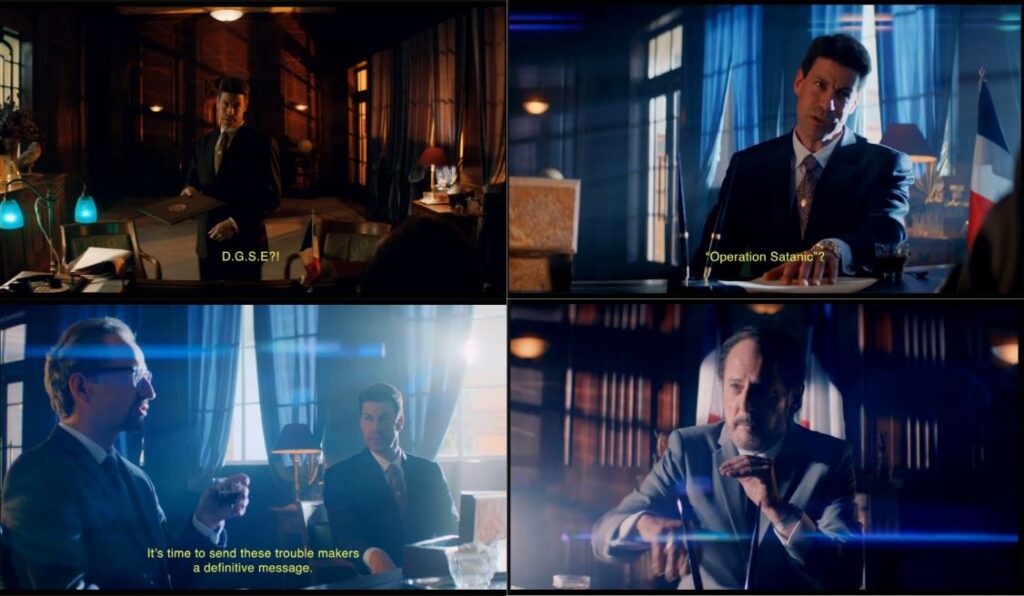
The deep Jesuit-Masonic links between the American, French, British and Vatican empires reveal the reach of the Brotherhoods.
It would appear that ‘The West’ is an expansionist Universal Empire that has been remarkably resilient at staving off its total collapse by invading the territories of other Empires.
In doing so, of the West’s oligarchies, or coalitions of the super-rich, have been very successful at harnessing an Age of Conflict as a means to enter a new Age of Expansion by periodically moving the centre of operations from the Empire’s core to a peripheral state. What makes Western Civilization unique, stated historian Carroll Quigley, is that it has transitioned from “Stage 3: Expansion” to “Stage 4: Age of Conflict” three times. These three Ages of Conflict have been the Hundred Years’ War (1300-1430), the Second Hundred Years’ War (1650-1815) and the War Crisis of 1900-1999.
A neat trick had occurred.
On David Lange’s watch, the Officials Terrorism Committee constrained the scope of the investigation, while elements within the National Security State controlled resources and the Queen of New Zealand who was also the Commander in Chief of the British Armed Forces, including MI6, took no action to authorize NZ Police the jurisdiction detain the crew of Ouvéa while the evidence was forensically examined. The Lange Government were engaged in obstruction, subterfuge and emotional hijacking to limit the fallout with the French and the Western Alliance, while appearing to fully resource law enforcement capture as many DGSE agents as possible.
Because the ‘orgie of evidence’ included the symbolism of the French DSGE agents staying at Lange’s Hinemoa Motel unit, this element of Operation Satanique seemed to intentionally signal both a promise and a threat. The mission planners appeared to signal accommodation of New Zealand’s domestic political situation, that necessitated political theatrics in the form of terrorism to swing the electorate back into the Neo-Feudal Labour camp, amid the backlash against the corporate heist of the economy.
After-all, America had accommodated France’s tricky domestic relationship after De Gaul had expelled NATO’s HQ from Paris in 1966. It also signalled a threat in the sense that Lange was being warned to play along with the political theater, it seemed.
These facts are borne out by the fact that neither the US or UK Government condemned the attack after French culpability was proven, as Lange noticed. These two other Western nuclear powers appeared to have skin in the game. In a TVNZ documentary, Death of the Rainbow Warrior, news anchor Dougall Stevenson observed this lack of condemnation. Lange told TVNZ there was a solidarity between the big powers, who wielded a nuclear deterrent capacity, and those big powers perceived they had no need to be supportive of a small power principle. Therefore, the French were well aware that the Reagan’s Administration’s ‘accommodation’ of Lange’s domestic situation was wearing thin.
Indeed, when David Lange met the U.S. Secretary of State, George Schultz at Ohakea Air Force Base to discuss the ANZUS military alliance the morning day after the 1984 election, the Prime Minister-elect evidently told Mr Schultz that he needed six months to resolve the issues to everyone satisfaction. On the TVNZ current affairs program, Frontline, Five Days in July, Schultz told journalist Richard Harman 10 years later that he reported to President Reagan his conversation with Lange. Schulz added that:
“We gave time. We didn’t precipitate anything. And we were ready to, try to make an accommodation as we did with other countries.”
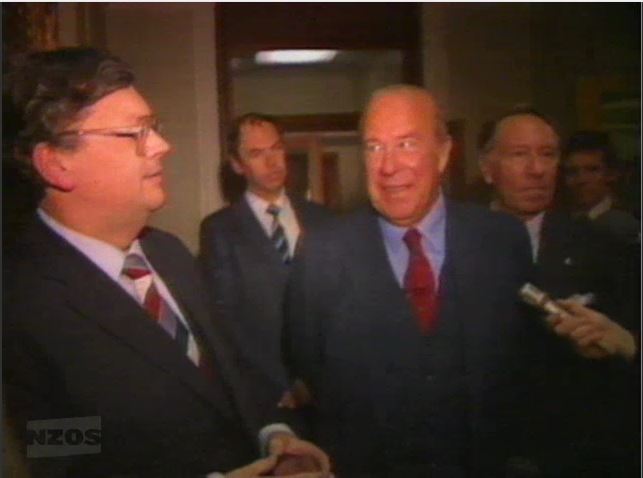
Ergo, the subtext indicated a ticking clock. When it stopped, Lange had been subjected to an Excommunication Ritual, led through the kitchen of the Ambassador Hotel where the RFK Assassination occurred, and after his famous anti-nuclear rhetoric at Oxford University March 1 1985, and New Zealanders would wake up to news that their South Pacific archipelago was not immune to international terrorism.
Thus, I contend that key officials of the Five Eyes were made aware that France had also ran out of patience and decided that it was time for David Lange to accommodate the French DGSE.
After all, MI5 learned the French DGSE were planning a sting because New Zealand to foil a gun-running ring to Melanesians in French New Caledonia. And in the Northern spring of 1985, the Joint Intelligence Committee, Whitehall in London was told in May that a French plot would play out in New Zealand. And MI5 had observed the arrival of the fake Swiss honey-mooners in London en route to New Zealand.
Recall that Major Mafart was well known to British intelligence, since he had trained with a British commando unit, the Special Boat Service. Despite the GCSB receiving Whitehall’s weekly minutes of the Joint Intelligence Committee, this secret intelligence agency — that was unregulated until 1996 — did not provide any intelligence warning of an impending French attack or suspicious operation occurring in New Zealand, as Nicky Hager observed in his 1996 book, Secret Power: New Zealand’s Role in the International Spy Network.
However, the striking departure of Opération Sataniqué from Operation Gladio was that the mission was not designed with a false flag plot element. The author of The Spectacle of the False Flag: Parapolitics from JFK to Watergate, Eric Wilson views false flag deep events as exhibitions of spectacular power to effect an enduring severance between the visible Public State and the Deep State’s invisible national security complex.
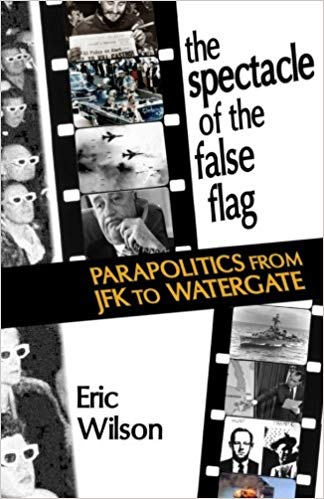
The Monash University senior lecturer of public international law states that the spectacular power of a false flag deep event is that the spectacle is unifying, yet totalitarian in nature, because it short circuits transparent, open government and resets a nation onto a fully-fledged Police State path and beyond.
Since New Zealand Public State officials so easiliy and willingly bent to the longer range viewpoint of the National Security State, this capitulation not only implied the Lange Government was already compromised. Lange’s Cabinet had, after all, ratified the economic warfare inflicted as a result of the political-financial coup d’état of July 1984. But, the behaviours and performances of the pro-ANZUS/pro-nuclear faction that coerced capitulation so readily from the get-go, indicates that there were elements of that faction who were privy to the planning of the Rainbow Warrior bomb plot.
In his book, The Spectacle of the False Flag, Wilson emphasizes the need to identify the battling factions who wage civil battles beyond the public state’s legal boundaries.
The contrast between the apparent codified communications and the emotional roil conveyed in dramatic news bulletins could not have been lost on the intelligence agencies throughout the Western Alliance — who were, or would soon be, privy to the mission code-name, Opération Sataniqué.
Mitterrand and Hernu planned a military base in French New Caledonia with a three kilometre runway, and 300 metre wharf at a nearby bay to accommodate naval vessels, including nuclear submarines. Such a base would support the American Empire’s presence in the Pacific, to counter the Russian Soviet Empire’s influence in the region.
Domestically, the challenges for the French state were factional tensions within the intelligence, defence and political branches, because Mitterand’s Government was of a socialist brand.
Meanwhile, the ‘Fifth Republic’ was playing a geo-political chess move as a second-tier power within the Western Alliance that held together the closet Anglo-American Empire. In other words, Mitterrand and Hernu were sending a geo-political signal that France was willing to build a base to accommodate nuclear terror as a balance of military power to the Soviet Empire, where New Zealand, with its numerous deep harbours, could have — but for its pesky peace-niks.
The French DGSE were using the ‘theatre scene’ in a London marine shop to communicate to political élites that the ‘price of power’ for nations of the Western Empire included the capacity to be cut out of the intelligence loop. Moreover, such state-sponsored terrorism could reach into the hotel rooms of travelling prime ministers, premieres and presidents.
Therefore, the threat was also codified for deciphering by New Zealand’s Officials Committee for Domestic and External Security Co-ordination (ODESC), which was activated on July 12, once Major Mafart and Captain Prieur were in custody. If an intelligence agency audience found itself ‘hearing’ of this ‘theatre scene’ too late to catch all the culprits, let alone stop the mission, this meant such agencies, and their governments and ruling classes, were on notice, that they had, in effect, been consigned to a ‘politically deaf community’.
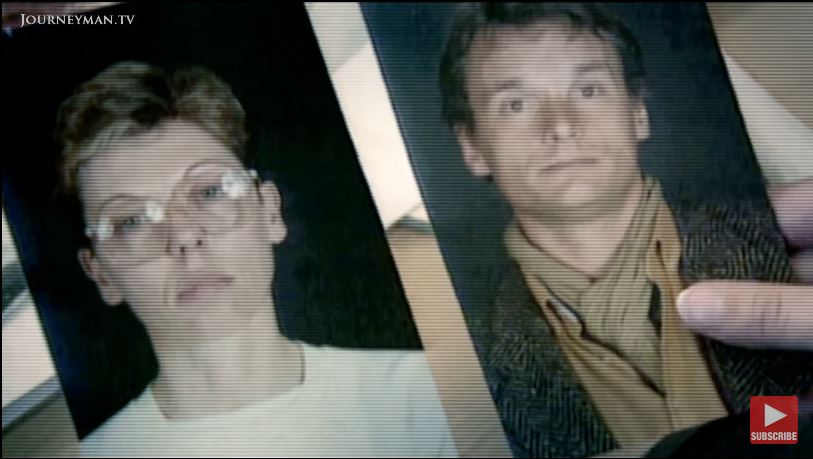
The Lange Government of New Zealand was being dealt a stiff lesson in ‘sign language’.
New Zealand’s SIS would have it that MI5 did not tell them. The declassified SIS report of 1996 said ‘the Service’ could have investigated further and encouraged the French to abort their mission, or conducted counter-surveillance and caught the team before they reached their target. These ‘menu options’ skirt the issue of why the SIS took until 2017 to release this sanitized report. The reason is because the report is riddled with logical flaws, just as the French operational cover-stories were.
Moreover, its belated appearance which mentions the sanitized in effect has top secret reports and base files, which also leads to the question: what else is missing? Because, the event of this report Rainbow Warrior — An SIS Perspective, only surfaced almost 32 years after the bombing, as a result of a Greenpeace making a request under the Official Information Act. Where are the top secret reports from New Zealand’s Intelligence Council, Officials Terrorism Committee and Terrorism Emergency Group, Police and the Anti-Terrorism Squad, Aviation Security Service, Government Communications Security Service (GCSB) and the Whitehall Joint Intelligence Committee?
The stiff ‘sign language’ lesson being dealt to the Lange Government and in turn to Western elites, including law enforcement, is worth recounting because its elemental parts reveal a meta-script that became a meta-narrative packaged with meta-objectives. The sign language included the ‘theatre scene’ in a London marine shop involving a DGSE agent, with a flimsy cover of a French tourist who couldn’t speak English, purchasing a Zodiac inflatable. Opération Sataniqué involved three stay-overs at the prime minister’s motel unit, which appeared to be merely coincidence, but only if it is supposed the French DGSE lacked intelligence to know who owned the unit. In this regard, New Zealand’s National Security State apparatus were very accommodating and therefore appeared to comprehend the syntax inbuilt into the mission planning.
Because – the mission went awry when two French DGSE agents were caught, the chairman of New Zealand’s Intelligence Council, Gerald Hensley, who also just happened to be the Chairman of the Officials Terrorism Committee, was very accommodating to constrain the scope of the investigation. Such constraint meant the DGSE combat dive team were able to ski at Mt Cook/Aoraki, and fly out of Auckland on July 26th 1985, without the SIS, the Police or the Aviation Security Service catching them in spite of the PM’s assurance that no effort would be spared.
It turns out, the event that triggered the Chairman of New Zealand’s Intelligence Council to convene the Officials Terrorism Committee was the apprehension of DGSE agents Major Mafart and Captain Prieur at the Newman’s Depot in Mt Wellington, Auckland on the morning of Friday 12 July.
There is nothing suspicious in this fact of the National Security State’s Officials Terrorism Committee begrudgingly convening 36 hours after the bomb blasts.
Nothing whatsoever.
Evidently, New Zealand’s Officials Terrorism Committee was supposed to wait for the luck of travel agent staff who became suspicious when two honey-mooning tourists attempted to return a rented campervan three days early. (They didn’t appear to be having a fun honeymoon). And, the protocols for triggering New Zealand’s Officials Terrorism Committee to convene also seemed to be wait for the luck of a ‘vigilante’ boatie, who wrote down the Newman’s campervan number plate after spotting three Frenchmen abandoning their Zodiac under the cover of darkness at Mechanics Bay.
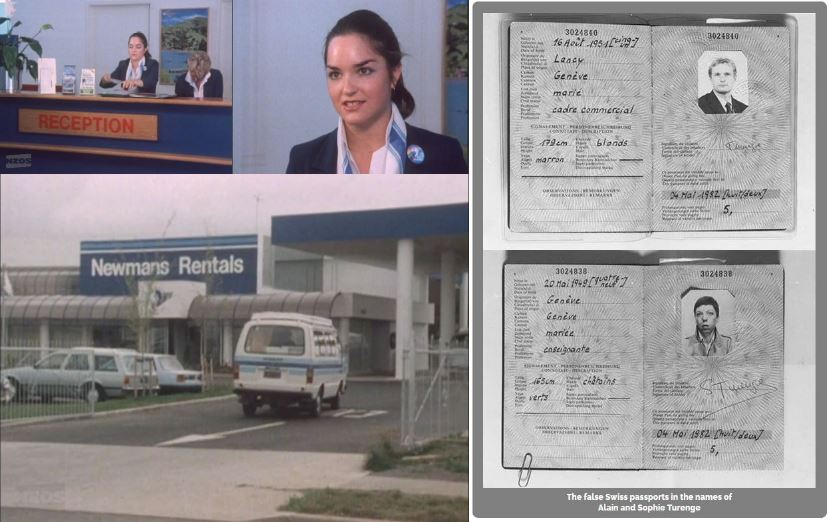
In other words, there’s something very fishy about the Hensley-chaired Officials Terrorism Committee.
What were they doing for 36 hours? Practising their best ‘play dumb’ whistling tunes?
After all, the bombing of the Wellington Trades Hall that occurred precisely 1 year, three months and 13 days prior to the Rainbow Warrior Bombing was not designated an act of terrorism.
Yet, if that bombing of March 27 1984 had occurred in the lobby of Parliament, the Beehive, or at the headquarters of the Police, the SIS, the GCSB or the Ministry of Defence — New Zealand’s white supremacist ruling class would have been hysterically screaming ‘terrorism’.
And if New Zealanders knew the nation actually had an Officials Terrorism Committee, any sharp nine year-old Scooby Doo Mysteries fan would have seen the double-standard.
Combat diver Jean Luc Kister seemed to have missed the weaponized irony in Opération Sataniqué that any sharp nine year-old Scooby Doo Mysteries fan would have picked up, if all the clues had been presented. For instance, the bomb switch decision that had Jean Luc Kister place the big bomb on the starboard hull outside the engine room, instead of on the propeller shaft at the keel.
Operation Satanique was all about reigning in grass-roots activists.
What better Morse Code metaphor than a spectacular gaping hole in the half-sunk ship’s star-board hull directly below the peace part of the organization name, Greenpeace, on its South Pacific seahorse, inflicted from a big bomb set by agents of one of the world’s great powers allied to New Zealand?
What better weaponized irony than a large scale operation involving dozens of French agents half a world away that would predictably result in the organization’s executive council scuttling their principles to save the South Pacific seahorse loved by grassroots anti-nuclear activists and send the Rainbow Warrior to a grassy sea-grave?
Subsequently, a $13 million deal was brokered by the United Nations, awarded to the Government of New Zealand the following year. This compensation amount, which embedded the recidivist prime number of Thirteen, demonstrated that the Brotherhoods of the United Nations endorsed state-sponsored terrorism to maintain the Western Empire.
The primary number, Thirteen, symbolizes ‘unity and fraternal love’, and has long been used for ‘procuring marriage agreements’ among brotherhoods across the world, as occultist Aleister Crowley stated in his book, Liber 777, and W. Wynn Westcott asserted in his work, Numbers: Their Occult Power and Mystic Virtues.
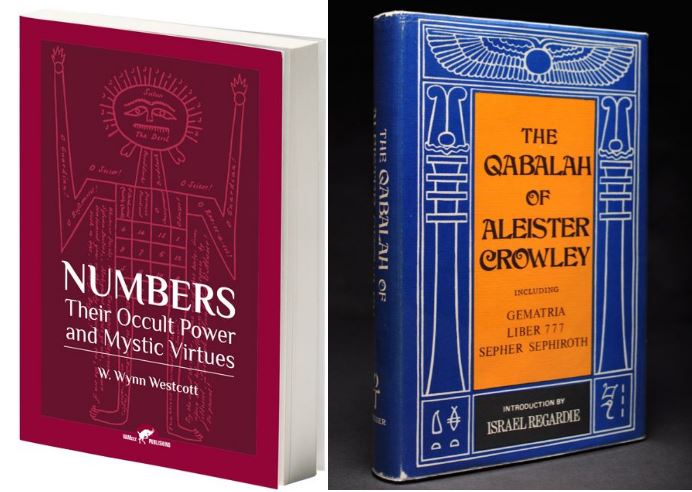
Because Thirteen is prime number used by Brotherhoods throughout the world for signalling unity, love between brethren, and also caution during the inevitable scandals, it is particularly hilarious that the French agents were caught while waiting for a $130 camper-van refund at the Newmans Depot. Especially, since the number 13 has potency as an unlucky number in popular consciousness. Particularly, because 13 also references the historical date of Friday 13th October 1307 when King Philip IV of France ordered Templar Grand Master Jacques de Molay and scores of other French Templars to be simultaneously arrested. Philip IV owed the Templars a fortune, since the Masonic Brotherhood had financed his war with England.
Hilariously, this $130 refund produced chinks in the Grand Orient-Jesuit armour of the perfect crime. Hilarious — because a search of the camper-van had uncovered a file of receipts from restaurants and supermarkets, gas stations and motels and hotels. With these receipts, ‘Alain and Sophie Turenge’ were detained and then charged on July 15 1985 with murder, conspiracy and arson.
Yet, even with chinks in the Grand Orient-Jesuit armour exposed, the bomb plot mission of 10/7 in 1985 — said to involve 13 French Secret Service agents sent to New Zealand to sink the 130 foot-long Greenpeace flagship seahorse with a core crew of 13, and which was due to leave 13 days later for Moruroa Atoll on July 23 1985 — the planners ultimately got away with the perfect crime. Because, the French still achieved their over-arching objectives by bombing Greenpeace’s seahorse, despite its occult-laden scripting designed to leave an ‘orgie of evidence’.
The slytherine cover-up operation seemed to be codified with weaponized irony from the get-go. When it is learned that some of the French Templars evaded arrests of Friday the 13th of October in 1307 and escaped to Scotland where they teamed up with Robert the Bruce, while others formed the seven cantons of what became the Templar Federal Republic of Switzerland — these historical elements appear to have become referrents in the Rainbow Warrior drama.
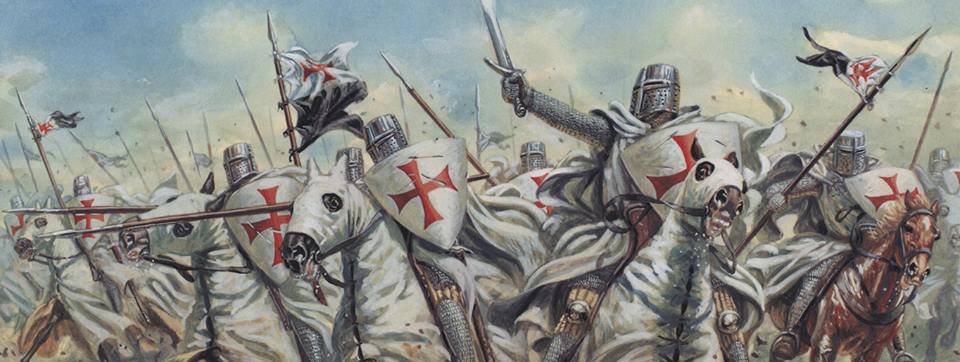
Because — the selection of Detective Superintendant Allan Galbraith made him, on paper, the perfect choice. Galbraith was earnest in his commendable leadership to crack the case. But, he was played by the echelon of New Zealand’s National Security State. The ‘good cop’ optics of the former Scots Guards – whose background included a training stint in London with Scotland Yard’s Bomb Squad – would work as propaganda. Not least, because his Scottish accent echoed the British crime television series, Scotland Yard, which aired on the BBC between 1953 and 1961.
After the trial, the weaponized irony of this multi-season psy-op news special was — in the grand tradition of serialized television series — evidently to be continued.
The French Government threatened the New Zealand Government to block lamb and butter trade in the lead up to the trial. Lange had initially point blank refused to deport Captain Prieur and Major Mafart when they were sentenced for 10 years imprisonment for manslaughter and seven years for wilful damage to the vessel on November 22nd 1985. The pair were not served a 17 year incarceration period, since the sentences were concurrent, not cumulative.
Thus, by classifying the seven year sentence as ‘concurrent’ for two bomb blasts to the vessel – the first of which occurred at 22 minutes to midnight on 10/7 of 1985 – the Crown Law Office seemed to have also deciphered the syntax of terror encoded into Opération Sataniqué.

➼ Codified Friendly Fire Between Allies
Without this distraction, the Western Empire Syndicate’s ‘free market economic therapy’ experiment would have flailed, faltered and failed. This economic aspect is important, since the DGSE’s economic intelligence unit is well respected.
Deciphering the ‘morse code’ in this terror event, a clear message was signalled to the political élites of the Western Alliance to get their anti-nuclear activists under control, or there would be stiff prices to pay if such threats to the political stability of the Western Empire Syndicate were not more tightly constrained.
Intriguingly, in an early 1985 press conference, one U.S. State Department Official emphasized there would be costs in the courses pursued by citizen movements deemed a threat to the Western Alliance. The U.S. Official said:
“Some Western countries have anti-nuclear and other movements that seek to diminish defense cooperation among the allied states. We would hope that our response to New Zealand would signal that the course these movements advocate would not be cost free.”

As mentioned above, four other Western Alliance countries — France, the Netherlands, Norway and Italy, as well as Japan and Singapore — faced similar dilemmas to New Zealand over the issue of visits by U.S. nuclear-powered and armed warships. Those countries did not want New Zealand thrown out of the Western Alliance. But, they worried that if there was not some sort of cost inflicted on New Zealand, anti-nuclear activists in other countries would be emboldened.
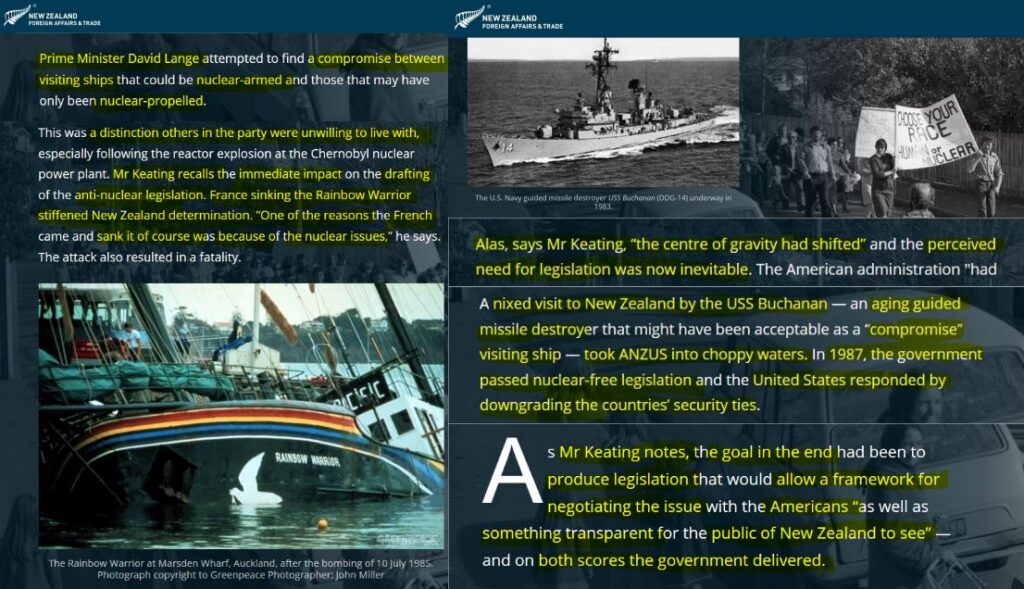
As the former head of the Prime Minister’s Department, Gerald Hensley stated in his book, Friendly Fire: Nuclear Politics and the Collapse of Anzus, 1984-1987 — if the USS Buchanan ship visit and the ANZUS Alliance had not become hot political issues, the political left of the Labour Party would have been entirely focused on the economic issues. Lange capitalized on the Rainbow Warrior Bombing to re-win power in 1987, while leaving the economic warfare experiment intact to inflict the discipline on the population, including grassroots movements.
That said, Deputy Prime Minister Sir Geoffrey Palmer was critical of Hensley pinning blame on Lange for the rift over ANZUS. Palmer said:
“The trouble with Gerald’s book is that it is a narrative of an extremely good diplomatic history put together from diplomatic sources, many many sources. The difficulty with it comes with an angle of narration. It is the angle of narration of someone who is opposed to the policy, that is to say who thought that we should have stayed in ANZUS and if we had to sacrifice the anti-nuclear policy we should have done so.”
However, Palmer was also the Attorney General and Minister of Justice at the time, which meant he was complicit in the damage control underway. On Palmer’s watch, New Zealand’s Solicitor-General, Paul Neazor, made the logically fallacious presentation to the Auckland High Court on November 4 1985 to justify dropping the charges of conspiracy and murder.
Lange’s former speech-writer and second wife, Margaret Pope, explained she did not participate in Hensley’s book and told the Otago Daily Times that her former husband never trusted Hensley because of his views over ANZUS. Pope said:
“I have absolutely no interest in helping Gerald reinvent history in which he and the Establishment play the heroes in their cause, ignoring what the electorate has actually voted for and doing what they saw was best for their country, and makes David out to be a villain or pantomime figure to explain away why they thought they knew better than the Government and the public.”
The Otago Daily Times made it seem that the rejection of USS Buchanan visit led to the collapse of ANZUS. However, Australian Prime Minister Paul Keating said that following the Rainbow Warrior attack “the centre of gravity had shifted” and the perceived need for anti-nuclear legislation became inevitable. This ‘centre of gravity’ terminology is the language of geopolitics, which is the struggle for space and power.
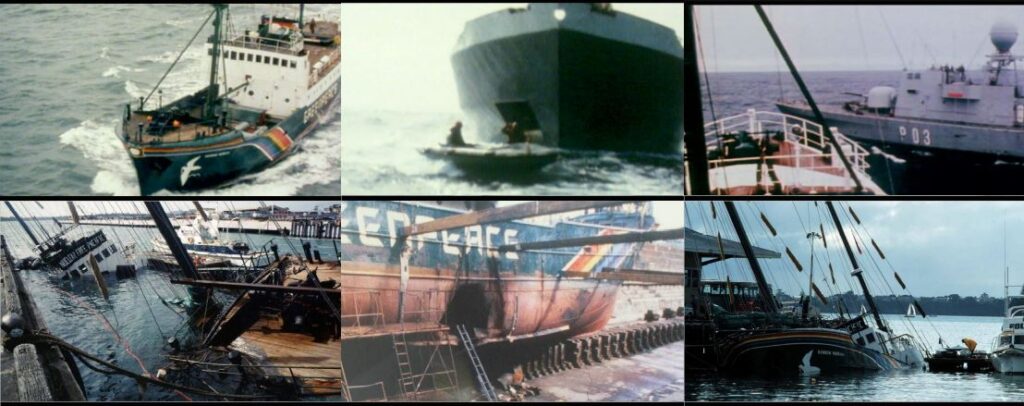
In a myth-making article published by N.Z.’s Ministry of Foreign Affairs and Trade, “Taking a nuclear-free policy to the world”, Keating made the observation that ‘the goal in the end had been to produce legislation that would allow a framework for negotiating the issue with the Americans “as well as something transparent for the public of New Zealand to see” — and on both scores the government delivered’.
However, the planning for a sabotage mission or terrorist operation against the Rainbow Warrior had begun in December 1984, which coincided roughly with Lange sending Air Marshal Jamieson to choose a ship from Pearl Harbor. The anti-nuclear faction, who were uncompromising, were only ever going to be emboldened by an act of terrorism inflicted by a Western Alliance nuclear power.
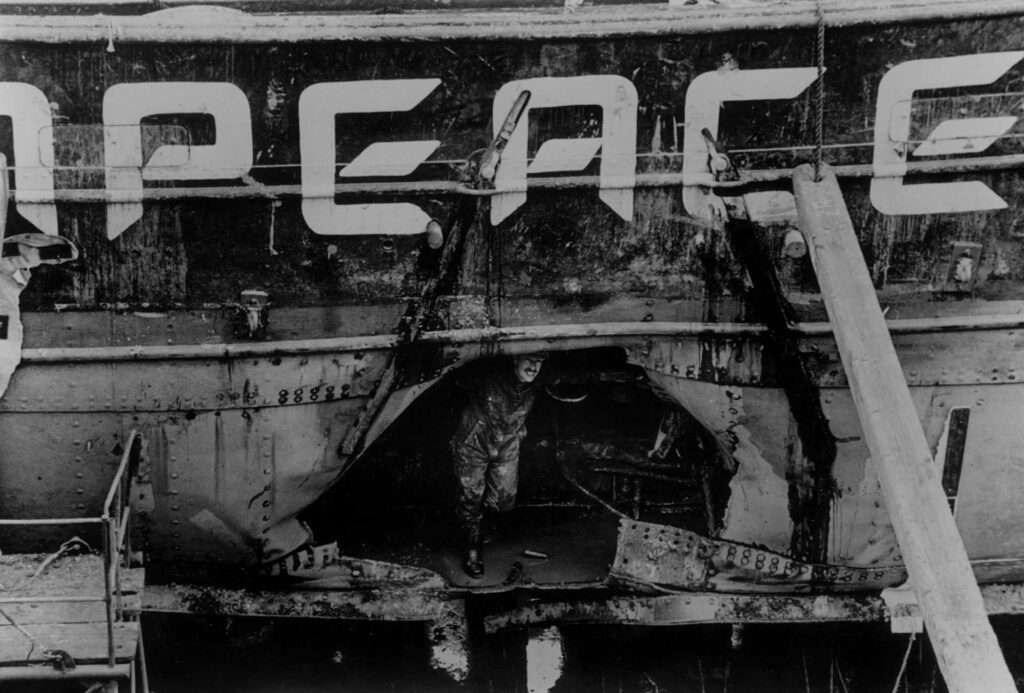
Eleven years after attack on Greenpeace’s flagship, the SIS claimed in its sanitized 1996 summary report, “Rainbow Warrior – An NZSIS Perspective”, that because the terrorist attack did not directly involve any New Zealand national interest — despite the bombing taking place in Auckland — this event made the French secret service operation qualify as “close to unique”.
However, the SIS did not appear to investigate whether the Prime Minister and others may have had something to gain from a French terrorist attack laden as it was with ‘an orgie of evidence’. The SIS also contrived an ignorance about the mutual advantages to the United States and France for the US-NATO Military Empire to maintain France as a nuclear power in Continental Europe. Moreover, the divisions within Lange Cabinet as a result of the political-financial coup that took place in mid-1984 — would also have been obvious to an intelligence agency based in Auckland and Wellington, one would have thought.
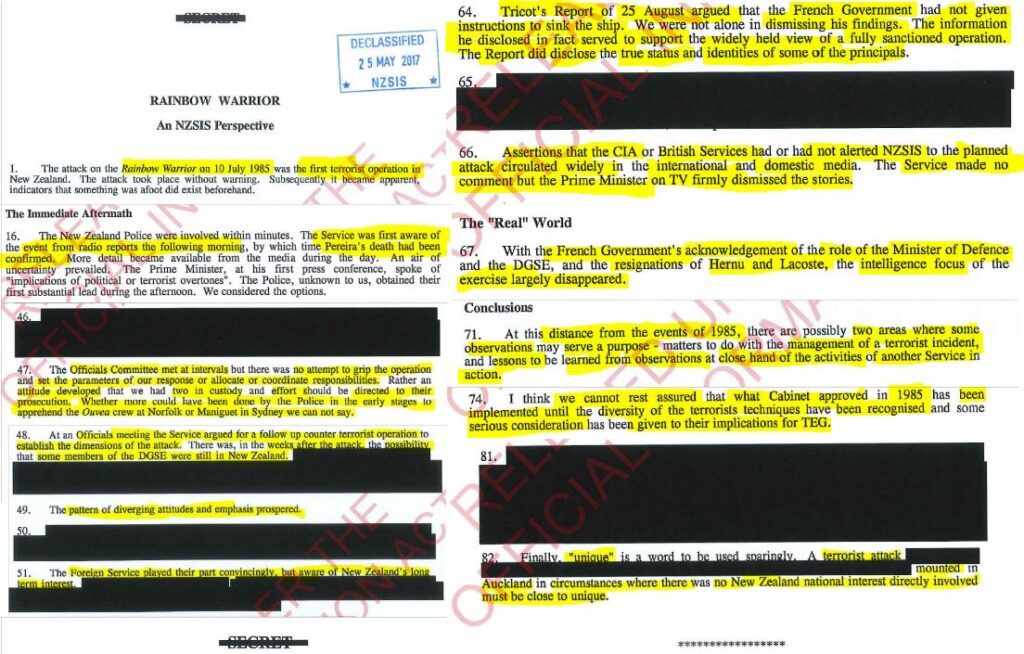
The SIS knew exactly why the Rainbow Warrior Bombing occurred, and why the terror event was never properly investigated by the Officials Committee for Domestic and External Security Co-ordination (ODESC). Any Security Intelligence Service could work out the contrived ignorance game in play. But, ‘The Service’ didn’t call out the game publicly, because a defection from such contrived ignorance games would likely result in an escalation of hostilities, or reprisals. The October 1996 SIS report brazenly claimed the Rainbow Warrior Bombing was the first terrorist operation in New Zealand, and that suddenly it became apparent there were warning signs that went undetected.
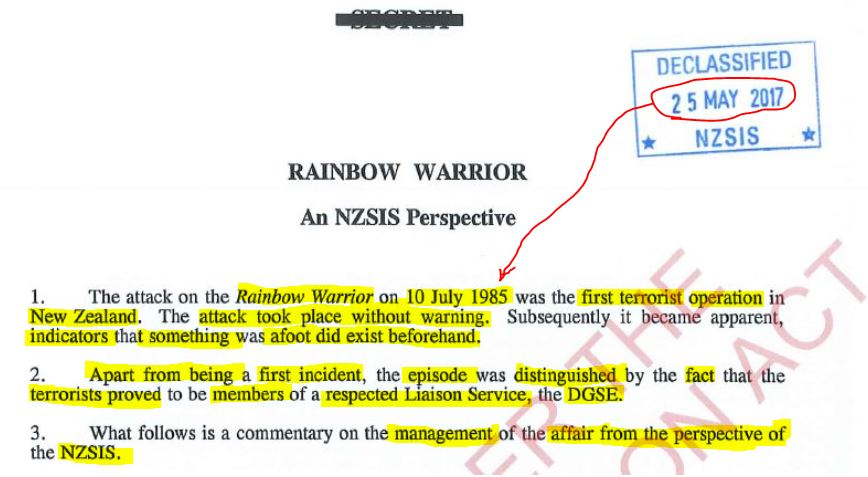
The SIS’s assertion that the Rainbow Warrior Bombing was the first terrorist operation in New Zealand, meant the Security Intelligence Service had a memory lapse. The SIS director at the time of the French attack on Greenpeace’s flagship should have recalled the Wellington Trades Hall Bombing of March 27 1984. Curiously, the Trades Hall Bombing — which only killed one person, building caretaker Ernie Abbott — occurred 1 year, 3 months and 13 days prior to the Rainbow Warrior Bombing.
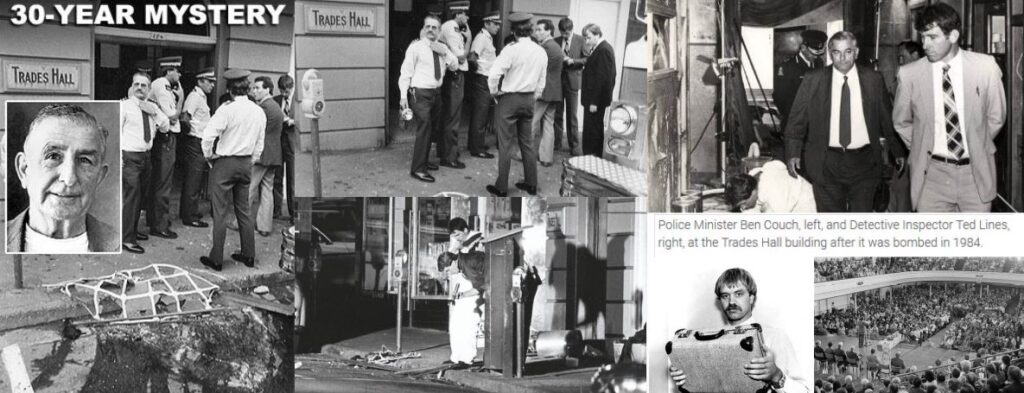
By timing the attack to occur on 10/7/1985, it would appear that the French were not only riffing off New Zealand Police Code, 10/7, for ‘unit arrived at job’ to signal that international terrorism had arrived in New Zealand.
The French DGSE also seemed to be signalling that they were aware that neither the New Zealand Police, nor the Aviation Security Service, had satisfactorily explained how it was that a terrorist bombing of the previous year had not been solved.
Moreover, the French DGSE seemed to be hinting with the timing of the Rainbow Warrior Bombing, that the unsolved case of a school-case bomb that ripped through the lobby of the Wellington Trades Hall of March 27th 1984, was a textbook ‘Operation Gladio’ case.
Perhaps the SIS forgot about this prior act of terrorism since it occurred in close proximity to the Old Knigges Ave Police Station. Otherwise, it would be more difficult to explain away the uncanny timing of the Rainbow Warrior Bombing occurring just prior to the formation of the new Terrorist Emergency Group. Indeed, the Trades Hall Bombing of March 27th 1984 may not have simply have been intended to assassinate the Labour Party officials and labour union officials, as then-secretary of the Federation of Labour, Ken Douglas, believed. He thinks the bomb was planted to coincide with a meeting between the political and industrial arms of the Labour Party after it was reported in The Dominion Post.
The newspaper did not say the meeting would take place at a separate site, in Luke’s Lane. However, this implies the perpetrators lacked quality intelligence. The case may have been that the bombing was inflicted as a threat to Labour Party insiders to get their camp on board with the coming financial-political coup that was due to occur in the immediate aftermath of the Lange Labour election win, which was brought forward as a snap election in July 1984.
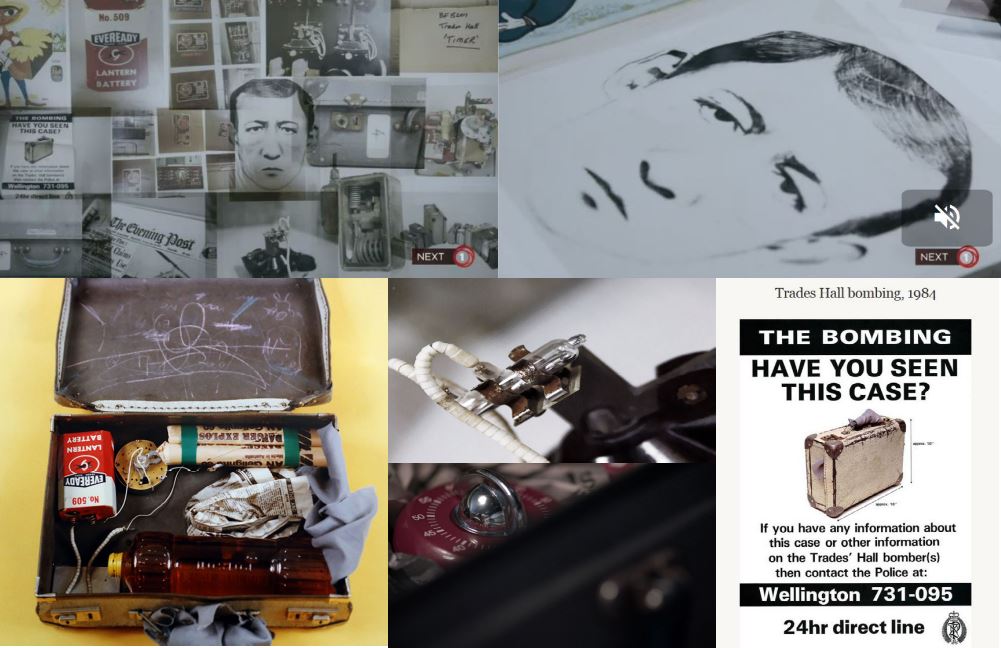
In June 1984, when the National government narrowly defeated a Nuclear Free New Zealand Bill that had been sponsored by Labour Party MP Richard Prebble, most New Zealanders did not realize that a political-financial coup was underway. This politically shrewd introduction of the Nuclear Free New Zealand Bill had caused Muldoon to gain votes from two renegade Labour MPs, because two National MPs, Marilyn Waring and Mike Minogue, voted with the Opposition.
In May 1984, the Labour Party Executive has released its international affairs policy platform stating its intention to legislate to make New Zealand nuclear-free and ban visits by nuclear-armed or powered vessels.
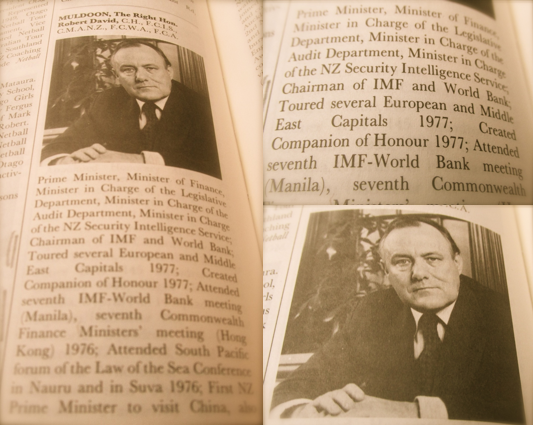
Meanwhile, the Labour Party had suppressed its economic policy proposals to transform the nation into a market economy. On the night of June 14th 1984, an embittered and spirits-fuelled Muldoon called a snap election.
The circumstances in which Lange and other Labour Party politicians just happened to be having dinner with the Governor-General, Sir David Beatty, and the Parliamentary Press Corp, at Government House, on that June 14th night, have never been fully disclosed by key players, including Gerald Hensley, in light of the broader state-craft occurring.
Muldoon sensed a theater of mutiny in his own party amid a fallout with one of his cronies, Bob Jones, who had bankrolled the New Zealand Party to draw votes away from National to assist the crony-capitalist’s plan to get Labour into power. When the cantankerous Prime Minister called on Government House to confer with the Governor-General over this governance crisis, he became sloshed over two large whiskeys while he was ‘put in his place’ by being made to wait. The Prime Minister’s slurred announcement later that evening that he was calling an election for July 14th added to the theater.
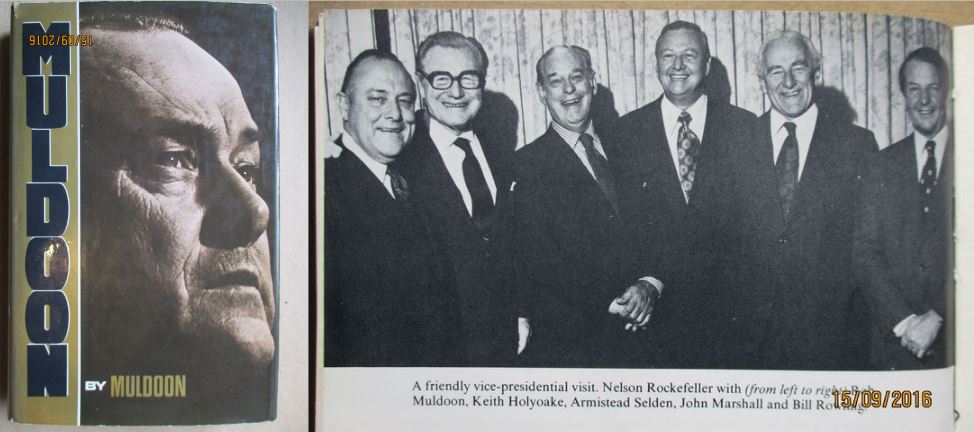
These election machinations are crucial, because the New Zealand public did not know at the time — and still do not know — how the takeover of New Zealand’s economy was part of a broader blueprint, called the ‘1980s Project’, that was driven by the Anglo-American Establishment (as the book Imperial Brain Trust revealed more generally).
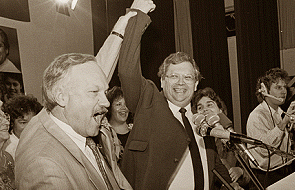
Lange’s Finance Minister Roger Douglas boasted at a private dinner in December 1986, that the idea behind the ‘free market’ reforms was to transform New Zealand into a Switzerland of the South Pacific. New Zealand would have a top strata of wealthy people and in 25 years time, most New Zealanders would not be able to afford to live in NZ., and that this agenda was driven from overseas, mostly from China, he added.
Crucial machinations, because — as Hensley noted — if the USS Buchanan ship visit and the ANZUS Alliance had not become hot political issues, the political left of the Labour Party would have been entirely focused on the economic issues, as I noted earlier.
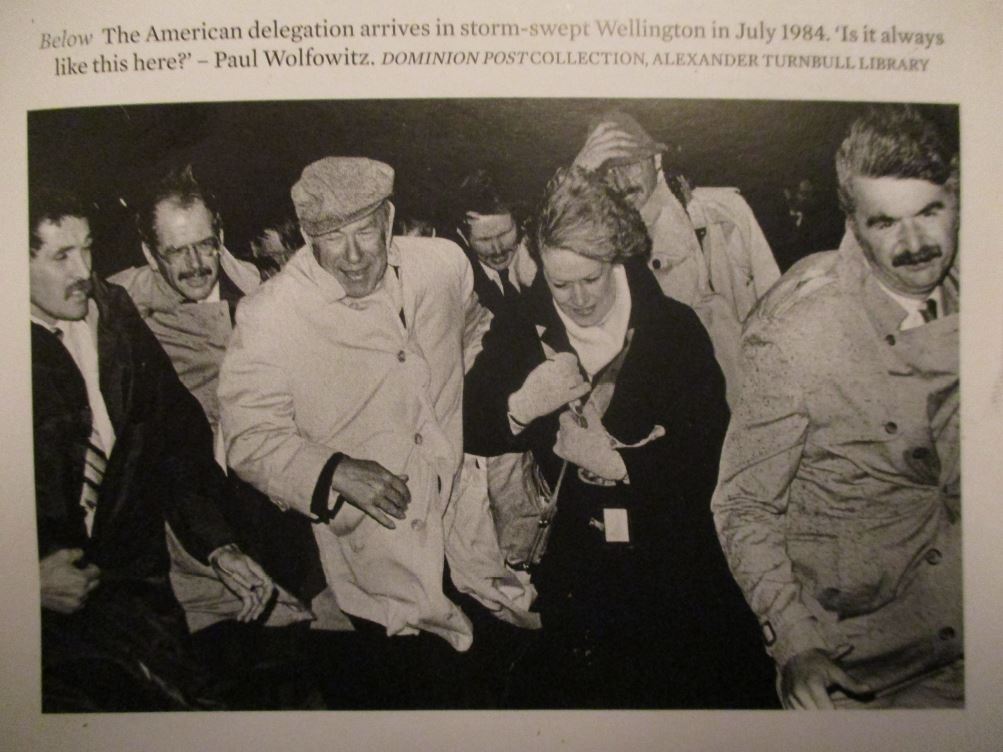
After winning power, Lange met with George Schultz, the U.S. Secretary of State, and the new Prime Minister told American State Department delegation that he needed six months breathing space to sort out the issue of American ship visits. It is fascinating to note that Paul Wolfowitz was part of the delegation, particularly since he had told Westpoint graduates three months before 9/11 to “[b]e prepared to be surprised” while lacing his speech with lessons from Peal Harbor. Wolfowitz had stated the Pearl Harbor commanders, Navy Rear Admiral Husband E. Kimmel and Army Commander Lieutenant General Walter Short, did not make ‘the need to know list’ — which is true.
After all — Wolfowitz mentioned that ultra secret Operation Magick intercepts that had unlocked the most private Japanese communications, but that these were not shared with field commanders. The Deputy Secretary of Defense maintained the cover-story that the intelligence of the Magick cipher intercepts were not shared because the thinking had been to not compromise the cutting edge breakthrough. Wolfowitz masked his Pearl Harbor narrative with a ‘poverty of expectations’ cover-story to claim that no-one imagined that the USA could be attacked, meaning this was how to sell a cover-story to the public.

Therefore, Wolfowitz forewent divulging the exclusionary blackballing stratagem from Washington had been to let the ‘surprise attack’ at Pearl Harbor happen to manipulate public sentiment to join World War II, from which the American Oligarchy planned emerge as the dominant world power. He finished his surprise themed speech saying, “Be prepared to be surprised.” Wolfowitz then recalled General Eisenhower’s speech to troops before the Normandy Invasion, “You are about to embark on a great crusade,” and then Wolfowitz added, “Today, as you, the Class of 2001, go forth on your own crusade, our hopes and prayers go with you. Thank you, God bless the Class of ’01, and God bless America.” [Applause.]
This Crusades riff is intriguing because in the aftermath of the 9/11 terror attacks, The Guardian newspaper reported in “Iraq ‘behind anthrax outbreaks’ ” that Bush Administration officials close to a group called the Defense Policy Advisory Board, dubbed the ‘Wolfowitz cabal’, had the ear of U.S. President George Walker Bush (whose father had been CIA Director from 1976 to 1977).
Intriguingly, this ‘Wolfowitz cabal’ likened the post-9/11 cause to a war against the ‘virus of terrorism’, which evidently was like bone marrow cancer that had to be treated with Western Allopathic Medicine’s mainstay cancer treatment, chemotherapy, a ‘therapy’ that kills not simply the cancerous cells, but healthy body cells, indiscriminately. But, because the enemy had been officially cast as amorphous Muslim fundamentalist non-state actors working with the support of ‘rogue failed states’ such as Iraq and Afghanistan, the treatment evidently required a new “Hundred Years’ War” – as The Guardian reported the Defense Policy Advisory Board’s group-think mindset.
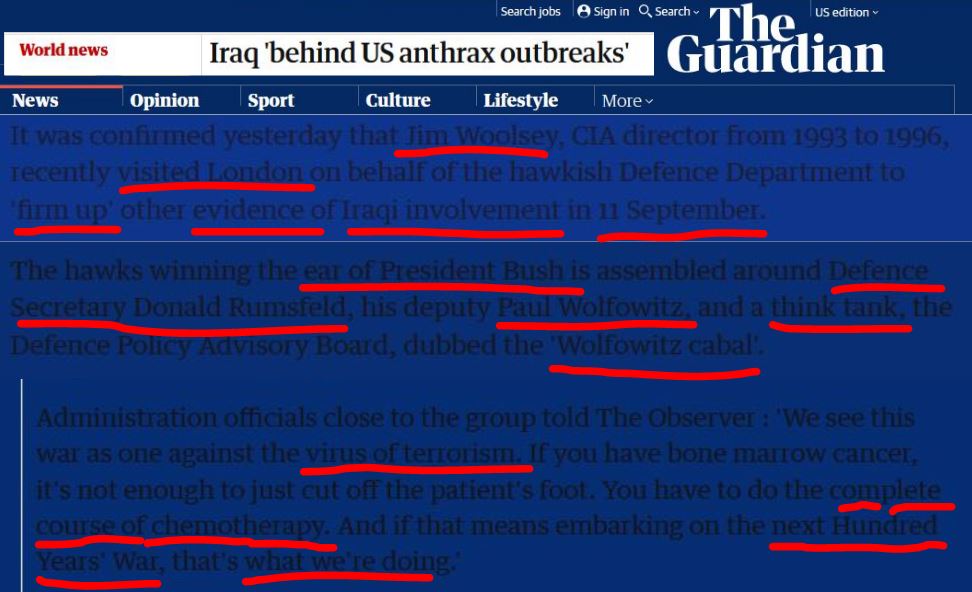
In other words, Wolfowitz was brazenly communicating how a two track blackballing communication strategy could be deployed to project blame on a new common enemy, while being entirely aware of the plot and ready to to pounce on the patsy’s once the terrorism as theater goes live.
There may be a connection between the Wellington Trades Hall Bombing and the Rainbow Warrior Bombing. Douglas stated the Federation of Labour’s investigation into the Trades Hall Bombing of 27/3/1984 found an intelligence officer who had been working in one of Irish Republican Army (IRA) 13 units, the IR5, was in the country for a short time, and skipped to Perth, but the Police never followed up this lead. N.Z.’s deep state may have also inflicted the Trade Hall Bombing to signal it was on board to expand it support for the Western Empire’s machinations, including a brazen international terrorist operation.
Especially, since the Federation of Labour President said their own investigation found an IRA bomb expert was in the country at the time, skipped to western Australia, but the Police never followed up this lead.The Old Knigges Ave Police Station was located down the street from the Trades Hall.
Intriguingly, the Rainbow Warrior Bombing occurred 1 year 3 months 13 days after the Trades Hall Bombing (March 27 1984), which renders the appearance of two 13’s in the numbers. This seems to have signaled New Zealand’s Old Boys Network’s solidarity, fraternal love and caution in advancing an imperial game with their Western Alliance counterparts in accordance with game theory’s hostage posting rituals.
Amid the de-stablizing effects of the anti-nuclear movement, it would appear the French timed their attack to signal a threat to NZ’s national security state., while simultaneously inflicting a deus ex machina event to magically resolve the deadlock over the threesome ‘marriage arrangement’: the ANZUS military alliance.

➼ The French Connection
If the Operation Satanique had occurred in late July, the intelligence support staff from Police Headquarters would have moved into the Government Beehive. And there would have been no Greenpeace flag ship to bomb because the re-fitted fishing trawler was due to leave 13 days later, for Moruroa Atoll on July 23 1985, in time to protest a French nuclear bomb test.
The heavily redacted 1996 SIS report, “Rainbow Warrior — An NZSIS Perspective”, concluded there was no national interest directly involved, making the attack close to unique.
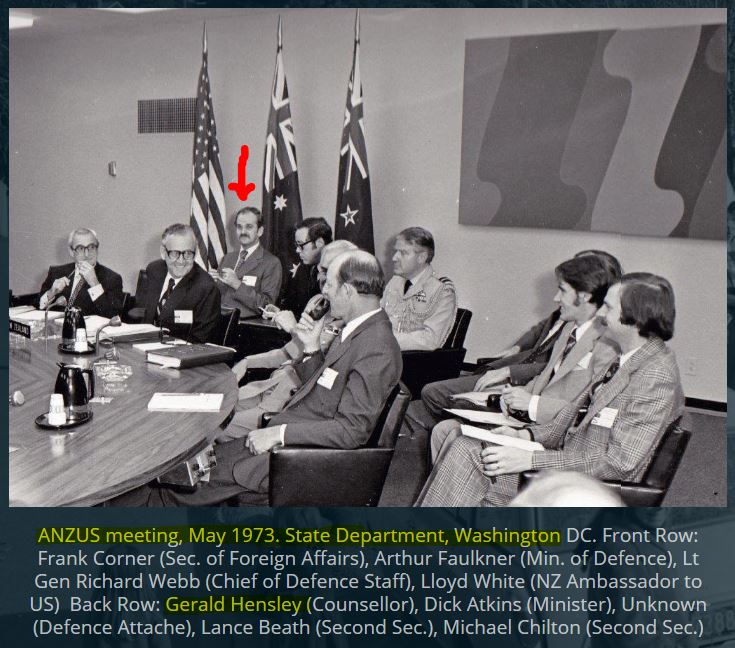
Thus, the heavily redacted 1996 SIS report is a sanitized version of a sanitized version of the Rainbow Warrior Bombing/Nuclear Bomb-Testing/Nuclear Vessels/ANZUS controversy, as is Gerald Hensley’s book, Friendly Fire: Nuclear Politics and the Collapse of Anzus, 1984-1987. In other words, these accounts are works of fraud.
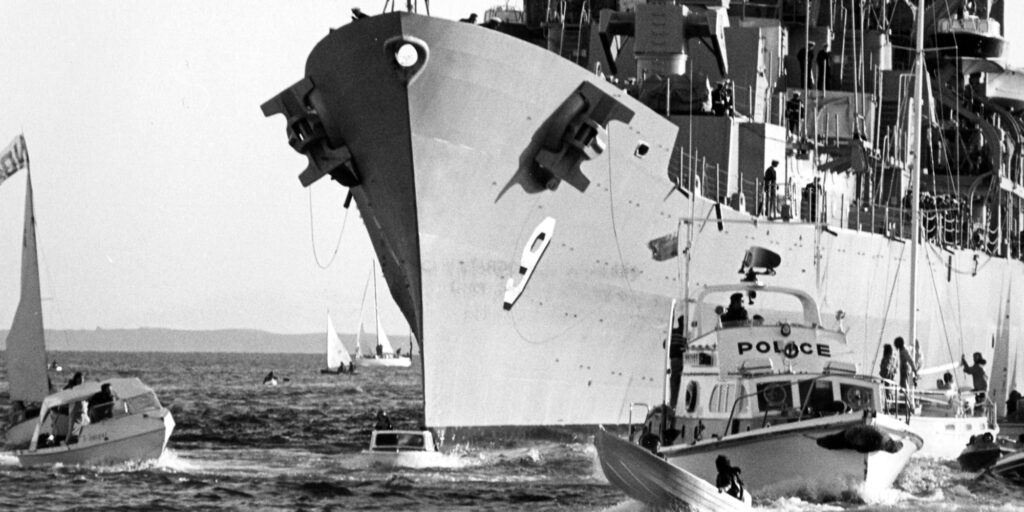
The U.S. ‘request’ to send a ‘rust-bucket’ guided missile destroyer to N.Z. and the denial of permission was a signal, rather like Morse Code, that a game of ‘friendly fire’ was being simultaneously advanced by deep state players within the United States, France and New Zealand. Embedded within these machinations was a sub-terrain test to bond the two outwardly socialist governments of France and New Zealand.
The terrorist act of French secret service frogmen setting limpid mines on Greenpeace’s flagship within New Zealand waters, would reinforce needed political support for the Labour Party, while doing only surface damage to the socialist French Government, even as it proved itself trustworthy player to the U.S.-NATO Military Empire.
The ‘horoscope’ logic is that Opération Sataniqué was more than merely a sabotage mission.
The logic underpinning a mission to send an attack team of French secret agent frogmen who had rendezvoused at a motel owned by the Prime Minister, and had delivered their payload in a Zodiac dinghy bought in London by a French agent who could not speak any English, thereby attracting the attention of MI6, who neglected to alert N.Z.’s SIS when the French DGSE told them they were planning a sting on a gun-running operating between New Zealand and New Caledonia — reveals a codified black operation.
By timing the attack to occur on 10/7/1985, the French were not only riffing off New Zealand Police Code, 10/7, for ‘unit arrived at job’ to signal that international terrorism had arrived in New Zealand. But, also that the French State, and key Western Alliance intelligence agencies, were aware the Police, SIS and SAS had participated in the cover-up of the Trades Hall Bombing, by timing the sinking of Greenpeace’s flagship to occur 1 year, 3 months and 13 days after the murder of Trades Hall caretaker, Ernie Abbott.
After all, the Trades Hall crime should have been easily solve-able with the identikit picture, cooperation with Interpol, British Police and the U.K. news media, since the likely prime suspect was an ex-IRA bomb expert/intelligence operative hired as a ‘cut-out’ to construct plausible deniability. Ken Douglas said the Police begrudgingly admitted later that they knew about the ex-IRA bomb expert/intelligence operative who has skipped the country on a flight to Perth.
The Police Anti-Terrorist Squad received training from the SAS, while the SIS shared intelligence with Police. Between them, they appear to have played a contrived ignorance game to let the case of a murder committed via a bomb mechanism delivered in a school case ‘go cold’ to signal text-book Gray Zone terrorism, or Fifth Generation Warfare. The reconstruction of the school case, the bomb and the apparent scapegoating of Dutch-born Peter Dijkstra seemed to have been subterfuge.
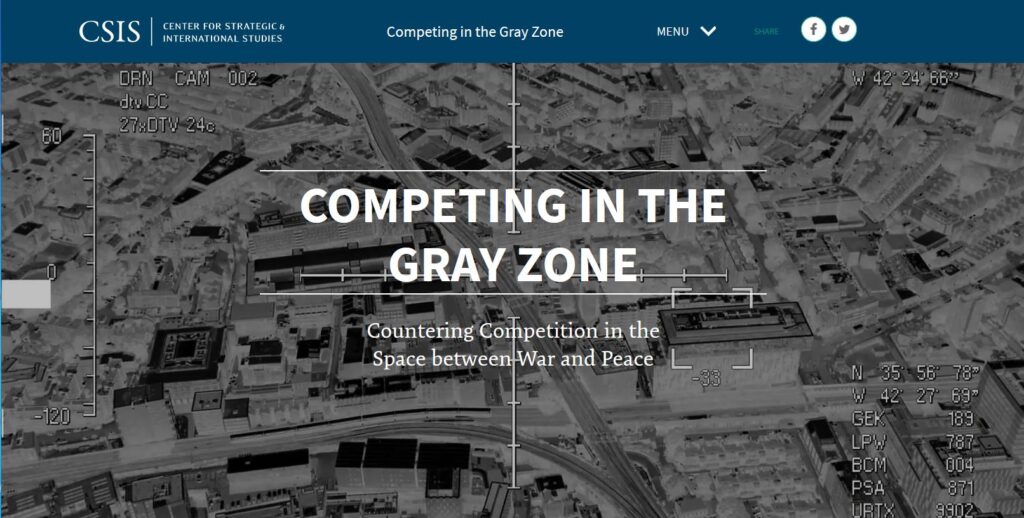
The choice of name for the mission, Opération Sataniqué, appeared to be unbridled French sarcastic wit that communicated the core of New Zealand’s National Security State had been turned to the dark-side and became allied with the evil forces of the universe.
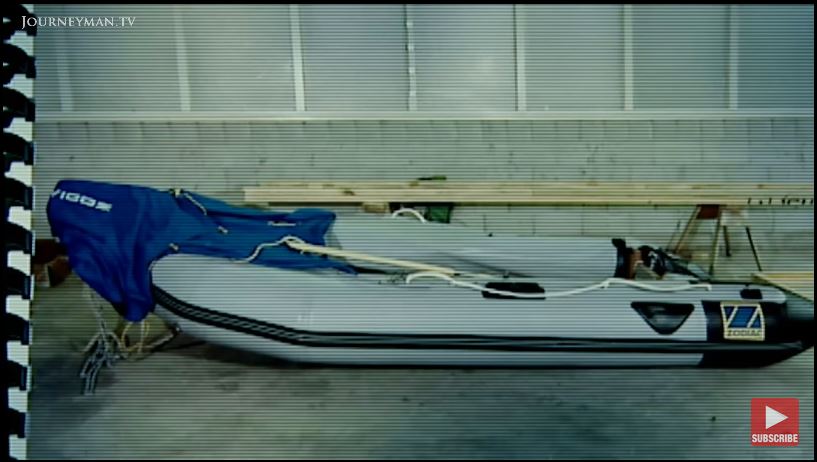
The sanitized 1996 SIS report did not mention that Lange part-owned Hinemoa Motel. This omission meant the SIS let itself off the hook to investigate the obvious encoded threat to the Government and the National Security State, since the DGSE agents demonstrated symbolically that the French Secret Service found the Prime Minister to be accommodating. The SIS position lacks credibility, because it appears to have failed to model for whether this event was a Hostage Posting Ritual, as game theory could predict.
Game theory strategies such as ‘Hostage Exchanges’ are used by nation states, international syndicates and monopolistic cartels to stabilize power structures while aggressive rivals seek to construct new areas of market dominance by illegal, fraudulent and repugnant means that harm their more dynamic, innovative smaller and peaceful competitors. The game requires an implied threat, which amounts to defection on the next move if the other player does not post a hostage. Since game theory requires colluding players to issue and respond to threats and rewards to maintain the motivation, discipline and purposes of the cartel (or cartels), their simultaneous actions are political and also betray economic evidence of an unfolding plot.
The French agents were, in effect, posting themselves as hostages by being seen to advance their part in a complex geopolitical chess-game, while also implying a threat. If Lange did not play along with the elaborate ruse by advancing the game of the political theater, there would be serious punishments for defections on the next moves.
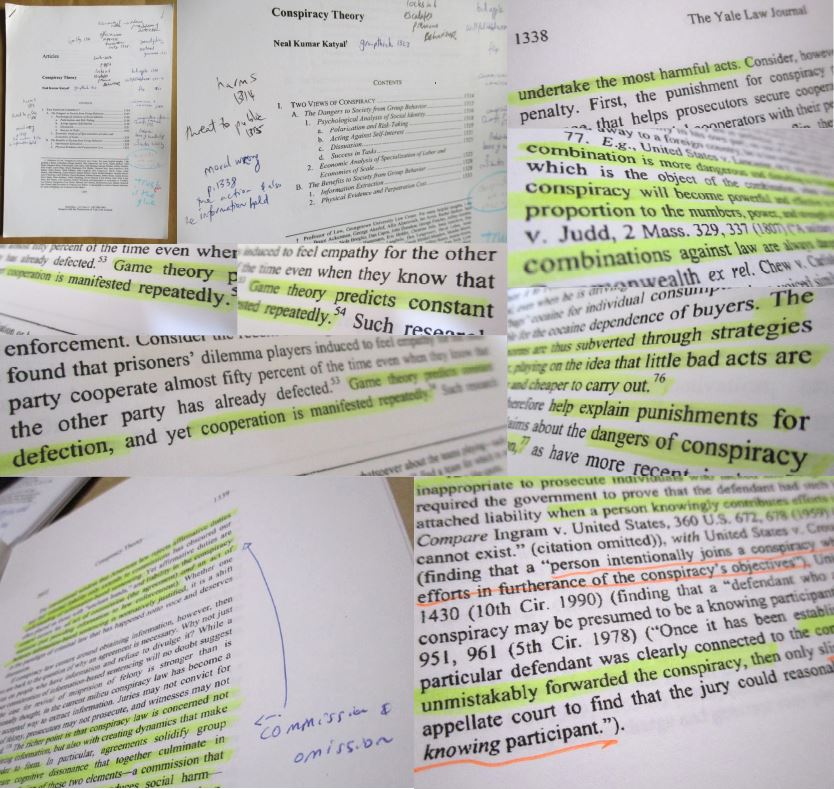
New Zealand’s SIS also contrived ignorance regarding the costs theme embedded in the events. The Ouvéa crew had placed their mission in jeopardy by asking for receipts for trivial amounts, and also the ‘Turenges’ had waited for the $130 refund at the Newman’s Depot, which together served as an object lesson in why it was advisable that agents “spends as if they are using their own money”, the report said.

Incredibly, much of meta-data in the Rainbow Bombing also reveals symbolism inherent to the cost of human life, the price of political power and threats to New Zealand over loss of trade in lambs’ brains, butter and goat-meat. This act of terrorism worked to signify that the culture Western Civilization was being re-coded with new language, images, and metaphor.
The cost components turned out to be a deeply symbolic element in the Rainbow Warrior ‘affair’, where deep politics operated in a parallel universe and in accordance with game theory.
Since Mafart and Prieur did not intend to get caught, the SIS executives who wrote the report were wryly communicating that this application of game theory to encode events with the ‘price of power’ theme was the undoing of the DGSE agents. The deliberately created paper trail to advance a game of political terror theater was based on the assumption that all of the agents would get out of the country before anyone could work out their identities.
Below the surface, the subtext of political theater with a terror event climax themed with costs, signalled that principles were window dressing. Game theory would be used to stabilize world politics as states transformed to a Neo-Feudal system, where the price of power would be determined by how willing political players were to brainwash their citizenries, expend lives and revalue life with the terms of commercial trade deals.
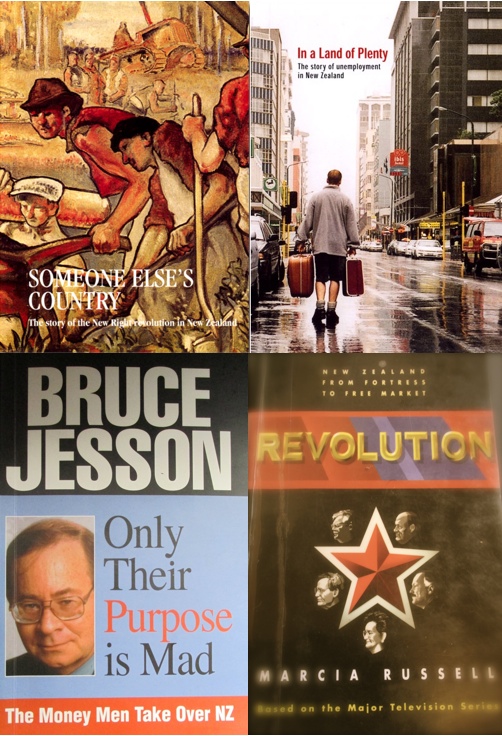
The Neo-Feudal corporate takeover of New Zealand that was inflicted from mid-1984 was part of a broader reset called the ‘1980’s Project’. This ‘1980’s Project’ was a blueprint to transform the world with Neo-Feudal ‘market economies’ and was designed at the New York-based think tank, the Council on Foreign Relations, that was chaired by Chase Manhattan bank chairman, David Rockefeller, from 1970 to 1985.
As the Snoopman showed in “Neo-Colonial New Zealand: The stealthy forging of a ‘Switzerland of the South Pacific’ Utopia”, the deployment of the Shock Doctrine economic warfare framework in New Zealand was driven from overseas, through a network of think-tanks the New Zealand Business Round-Table, the Tasman Institute and the Centre for Independent Studies that were front-groups for the Council on Foreign Relations, the Trilateral Commission, the Mont Pèlerin Society, and the Bilderberg Group.
The stealthy deployment of ‘free market economic shock treatments’ in New Zealand started under former Prime Minister Robert Muldoon (1975-1984) with large industrial development ‘loans’, liberalizing regulatory controls over the share market, and legislating voluntary union membership.This reset of New Zealand and the world onto a Neo-Feudal trajectory followed a period of destabilization through the infliction of economic, financial and psychological warfare amid the 1973-74 Oil Price Shocks plotted by a Rockefeller-Kissinger-Bilderberger Nexus who triggered the October 1973 Yom Kippur War.
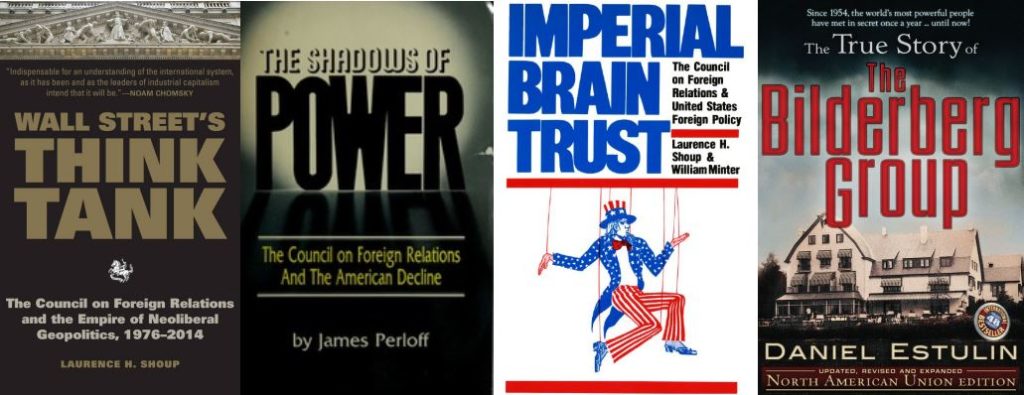
In other words, New Zealand had been been stealthily cast an experimental test lab for the rapid transformation from a protectionist state where even the sheep were on welfare, to a market economy. The Western Empire Syndicate needed to de-risk losing control of New Zealand, lest grass-roots movements in other countries drew vital lessons. Moreover, if the opposition National Party had been returned to power in 1987, their rural and provincial support would likely have force a reverse or severe curtailment of the economic warfare policies.

Even thirty years after this deep event, the French newspaper missed the significance of a French intelligence chief named Lacoste being fired for a budget terrorist mission gone awry, when it that had been authorized by a socialist president of the Fifth Republic. And, the theatrics of Mr. Armacost, the U.S. Under Secretary of State for Political Affairs, who complained to Lange’s head of department that it was U.S. wasn’t the one who was filing for divorce was also missed for its significance.
While it is well-known that the Rainbow Warrior Bombing cemented public opposition to nuclear-powered and armed warships, the meta-data of the ANZUS Alliance stousch and the French attack on the Greenpeace flagship show a coordinated scripted drama that combined politics and terrorism as nuclear-themed political theater. Lange’s Oxford Union speech of March 1st 1985 became a defining moment of his premiere-ship, and his ‘uranium breath’ quip to Reagan’s friend, Jerry Falwell, became ‘video tape evidence’ in the construction of the national myth that Lange was a champion for the nuclear-free cause.
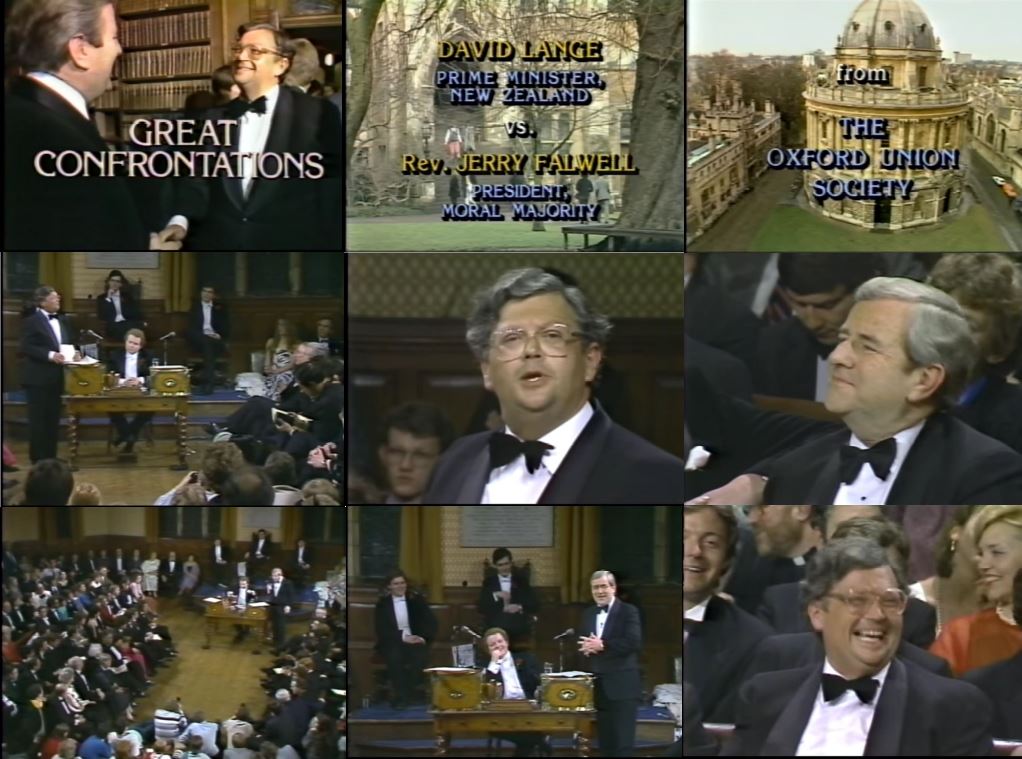
More crucially, his Oxford Union appearance gave Lange the ‘street-credibility’ in the aftermath of the Rainbow Warrior Bombing to chastise France, even while he was running secret talks to negotiate a deal with the French before to trial of Major Mafart and Captain Prieur was over. Lange’s political theater performances over the Rainbow Warrior Affair was the deciding issue over which he re-won power in the June 1987 election.

With this appearance of toughness, Lange manipulated the public, who were angry that the French Government had plotted an act of terrorism in New Zealand. By the time of 1987 election, this political resolution to the Rainbow Warrior Bombing was out of the headlines. As Lange Cabinet minister Richard Prebble said to The New Zealand Herald in 2005 on the 20th anniversary of the Rainbow Warrior Bombing, “There was a sense of patriotism and a government always wins out of that. Lange, who had a great sense of polls, rode it for all he was worth.”
In April 1985, N.Z. Prime Minister David Lange again met British Prime Minister Margaret Thatcher. (Lange had met Thatcher the morning prior to his debate with Mr Falwell). Evidently, the Iron Lady from Number 10 (Downing Street) was not happy about his Oxford Union Debate.
Therefore, in this case of the half-sunk seahorse, the clustered events prior to 10/7 in 1985 appears to have been designed as a ‘repeated message’. Lange’s meeting with ‘Iron Lady’ from Number 10 in the fourth month of the same year, seems to denote the New Zealand Police call sign ‘10/4’, which stands for ‘Repeat your last message’. Thatcher had met with Lange the morning prior to the infamous Oxford Union Debate.
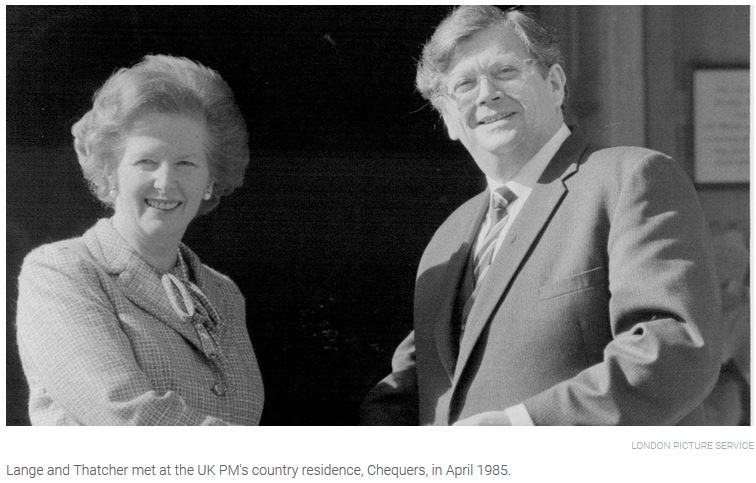
In 2015, Margaret Pope told the New Zealand Herald that Lange was shocked that the French state had perpetrated the attack. She said that none of the Allies of the Western Alliance seemed willing to criticize the French attack. Pope explained the French were threatening to block New Zealand trade in the European Economic Community (EEC). “When the French threatened to put a stop to that trade and the British seemed unwilling to do anything about it, it was either sell the farmers down the river or give in,” Pope said.
In his 1990 memoir, Nuclear Free — The New Zealand Way, Lange wrote, “I had to accept that it was the intention of France to deal a body blow to our farming industry. We were a victim of extortion and there was nothing I could do about it.”
But, Lange and his administration had already attacked the farming sector with sudden removal of financial controls, tarriffs and subsidies as part of a broader, unmandated economic warfare framework. Moreover, the Lange Administrations’ back-channel diplomacy with the French Government, investigation-lite conducted by Officials Committee for Domestic and External Security Co-ordination (ODESC), and the legal move to drop the charges of murder and conspiracy was part of a systematic capitulation.
The evidence shows the Lange Government had capitulated before the French trade pressure was applied after the Marfart and Prieur were sentenced to 10 years in December 1985. In doing so, Lange and his administration enjoined themselves in furtherance of the conspiracy. Instead of capitulating to a United Nations’ brokered ‘blood money’ package, Lange could have delivered a principled speech at the United Nations in Gotham, like he had months earlier at Oxford University on the nuclear terrorism issue.
Because — Lange had to have deciphered the metaphor embedded into French secret service agents staying at Hinemoa Motel not once, but three times. The Western Alliance were accommodating of his delicate hold on power, since he had quipped that he faced re-election at every cabinet meeting. And, the French scripting of Opération Sataniqué to use the holiday accommodation co-owned by N.Z’s PM as a rendezvous point to transfer the dive team equipment and bombs, communicated a potent threat, not just to Lange, but to all Western Alliance élites.
Instead, Major Mafart was repatriated to France in December 1987 – after the Lange Government was re-elected, and awarded France’s National Order of Merit. A pregnant Captain Prieur was returned to France in May 1988, after she took the hint that her return would have to be justified as a ‘happy occasion’. Prebble, who had introduced nuclear-free legislation into parliament the year prior to Greenpeace’s seahorse sinking into the harbour, said,
“It was obvious the agents could not serve that long. The truth of the matter was that both governments were keen to move on and the U.N. settlement’s purpose was to placate public opinion.”
— Richard Prebble, “Reality behind the Rainbow Warrior outrage”, New Zealand Herald, 1 July 2005
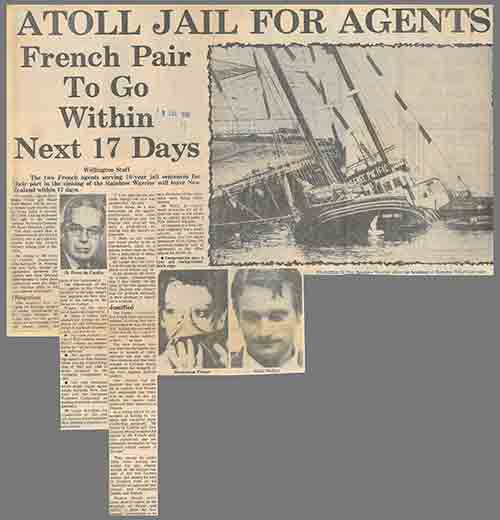
In effect, the $13 million monetary compensation for the Rainbow Warrior Bombing meant the world officially condoned terrorism and the United Nations, in effect, consummated a ‘marriage’ of its member states to inflict terrorism to affect ‘resets’, or submit to terrorism.
The statement by one political commentator at the time that the Rainbow Warrior Bombing — “at last proves that the socialists have got balls” in the 1986 book, Rainbow Warrior: The French Attempt to Sink Greenpeace — could not have been fully comprehended at the time without knowledge of NATO’s Operation Gladio.
Crucially, the U.S.-NATO Military Empire was forged with a closely guarded fascist ideology that carefully hid a neo-feudalist totalitarian core.
After World War II, the Atlantic Alliance covertly formed a secret ‘stay behind’ army by recruiting fascists, including former Nazis, to conduct terrorism operations now generally referred to the Italian pogrom, code-name ‘Gladio’, which was Latin for Roman sword. Operation Gladio was a hidden low-grade war that embroiled every NATO state who used either their intelligence services, military forces, or paramilitary squads to inflict terrorism against their own citizens to shift the political gravity to the ‘right’, and away from socialism by blaming left-wing communist groups for the carnage.
The bombings of trains, planes, automobiles, buses, and buildings conducted under Operation ‘Gladio’ were, in fact, ‘false flag’ operations. Key insiders who inflicted the carnage of Operation Gladio involved the CIA, MI6 and the Coordination and Planning Committee (CPC) of NATO’s Supreme Headquarters Allied Powers Europe (SHAPE).
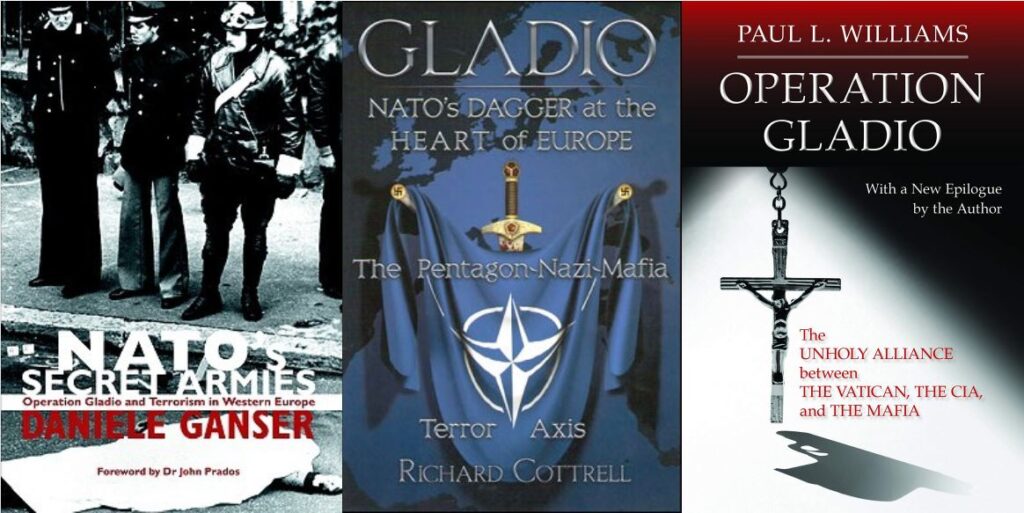
Pertinently, Swiss historian Dr. Daniele Ganser, author of the seminal book NATO’s Secret Armies: Operation GLADIO and Terrorism in Western Europe, framed the Rainbow Warrior Bombing as an example of a NATO power conducting terrorism to inflict damage against a defiant Greenpeace. Ganser mentions that once the Director of the DGSE, was fired over the Rainbow Warrior Bombing, an embittered Admiral Pierre Lacoste, stated that the during the time that NATO’s stay-behind network operated in the ’60s and ’70s, terrorist action against then French President de Gaulle and his Algerian Peace Plan had been carried out by groups that included, and I quote, “a limited number of people from the French stay-behind network”.
In other words, France’s deep state turned against their own President, a and it was due to a hostile faction’s attempts to assassinate President de Gaulle (1959-1969), that NATO’s headquarters shifted from Paris to Brussels in 1967.
This finding implies that all states in the Western Alliance maintained a contrived ignorance about how commonplace it was for the NATO powers to inflict terrorism on ‘social democracies’ run by super-rich oligarchies and their networked military and intelligence families in Western Europe. The NATO Alliance were smugly confident because they knew the public, as well as most socialist politicians, of Western Civilization did not know about Operation Gladio.
Therefore, an assertion made by the SIS that the Rainbow Warrior Bombing was the first terrorist operation in New Zealand, meant the Security Intelligence Service had a ‘memory lapse’.
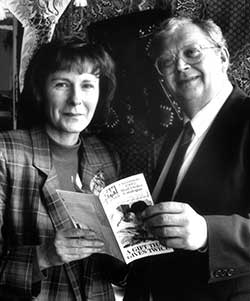
Puppet Prime Minister: Because the design of Opération Sataniqué involved French agents staying three-times at holiday accommodation part-owned by David Lange – including the event of ‘Alain and Sophie Turenge’ delivering the explosives, diving equipment and the Zodiac from the Ouvéa yacht to the French attack team – the French Government was communicating the Western Alliance would accommodate New Zealand’s political situation, while simultaneously conveying a threat to Western élites that nowhere was safe from deep-state sponsored terrorism. [David Lange with his second wife, Margaret Pope].
The Rainbow Warrior Bombing and the subsequent passage of the New Zealand Nuclear Free Zone, Disarmament, and Arms Control Act in June 1987 saved the Lange Labour Government amid a huge backlash over his government’s collusion with the Rockefeller-driven corporate takeover of the economy, following the financial-political coup during the 1984 General Election. In other words, the French state was threatening economic terrorism on top of the economic warfare inflicted by the coalition of New Zealand cartel capitalists in accordance with a broad blueprint, called the ‘1980s Project’, authored by the Rockefeller-chaired Council on Foreign Relations. Lange’s capitulations to terrorism — military-grade bombs and economic sabotage beans – begs the question: was the Labour Prime Minister compromised by bribes?
When so much meta-data boiled down to the symbolism inherent in the cost of human life, the price of political power and threats over loss of trade in lambs’ brains, butter, milk and goat-meat — this act of terrorism ironically worked to callously recapture the ‘Labour’ Governments support base.
Meanwhile, the far-right inside cabinet could continue to steer the takeover of the economy which included inflicting economic warfare against farmers as part of a broader plan to corporatize the ownership of rural land, with foreign investment. The Labour Party leadership’s betrayal of its worker support base — as well as Lange going along with the coercion to capitulate over the detention of Major Mafart and Captain Prieur — reveals an unprincipled stance to ‘give in’ to terrorists.
This episode in deep state-sponsored also reveals that the Western Empire’s rulers enjoyed mocking political puppets and citizens cast across the political spectrum. In his 1974 paper, “International Terrorism: A New Kind of Warfare”, Brian Jenkins of Rand Corporation used the phrase ‘terrorism as theater’, to explain that political violence was performed to instill fear in the watching audience, who were the real targets.
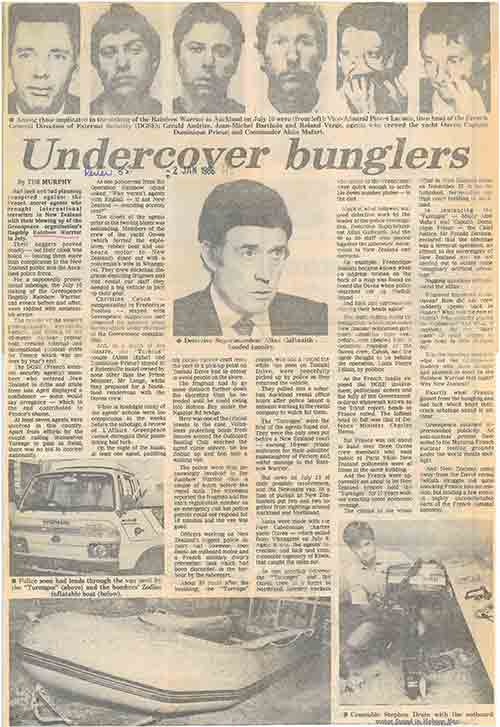
The design of Opération Sataniqué was embedded with occult communications that could be readily de-coded by any intelligence agency. The mission involved French agents staying three-times at holiday accommodation part-owned by David Lange to convey a pattern rather than a mistake. This included the event of ‘Alain and Sophie Turenge’ delivering the explosives, diving equipment and the Zodiac from the Ouvéa yacht to the French attack team.
The French Government was communicating the Western Alliance would accommodate New Zealand’s tricky political situation, particularly because the South Pacific archipelago was the Western Empire’s chosen First World English-speaking test-lab for experimenting with its rapid transformation into a market economy — without firing a shot — while simultaneously conveying a threat to Western élites that nowhere was safe from deep-state sponsored terrorism.
The attention-attracting purchase of a Zodiac in London by DGSE agent Petty Officer Gerald Andries, who couldn’t speak English, was a call-sign to their intelligence counterparts at MI5 and MI6 that some friendly fire between allied nations was being foreshadowed by French ‘horoscope readers’. After all, Andries had trained with British Special Ops divers.
The Newman’s rental van used by the fake-Swiss honey-mooners signalled to New Zealand’s political elite, national security state and ruling class to decode the deep event’s meaning. The Newman’s logo features Pegasus, a mythical winged divine horse from Greek mythology that is usually depicted in pure white, while celestial cartographers depict Pegasus as half of a horse, rising out of the ocean. The Greek God, Zeus, transformed Pegasus into the constellation visible in the northern sky with the brightest star being an orange super-giant, Epsilon Pegasi, also known as Enif, which marks the horse’s muzzle.

Because Major Alain Mafart had waited on a $130 refund for returning the rental van early, it is particularly hilarious that the French agents were caught while the Newman’s front-desk staff stalled for the Police to arrive before their departure from New Zealand. Since $130 is a multiple of Thirteen, its coincidental appearance in the event that led to the ‘Swiss honey-mooners’ being caught just as they were about to skip the country would had irked the French DGSE.
Because Thirteen is a prime number used by Brotherhoods throughout the world for signalling unity, love between brethren, and also caution during the inevitable scandals, it would appear this prime number was used by the French DGSE to signal their authorship to the Western Alliance’s security agencies.
Especially, since it also references the historical date of Friday 13th October 1307 when King Philip IV of France ordered Templar Grand Master Jacques de Molay and scores of other French Templars to be simultaneously arrested. Philip IV owed the Templars a fortune for financing his war with England.
Therefore, the choice of a Newman’s rental van, suggests the French DGSE agents were signalling a white horse with magical powers had paid a friendly visit to make the Greenpeace ocean-going horse became half submerged at Marsden Wharf. In effect, the Opération Sataniqué mission script-writers were saying the brightest ‘celestial astrologers’ or ‘horoscope readers’ in the land could decipher the symbolic meanings of the attack.
Because it had occurred right under the nose of New Zealand’s national security state and on the watch of the rotund Prime Minister, the French signalled by reference to the super-giant, Epsilon Pegasi, that silence about the operation’s true meaning was required by New Zealand’s ‘celestial astrologers’. The reference that the horse’s muzzle implied that the super-giant charismatic political star of the Southern Hemisphere, David Lange, required careful management from a discerning voice.
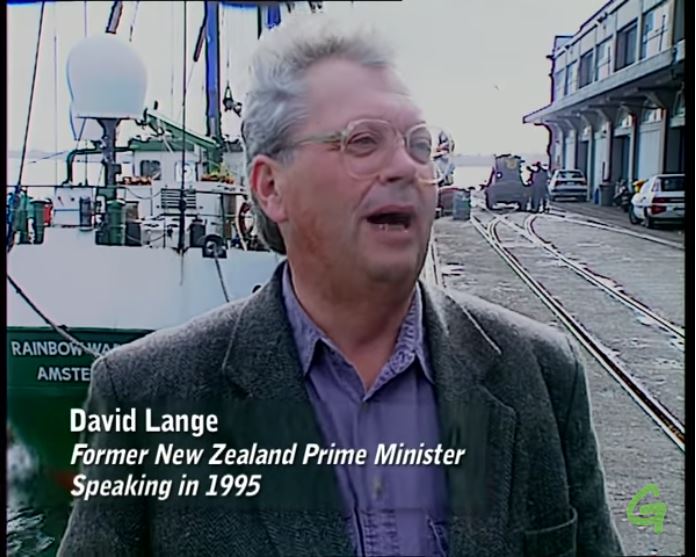
The publicity photo of the Newman’s van, taken with the door open to display the Pegasus logo suggests the Police top brass decoded the message that discernment was required to muzzle the political giant of the Southern Hemisphere. Because — if the super-giant charismatic political star became a loose cannon divulging to New Zealanders the sub-terrain meaning embedded in the event of Greenpeace’s seahorse becoming submerged at Marsden Wharf at 22 minutes to midnight on the evening of 10/7 1985 in a display of terror theater, all hell might have broken loose.

Especially, if the birthday party on board had not already left for the Piha base-camp of pop-band, Split Enz. Because, if any band members of Split Enz had come aboard the Rainbow Warrior as planned — and died — all hell would have broken loose. For the murder of Split Enz members at that time would have, perhaps, been more sacrilegious than murdering members of the All Blacks, the national rugby team, in a far-flung land susceptible to emotional hijacking.
Potently, death by drowning amid the terror of a bomb blasts is the sinister means by which the Greenpeace crew members, volunteers and visitors could have died if the birthday party aboard the Rainbow Warrior had still been in progress.
The metadata suggests that Colonel Jean-Claude Lesquer’s Opération Sataniqué was designed with weaponized metaphors, historical referents and narrative elements that riffed off Greek mythology, Roman theatre German folklore, and 20th century propaganda and popular culture. Indeed, Colonel Lesquer’s Opération Sataniqué time bomb plot appears to have been designed to blow up in faces of Mitterand’s officials as an object lesson in how to engineer a state-sponsored terrorism event to show an Ally how to distract the public, ride out the scandal, and accumulate wealth, power and control.
The sinister hidden objectives signalled by the strange mission code-name either flew over the head of Alain Chouet, who at the time was head of the DGSE’s counter-terrorism intelligence and operations co-ordination unit. In 2005, Chouet scorned Maffart’s account
“The operation was put together by amateurs, who trailed clues behind them like Hansel (in Hansel and Gretel fairy stories) dropped stones behind him.”
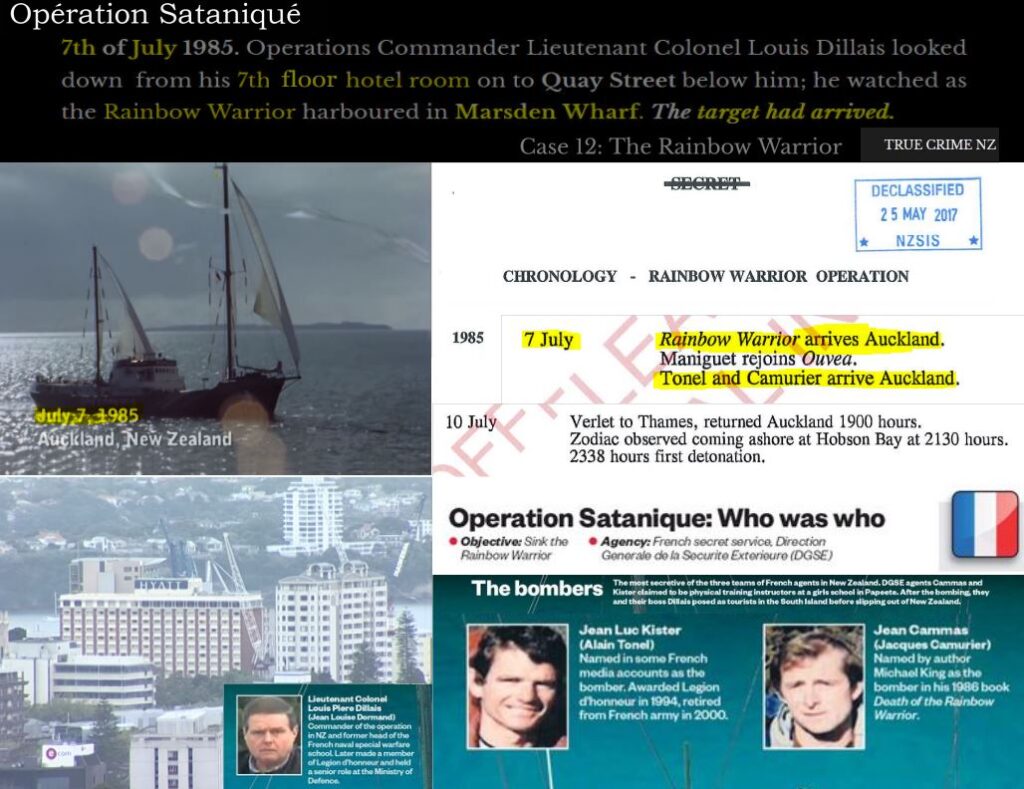
Or, Chouet comprehended the Deux Ex Machina mission objective. The darkest objective of Opération Sataniqué may have been to show New Zealand’s National Security State how to inflict a terrorist operation with numerous deaths, while brazenly leaving a trail of evidence and codifying the event to signal the hidden objectives.
After all, the reference to Hansel and Gretel is a curious one.
The defining feature of the trail of clues left by the French DGSE was that they appeared to be designed to be detectable, or what is known as an ‘orgie of evidence’ intended to frame a scape-goat.
In the Grimm Brothers’ Hansel and Gretel tale, Hansel and Gretel are a brother and sister abandoned in a German forest, where they fall into the hands of a witch who lives in a house made of gingerbread, cake, and pastries. Hansel leaves a trail of bread crumbs with the intention that they can find their way out of the forest, but these are eaten by hungry birds. The cannibalistic witch intends to fatten the children before eventually eating them, but Gretel outwits the witch. Gretel feigns ignorance about how to check if the oven is hot enough, and asks the witch to show her how, and when the witch demonstrates by leaning her head into the oven, Gretel shoves the oven door shut to cook the witch. The two children then escape with their lives and return home with the witch’s treasure of precious stones.

In other words, Hansel’s conscious attempt to leave a trail is foiled by native fauna feeding on the bread crumbs, and witch’s sinister plan is foiled by Gretel exploiting the psychic trait shared by all empathy-lacking psychopaths: narcissism.
Ironically, the ‘nosy New Zealanders’ who became the native fauna that fed on the French terrorists’ orgie of evidence bread crumbs, led to the unplanned capture of Major Mafart and Captain Prieur. When Newman’s office clerk, Rebecca Hayter, pretended to calculate times and dates for a refund upon the early return of the fake Swiss honey-mooning couple’s rented campervan, Hayter inadvertently stole the role of Gretel.
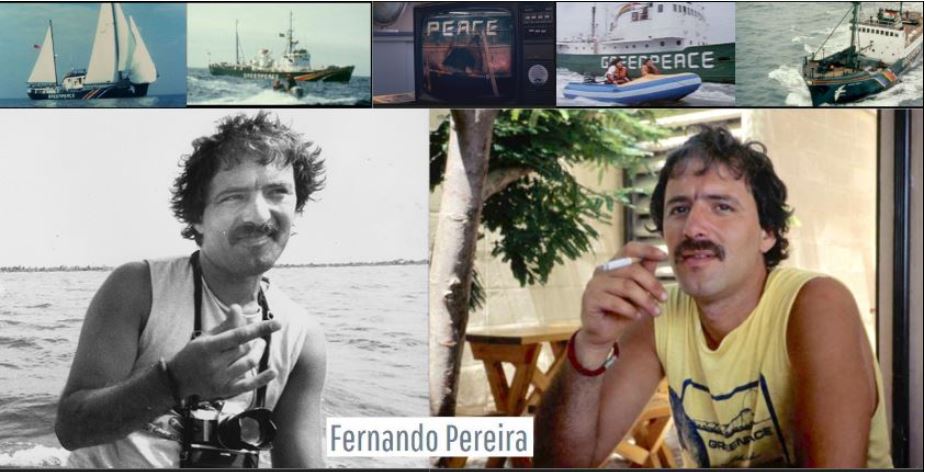
Perhaps, then, Operation Satanique really was intended as a “Show Me How” Ritual that riffed off the Hansel and Gretel tale to signal Gretel’s pretense of not understanding how to test the oven.
After all, the fact that the Rainbow Warrior Bombing occurred on the date of 10/7 — which was precisely 1 year, 3 months and 13 days after the ‘unsolved’ Wellington Trades Hall Bombing — adds weight to supposition that Operation Satanique was techno-sorcery. With both events, the people who survived said it was incredible that the bomb blasts did not kill more people. Therefore, I contend that one mission objective of Operation Satanique was to inflict a significant death toll with the intention to grab world headlines.
The sting to bust an alleged gun-running operation between New Zealand and New Caledonia was an obvious flimsy cover-story that MI6 would readily decode as a terror theater mission. The French DGSE planners embedded the Rainbow Warrior Bombing with the numeric call sign for “unit arrived at job” used by New Zealand Police, by timing the “sabotage mission” to occur on 10/7.
The French state continued to insist the bombing was a sabotage mission, after the ‘orgie of evidence’ led straight back to the DGSE, and Élysée Palace. Ironically, while the Lange Labour Government adopted a sanctimonious stance about French “saboteurs”, the Lange Administration was engaged in a strategic sabotage of industries.
The trail of clues — some left deliberately, some not — which led to the quick arrest of Mafart and Preiur worked to distract the radical political left of Labour Party from the economic shock treatments underway, and supply them with a cause célèbre and deliver Lange Labour Party back into power in 1987. Indeed, Geoffrey Palmer bragged at a retrospective talk in 2015 that Lange exploited the Rainbow Warrior Affair to distract the public and the media for some time.
The French Government’s relentless insistence that the mission objective was sabotage rather than terrorism, only fed the fire of the political left of Labour Party to focus on the nuclear issue.
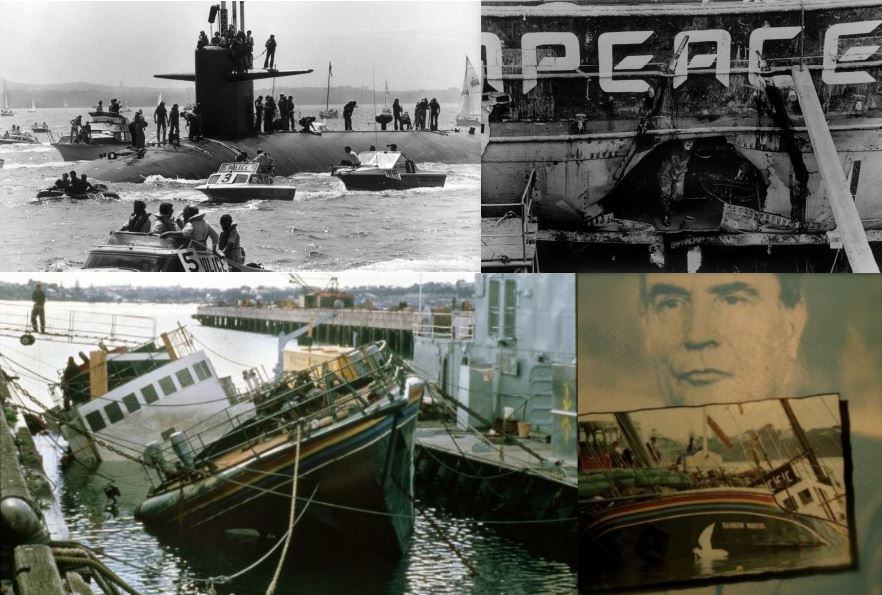
Lange’s Finance Minister Roger Douglas boasted at a private dinner in December 1986, that the idea behind the ‘free market’ reforms was to transform New Zealand into a ‘Switzerland of the South Pacific’. N.Z. would have a top strata of wealthy people and in 25 years most New Zealanders would not be able to afford to live in NZ., and that this agenda was driven from overseas, mostly from China he added.
Therefore, the primary target audience of this theater were Western élites, and not Greenpeace activists, nor New Zealanders in general.
Predictably, New Zealanders fell for the idea that the French were being characteristically arrogant in carrying out a ‘hastily organized’ operation. The ‘orgie of evidence’ embedded into events were designed to finger France.
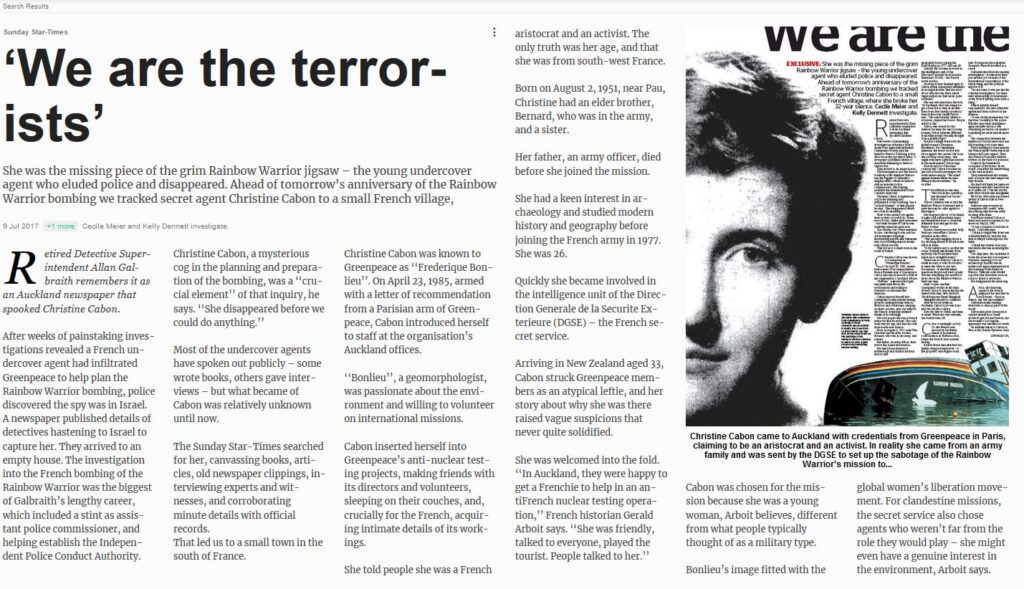
The ‘Morse Code’ embedded in the bombing of Greenpeace’s flagship seahorse communicated a sinister directive to Western élites to get their domestic grassroots movements — including anti-nuclear activists — back under control.
Or, there would be a ‘dearer price’ of power to pay — with occult encoded ritual terrorism.
Given the forgoing, it is intriguing to observe that in 1993, Buckingham Palace approved the Pegasus symbol to become the coat of arms for New Zealand’s Aviation Security Service, which was formed as part of the Civil Aviation Authority in 1977 — the same year as the GCSB and the Anti-Terrorism Squads.
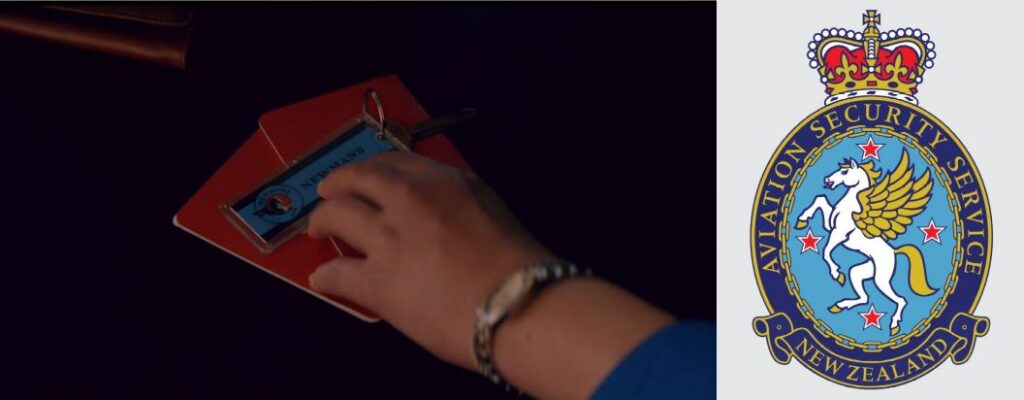
It would appear that New Zealand’s ‘celestial astrologers’ were communicating back to their Western Alliance counterparts that they had deciphered, appreciated and integrated the ‘Morse Code’ from the French DGSE, who had signalled with Opération Sataniqué that a deus ex machina plot device had been activated.
In spite of its terror-themed publication in the post-9/11 Universe, New Zealand’s Aviation Security Service (AVSEC) looked extremely shabby when its 40th Anniversary publication made no mention of the time that the two French DGSE combat divers gave them the slip at Auckland International Airport — 16 days after the Rainbow Warrior Bombing.
Especially, since the Rainbow Warrior Bombing was preceded by another act of terror which occurred precisely 1 year, 3 months and 13 days prior. New Zealand’s Aviation Security Service could be forgiven for missing the escape of an ex-Irish Republican Army (IRA) intelligence officer, who skipped the country to Perth in the immediate aftermath of the Wellington Trades Hall Bombing of March 27 1984. However, the Aviation Security Service’s failure in security in the aftermath of the Rainbow Warrior Bombing belies a cross-institutional state cover-up.
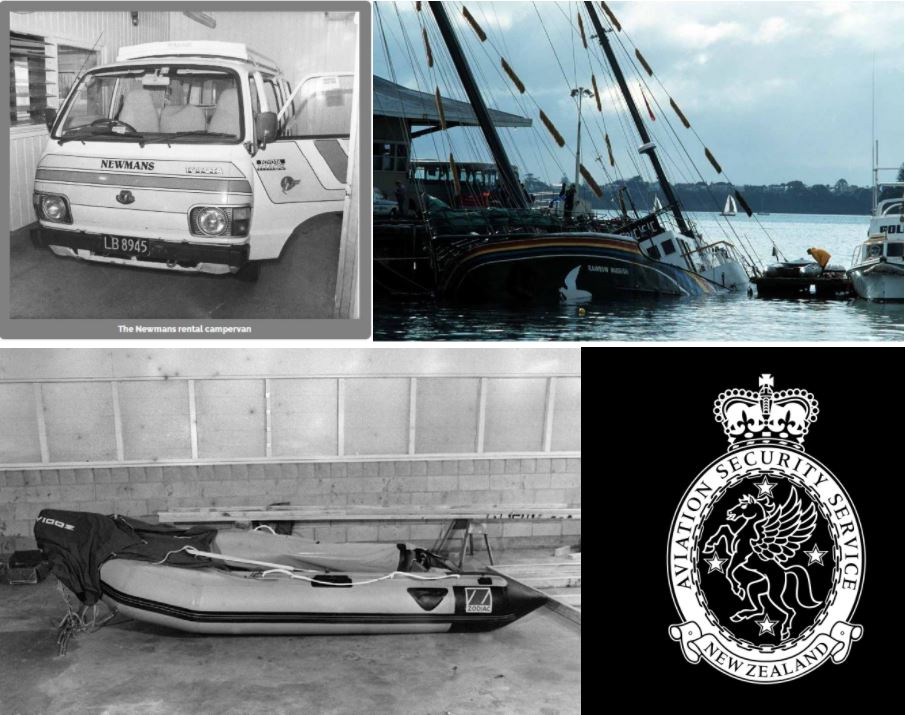
Ironically, Colonel Kister said in Episode 3 of the documentary, Murder in the Pacific, that he was nearly caught at the airport check-in counter when he was departing New Zealand on July 26 1985. He recalled that the young lady was suspicious about his passport, but her manager let him pass. Where was AVSEC?

Moreover, what was the Auckland, Wellington and Christchurch Anti-Terrorism Squads (ATS) doing in the aftermath? And what help — if any — did the Government Communications Security Bureau provide in relation to the presence of French spies in New Zealand?
Curiously, the three alphabet agencies — AVSEC, GSCB and ATS — were formed in 1977 amid the rise of international terrorism.
The Le Monde scooping reporter, Edwy Plenel, said there was no French parliamentary commission of inquiry.
Nor, was there a Royal Commission of inquiry in New Zealand, which could have revealed the damage control managed by the Officials Terrorism Committee, and others in the Beehive, including Lange.

The ‘Morse Code’ communicated a theme of accommodation, which had been scripted into ‘Opération Sataniqué’ such that New Zealand’s prime minister had accommodated the French DGSE agents’ clandestine activities — before and after the 10/7 bombing of the Rainbow Warrior.
The United Nations also adopted the same accommodating attitude toward state-sponsored terrorism that Western countries showed toward France in the aftermath — particularly the other Five Eyes Echelon Alliance nations, the United Kingdom, the United States, Australia and Canada.
Key Finding: The Rainbow Warrior Bombing worked as a Deus Ex Machina plot device to resolve a seemingly impossible political check-mate position. The alphanumeric code embedded in the bombing of Greenpeace’s flagship seahorse communicated a sinister directive to Western élites to get their domestic grassroots movements — including anti-nuclear activists — back under control.
In New Zealand, the bombing deflected the attention of left-wing activists away from the economic issues that followed the Rockefellerite-driven ‘silent coup’ of 1984, and re-focused their energy onto the nuclear issue, which became their cause célèbre.
The 10/7 Rainbow Warrior Bombing became the catalyzing event that delivered David Lange’s Labour Party back into power two years later, while the New Zealand Crown consolidated power and the United Nations recast itself as traffic cop, by issuing a $13 million maritime ticket for Western state-sponsored terrorism.
Opération Sataniqué worked as a strategy of tension with an innovative‘Trojan Seahorse’ twist, and came packaged with ironic weaponized metaphors encoded in the event, as well as the Nuclear Terror geo-political theater in the sub-plots. Opération Sataniqué worked as a strategy of tension with an innovative ‘Trojan Seahorse’ twist, and came packaged with ironic weaponized metaphors encoded in the event, as well as the Nuclear Terror geo-political theater in the sub-plots.
This key finding suggests that the meta-data of other terrorist operations, including false flags, sponsored by the Western Empire will also be loaded with such ‘Easter Eggs’, a ‘Murder by Numbers’ modus operandi and deceptive ‘Strategy of Tension’ objectives.
Steve Snoopman worked at indigenous broadcaster, Māori Television, for 14 years as an editor of news and current affairs. He forged his superpower to ‘Thunk Evil Without Being Evil’ while writing a thesis on the Global Financial Crisis. Upon quipping that Batman had failed to bust any Gotham banker balls — since his ass is owned by DC Comics — he consequently realised New Zealand needed a Snoopman.
Editor’s Note: If we have made any errors, please contact Steve ‘Snoopman’ Edwards with your counter-evidence. e: steveedwards108[at]protonmail.com
Steve Snoopman also posts on The Snoopman Files [at] https://stevesnoopman.substack.com/
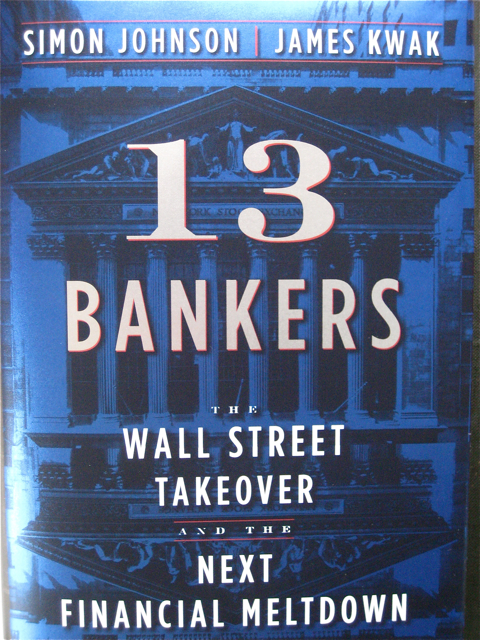
Related Investigations:
